By Sam Robinson |
at July 9, 2024 9:47 pm
Mark Davis expressed regret for not elevating Rich Bisaccia to the full-time head coach position in 2022. The owner, who remains tied to Jon Gruden‘s 10-year contract, signed off on paying three HCs last fall by firing Josh McDaniels. Antonio Pierce‘s better-than-expected showing as interim HC prompted Davis to take an unexplored route. The Raiders became the first team in seven years to bump an interim leader to the full-time post, and Pierce becomes one of the least experienced HCs in modern NFL history.
The former Super Bowl-winning linebacker’s promotion defined the Raiders’ offseason, one that also featured the Tom Telesco GM hire and a splashy Christian Wilkins signing. How the Raiders proceeded at quarterback came a close second in terms of offseason storylines. Between choosing Pierce and not taking a big swing for a QB, the Raiders took the road less traveled this offseason.
Coaching/front office:
Player support for Pierce reached the point Maxx Crosby threatened a trade request had Davis not broken with recent NFL tradition and elevated his interim HC. Josh Jacobs and Davante Adams also stumped for Pierce, who received interview requests from the Falcons and Titans. The Raiders made an early decision to pass on a true coaching searching, only interviewing two other candidates (Leslie Frazier and Kris Richard). The search process that ended with Pierce reminded of the plan that produced Gruden, with the team only clearing the Rooney Rule bar before choosing a coach. Pierce being Black, of course, separates this Raiders search from a typical Rooney Rule issue. But this still represents one of the most daring HC hires in decades.
Of the 160 men hired to be head coaches this century, only eight have moved up without previous NFL HC experience, at least one season as a coordinator (or time as a de facto coordinator, in the cases of coaching candidates under the title-phobic Bill Belichick) in the league or time as a college HC. Here is that list:
- Antonio Pierce, Raiders (2024)
- Jerod Mayo, Patriots (2024)
- Jim Tomsula, 49ers (2015)
- Mike Munchak, Titans (2011)
- Raheem Morris, Buccaneers (2009)
- Tom Cable, Raiders (2008)
- Mike Singletary, 49ers (2008)
- Lane Kiffin, Raiders (2007)
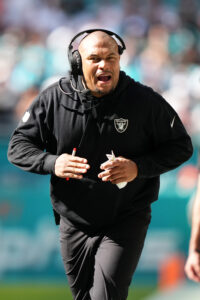 The Raiders had swerved off this route after Al Davis Cable’s interim tag, hiring veterans like Gruden, McDaniels and Jack Del Rio. Pierce went 5-4 as an interim HC, with the Raiders’ one-sided road win over the Chiefs beginning his charge in earnest for the full-time gig. Still, Pierce’s only full-time coaching positions are Raiders linebackers coach, Arizona State defensive coordinator, Sun Devils LBs coach and Long Beach Poly High HC.
The Raiders had swerved off this route after Al Davis Cable’s interim tag, hiring veterans like Gruden, McDaniels and Jack Del Rio. Pierce went 5-4 as an interim HC, with the Raiders’ one-sided road win over the Chiefs beginning his charge in earnest for the full-time gig. Still, Pierce’s only full-time coaching positions are Raiders linebackers coach, Arizona State defensive coordinator, Sun Devils LBs coach and Long Beach Poly High HC.
Although Pierce’s nine NFL seasons took up time, he did not enter full-time coaching for nearly five years after his retirement. He also resigned from Arizona State during an NCAA recruiting investigation, but the leadership the ex-Washington and New York linebacker displayed — along with his knowledge of the Raiders’ culture — impressed players and ownership.
Al Davis pulled the trigger on the Kiffin and Cable moves, but Mark Davis is still trying to make a successful hire. The Raiders have two playoff berths since Super Bowl XXXVII, with the franchise tumbling off the contender radar quickly after that blowout. Last season did bring signs of improvement, but teams generally steer clear of promoting interims. Mark Davis passing on a true HC search to keep Pierce based largely on his players’ wishes could represent another of the owner’s shortcomings, but this will be a fascinating experiment.
A report of mutual interest between the Raiders and Jim Harbaugh, who began his coaching career as Bill Callahan‘s QBs coach in 2002, surfaced but did not precede much else of note tying the team to a big-ticket candidate. The Raiders did reach out to Harbaugh’s agent, however, before the Pierce hire. Pierce, 45, and Harbaugh will soon be matching up twice a year. The Raiders did not pursue Mike Vrabel, and Belichick connections proved fleeting. They will hope to keep the Pierce-centered momentum going. The Jaguars (Doug Marrone) were the most recent team to take this route; Marrone lasted four seasons in the full-time chair.
 Interim GM Kelly sat in on Raiders HC interviews, but the Raiders were not committed to keeping Dave Ziegler‘s former assistant GM atop the front office. Davis instead chose to pair Pierce with one of the NFL’s most experienced GMs. Telesco spent 11 seasons running the Chargers, and although the team’s underachievement reputation grew to define it during this span, Davis was sufficiently impressed with the Bolts’ roster strength to look beyond their 3-for-11 playoff rate under Telesco. Not counting the Eagles having reinstalled Howie Roseman atop their FO pyramid, Telesco is only the second current GM to be given a second chance, joining Trent Baalke (Jaguars).
Interim GM Kelly sat in on Raiders HC interviews, but the Raiders were not committed to keeping Dave Ziegler‘s former assistant GM atop the front office. Davis instead chose to pair Pierce with one of the NFL’s most experienced GMs. Telesco spent 11 seasons running the Chargers, and although the team’s underachievement reputation grew to define it during this span, Davis was sufficiently impressed with the Bolts’ roster strength to look beyond their 3-for-11 playoff rate under Telesco. Not counting the Eagles having reinstalled Howie Roseman atop their FO pyramid, Telesco is only the second current GM to be given a second chance, joining Trent Baalke (Jaguars).
Telesco, 51, spent more than a decade working under Hall of Fame GM Bill Polian, being present for the Colts’ Super Bowl XLI win and their Super Bowl berth four years later. As Chargers GM, Telesco hammered out a Philip Rivers extension and later showed an ability to locate a franchise quarterback by drafting Justin Herbert sixth overall in 2020. The Chargers extended their Pro Bowl passer in Telesco’s final months on the job, but an inability to turn franchise QBs and offseason hype into Super Bowl pushes have plagued the Chargers for years.
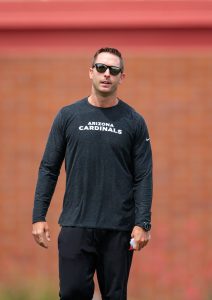 Pierce’s team walloping the Chargers 63-21 on national TV led to Telesco and Brandon Staley‘s ousters. It is, then, rather interesting Telesco resurfaced alongside Pierce in Las Vegas. The Raiders gave Telesco roster control, which he also held in California. Telesco brought former Chargers exec-turned-interim GM Wooden with him, but he is working primarily with two staffers — Pierce and Kelly — he did not hire. With Kelly having interviewed for the Raiders’ GM job in 2022 and ’24, this forced partnership will be a notable AFC West storyline.
Pierce’s team walloping the Chargers 63-21 on national TV led to Telesco and Brandon Staley‘s ousters. It is, then, rather interesting Telesco resurfaced alongside Pierce in Las Vegas. The Raiders gave Telesco roster control, which he also held in California. Telesco brought former Chargers exec-turned-interim GM Wooden with him, but he is working primarily with two staffers — Pierce and Kelly — he did not hire. With Kelly having interviewed for the Raiders’ GM job in 2022 and ’24, this forced partnership will be a notable AFC West storyline.
The Telesco-Pierce partnership hit an early snag when its top OC choice reneged on his commitment to join the Commanders. Kingsbury, who re-emerged as a coveted staffer after a year as USC’s QBs coach, was believed to have sought a three-year contract whereas the Raiders only offered a two-year deal. A report soon indicated new Commanders minority owner Magic Johnson helped sway Kingsbury. The Raiders then pivoted to Getsy, whom the Bears had fired weeks earlier.
Getsy, 40, has followed up a run as Aaron Rodgers‘ position coach to two gigs with below-average passers. The young coordinator certainly runs the risk of seeing his play-calling opportunities dry up early, but with many NFL OC gigs not coming with play-calling duties, Getsy has also managed to secure that role twice already.
The Bears ranked 23rd and 18th in scoring offense during Getsy’s two seasons in Illinois, numbers that appear out of line when considering Justin Fields‘ minimal trade value. Getsy took criticism for Fields’ struggles as a passer, but the ex-first-rounder showed some improvement in 2023. This came after Getsy utilized his starter’s prodigious run-game skills en route to Lamar Jackson‘s single-season QB rushing mark nearly falling in 2022.
 While Getsy will work with a different genre of QB in Las Vegas, Graham is staying after the Raiders finally showed promise defensively. Graham’s first Raiders defense continued an extended run of futility in 2022, but the unit ranked ninth in scoring last season. This was the first time a Raider defense has ranked in the top half in scoring defense since 2002. Ending that unfathomable streak boosted Graham’s stock, and while he drew more HC interest, the Raiders blocked their defensive play-caller from interviewing for other DC positions.
While Getsy will work with a different genre of QB in Las Vegas, Graham is staying after the Raiders finally showed promise defensively. Graham’s first Raiders defense continued an extended run of futility in 2022, but the unit ranked ninth in scoring last season. This was the first time a Raider defense has ranked in the top half in scoring defense since 2002. Ending that unfathomable streak boosted Graham’s stock, and while he drew more HC interest, the Raiders blocked their defensive play-caller from interviewing for other DC positions.
Pierce’s former Giants HC, Tom Coughlin, helped him prepare during his interim gig and assisted his former pupil in assembling his first Raiders staff. The staff includes Lewis, who returns to the NFL five years after his Bengals firing. Lewis, 65, worked as Arizona State’s co-DC with Pierce in 2020 and stayed on the Sun Devils’ staff as Pierce took on the full-time role in 2021.
The 16-year Bengals HC will work with Graham and Pierce on defense, while Philbin — and not ex-Raider HC Hue Jackson, a rumored target — is in place as a former NFL leader helping out on offense. These senior assistants could be more important on this particular staff due to Pierce’s inexperience.
Free agency additions:
- Christian Wilkins, DT. Four years, $110MM ($57.5MM guaranteed)
- Gardner Minshew, QB. Two years, $25MM ($15MM guaranteed)
- Harrison Bryant, TE. One year, $3.25MM ($2.88MM guaranteed)
- Alexander Mattison, RB. One year, $2MM ($1.65MM guaranteed)
- Cody Whitehair, G. One year, $2.5MM ($1.35MM guaranteed)
- Michael Gallup, WR. One year, $1.75MM ($828K guaranteed)
- Andrus Peat, OL. One year, $2MM ($450K guaranteed)
- Jalen Guyton, WR. One year, $1.29MM ($32K guaranteed)
Wilkins joined Chris Jones and Justin Madubuike as defensive tackles who scored market-changing deals this offseason, with the two more experienced players doing better due to unique circumstances. The Dolphins’ cap situation, which required multiple high-profile cuts and longtime starters departing in free agency, made a Wilkins franchise tag difficult. As a result, the five-year Miami starter followed Jones in scoring a monster guarantee.
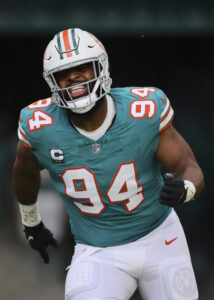 After it became clear the Dolphins’ efforts to keep Wilkins off the market would fail, the Texans and Vikings surfaced as suitors. But the Raiders swooped in to add an impact piece to their Crosby-centric pass rush. Madubuike already raised the DT guarantee ceiling to $75.5MM upon being franchise-tagged and extended. Jones upped it to a staggering $95MM. Wilkins then secured $82.75MM in total guarantees ($57.5MM at signing).
After it became clear the Dolphins’ efforts to keep Wilkins off the market would fail, the Texans and Vikings surfaced as suitors. But the Raiders swooped in to add an impact piece to their Crosby-centric pass rush. Madubuike already raised the DT guarantee ceiling to $75.5MM upon being franchise-tagged and extended. Jones upped it to a staggering $95MM. Wilkins then secured $82.75MM in total guarantees ($57.5MM at signing).
To put these numbers in perspective, the top DT guarantee stood at $66MM (Quinnen Williams) entering 2024. Jones and Wilkins avoiding the tag, as the salary cap spiked by $30.6MM, keyed a market shift that will affect future teams’ negotiations with talented DTs.
Months-long Dolphins-Wilkins talks included an offer that would have made the 2019 first-rounder a top-10 highest-paid DT, with guarantees surpassing $40MM. Wilkins’ Raiders pact surpassing $80MM guaranteed highlights both favorable circumstances and the Clemson alum’s improvement as a pass rusher.
The Dolphins were hesitant to pay Wilkins on the level of the new DT market that formed — via the 2023 deals for first-rounders Williams, Daron Payne, Jeffery Simmons and Dexter Lawrence — due to his limited production as a pass rusher. After displaying top-notch skills against the run, Wilkins broke through with nine sacks and 23 QB hits (his previous career-highs stood at 4.5 and 13 in these categories) in 2023. Wilkins finished 13th in ESPN’s pass rush win rate metric last season. This came after he ranked first and second, respectively, in run stop win rate in 2021 and ’22.
PFR’s No. 4 free agent, Wilkins saw Nos. 2 and 3 on that list (Baker Mayfield and Jones) cash in before the legal tampering period. Jones’ deal took an elite option off the market, clearing the runway for Wilkins’ windfall. The Raiders, who have kept costs low on their D-line for a bit, changed course and will aim for the 28-year-old DT changing the equation up front.
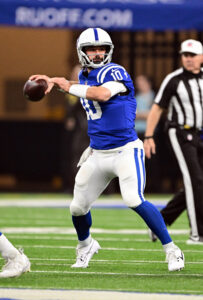 A herd of bridge- or backup-level quarterbacks hit free agency. As the Raiders acknowledged their miss on Jimmy Garoppolo, they made the biggest investment via Minshew’s $15MM. This contract rewards the spot starter after he took a $3.5MM deal to become insurance for the QB the Colts would draft. Indianapolis’ Anthony Richardson decision translated to 13 Minshew starts. The Colts went 7-6 in those games, coming close to a surprise AFC South title.
A herd of bridge- or backup-level quarterbacks hit free agency. As the Raiders acknowledged their miss on Jimmy Garoppolo, they made the biggest investment via Minshew’s $15MM. This contract rewards the spot starter after he took a $3.5MM deal to become insurance for the QB the Colts would draft. Indianapolis’ Anthony Richardson decision translated to 13 Minshew starts. The Colts went 7-6 in those games, coming close to a surprise AFC South title.
Minshew’s $15MM total guarantee topped the next-closest free agent QB (Sam Darnold) by more than $6MM, illustrating the market for the former Jaguars sixth-rounder. The Raiders gave Garoppolo $33.75MM guaranteed and dropped him after six starts. Minshew’s contract would generate a maximum of $7.6MM in dead money if dropped in 2025.
The Raiders agreeing to pay out Minshew’s 2025 base salary ($11.84MM) will depend on the competition between he and 2023 fourth-rounder Aidan O’Connell. With the Raiders’ primary 2023 starter believed to hold an early lead, Minshew will need to summon the moxie he showed in Jacksonville and Indianapolis.
Read more
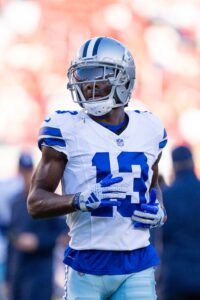 The winner between Minshew and O’Connell may end up as the bridge to a to-be-determined 2025 draftee. For now, O’Connell is up against a passer with 37 career starts and a 59-to-24 TD-to-INT ratio. That obviously does not tell the full story, as no team has seen Minshew as a potential long-term starter. But QBR did place the now-28-year-old passer 13th last season. O’Connell ranked 25th. Neither player impressed in terms of yards per attempt, with O’Connell at 6.5 and Minshew at 6.7.
The winner between Minshew and O’Connell may end up as the bridge to a to-be-determined 2025 draftee. For now, O’Connell is up against a passer with 37 career starts and a 59-to-24 TD-to-INT ratio. That obviously does not tell the full story, as no team has seen Minshew as a potential long-term starter. But QBR did place the now-28-year-old passer 13th last season. O’Connell ranked 25th. Neither player impressed in terms of yards per attempt, with O’Connell at 6.5 and Minshew at 6.7.
Unless O’Connell wins the job, the Raiders will turn to Minshew to help develop the likes of Michael Mayer and Brock Bowers. O’Connell, who will be 26 by Week 1, taking a step forward could complicate the Raiders’ expected 2025 QB search. Of course, that would be a good problem for a team that has seen instability define this position after nine years of Derek Carr.
Neither QB will need to worry about inexperience at wide receiver, with three veterans — Gallup, Adams, Jakobi Meyers — expected to play regular roles. The Cowboys cut Gallup two years into a five-year, $57.5MM extension; the former 1,100-yard target did not impress on his second Dallas deal. Already missing time due to injury in 2021, Gallup suffered an ACL tear late that season. Gallup posted his four-digit season before CeeDee Lamb‘s arrival but did amass 843 yards and five TDs in his final season before the injury. The Raiders will give the 28-year-old weapon, who has not surpassed 500 yards in a season since that 2020 campaign, a chance to work as an auxiliary piece in an expensive receiving crew.
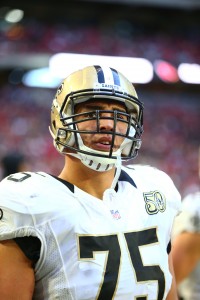 Whitehair and Peat will bring considerable experience to a Raiders front that carries questions into camp. An eight-year Bears starter at guard and center, Whitehair has 118 starts on his resume. Set to turn 32 this week, Whitehair ranked as a bottom-10 guard in the view of Pro Football Focus last season. The former second-round pick graded in the top 30 in 2022, however.
Whitehair and Peat will bring considerable experience to a Raiders front that carries questions into camp. An eight-year Bears starter at guard and center, Whitehair has 118 starts on his resume. Set to turn 32 this week, Whitehair ranked as a bottom-10 guard in the view of Pro Football Focus last season. The former second-round pick graded in the top 30 in 2022, however.
Peat, 31, slid from his longtime LG post to left tackle as the Saints soured on Trevor Penning early last season. PFF graded Peat as a bottom-10 guard in 2022, but he enjoyed a productive Saints tenure by making 102 starts and appearing in three Pro Bowls.
The former first-round pick, who has three Pro Bowls on his resume, joined Whitehair in not generating much interest following an offseason release. Peat worked as Las Vegas’ LT in place of a rehabbing Kolton Miller, who is expected to be recovered from his shoulder surgery by Week 1. Whitehair saw first-unit time at LG. Neither may be a starter in Week 1, but combining for 17 years of experience, the 30-somethings loom as interesting insurance options on low-cost deals.
Re-signings:
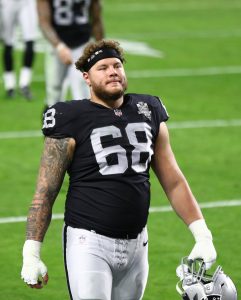 This is already James’ third Raiders contract. The team was confident enough in the 2019 UDFA replacing Rodney Hudson in 2021 it authorized an early extension shortly after trading the Pro Bowler to the Cardinals. James has started 48 games since and secured better terms this year as a result.
This is already James’ third Raiders contract. The team was confident enough in the 2019 UDFA replacing Rodney Hudson in 2021 it authorized an early extension shortly after trading the Pro Bowler to the Cardinals. James has started 48 games since and secured better terms this year as a result.
PFR’s No. 31 overall free agent, James signed for more in terms of AAV and guarantees than any 2023 free agent center. While Lloyd Cushenberry beat him out among this year’s FA group, the fourth-year Vegas starter is now the NFL’s sixth-highest-paid snapper.
ESPN’s pass block win rate metric heaped praise on James’ 2023 season, ranking him third among all interior O-linemen. PFF slotted the UCLA alum as the NFL’s ninth-best center. The team’s new regime indeed viewed the Mike Mayock-era find as a keeper, and James provides stability for an O-line that is expected to feature both new starters and position changes.
Notable losses:
- Brandon Bolden, RB
- DeAndre Carter, WR
- Jermaine Eluemunor, OL
- Jimmy Garoppolo, QB (post-June 1 cut)
- Hroniss Grasu, OL
- Tyler Hall, CB
- Austin Hooper, TE
- Brian Hoyer, QB (released)
- Josh Jacobs, RB
- Bilal Nichols, DL
- Brandon Parker, T
- Hunter Renfrow, WR (post-June 1 cut)
- Amik Robertson, CB
- Jerry Tillery, DT (released)
- Greg Van Roten, G
 Conflicting reports came out about the Raiders’ efforts to extend Jacobs at the July 2023 franchise tag deadline, but the 2022 rushing champ had backed Pierce’s HC bid this offseason. This Raider regime showed interest in keeping the Gruden-era first-rounder, but a postmortem indicated the Packers’ four-year, $48MM deal far surpassed the Silver and Black’s offer. Jacobs went on to say he never spoke directly with Telesco before free agency, wrapping a five-year partnership that featured four play-callers.
Conflicting reports came out about the Raiders’ efforts to extend Jacobs at the July 2023 franchise tag deadline, but the 2022 rushing champ had backed Pierce’s HC bid this offseason. This Raider regime showed interest in keeping the Gruden-era first-rounder, but a postmortem indicated the Packers’ four-year, $48MM deal far surpassed the Silver and Black’s offer. Jacobs went on to say he never spoke directly with Telesco before free agency, wrapping a five-year partnership that featured four play-callers.
This year’s frenzied RB carousel stopped without the Raiders adding a starter-level back, though Mattison — the Vikings’ primary 2023 starter — is expected to back up Zamir White. Jacobs joined Mattison, Saquon Barkley, Austin Ekeler, Derrick Henry, Tony Pollard, Joe Mixon, Aaron Jones, D’Andre Swift and Devin Singletary as 2023 starters to change teams in March.
Despite Ekeler-Chargers extension talks going nowhere last year and a trade request producing a modest incentive package, Telesco was believed to have considered reuniting with his Bolts UDFA find. But the elusive back ended up in Washington hours after Jacobs’ Green Bay commitment.
Jacobs, 26, had expressed interest in remaining a Raider. The team made the rare move to bump his franchise tag pay to $11.8MM — from its $10.1MM place — after the Alabama alum had become the first Raider rushing champion since Marcus Allen. Ziegler is believed to have offered a $12MM-per-year deal before the July 2023 deadline. Jacobs matched that with the Packers, though the old-school franchise only guaranteed him $12.5MM at signing. Jacobs’ contract gives him a good chance of remaining on Green Bay’s roster for at least two seasons, however. That will match up with White’s rookie deal, as the Raiders evaluate whether the 2022 fourth-rounder — a late-season Jacobs injury replacement — can handle the gig.
 The Raiders did not see Jacobs match his dominant 2022 output; he averaged 61.9 rushing yards per game compared to 97.2 during the All-Pro season. Jacobs also battled injuries during his Raiders tenure, one that concluded with four missed games due to multiple contusions. The Raiders will pivot from a player they gave 1,502 touches (sixth-most among active RBs) to White, who enters the season with 136.
The Raiders did not see Jacobs match his dominant 2022 output; he averaged 61.9 rushing yards per game compared to 97.2 during the All-Pro season. Jacobs also battled injuries during his Raiders tenure, one that concluded with four missed games due to multiple contusions. The Raiders will pivot from a player they gave 1,502 touches (sixth-most among active RBs) to White, who enters the season with 136.
Concerns about Garoppolo’s injury past and Kyle Shanahan‘s impact on his play proved justified early in his Raiders run, as the team benched him immediately after McDaniels’ firing. Garoppolo had undergone offseason foot surgery, which produced news of an injury waiver that did not surface until months later, and missed two games for unrelated injuries. Garoppolo played poorly, representing a misstep from the ex-Patriot decision-makers who greenlit the reunion.
The Garoppolo ouster cost the Raiders more than $17MM in dead money, a number reduced because of a two-game PED ban the 10-year veteran incurred this offseason. Las Vegas will take on the lion’s share of that dead cap hit in 2025; Garoppolo counts just $4.3MM on the team’s 2024 payroll. Pricier QB mistakes occurred in the AFC West in recent years, though the three-year, $72.75MM deal the Ziegler-McDaniels duo authorized for Garoppolo reflected poorly on a regime that made a few personnel mistakes.
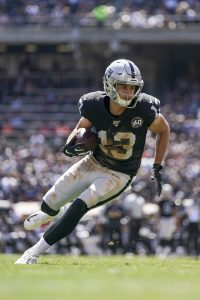 After the previous power brokers’ refusal to pick up any remaining Hunter Renfrow 2023 salary to facilitate a deadline trade, Telesco dropped the disappointing slot player. Renfrow fell out of favor in McDaniels’ offense shortly after the Raiders gave him a two-year, $32MM extension. This strange development took a player who had totaled 1,038 receiving yards to lead the 2021 playoff-bound team into a cog who barely factored into the past two Raiders offenses. Telesco made a last-ditch attempt to trade the five-year veteran — he of 585 yards between 2022 and ’23 — but nothing transpired. Renfrow remains unsigned.
After the previous power brokers’ refusal to pick up any remaining Hunter Renfrow 2023 salary to facilitate a deadline trade, Telesco dropped the disappointing slot player. Renfrow fell out of favor in McDaniels’ offense shortly after the Raiders gave him a two-year, $32MM extension. This strange development took a player who had totaled 1,038 receiving yards to lead the 2021 playoff-bound team into a cog who barely factored into the past two Raiders offenses. Telesco made a last-ditch attempt to trade the five-year veteran — he of 585 yards between 2022 and ’23 — but nothing transpired. Renfrow remains unsigned.
Another Gruden-Mayock-era find, Eluemunor loomed as a player the Raiders wanted to retain. They had signed the veteran O-lineman to one-year deals from 2021-23, the last of which for $3MM. The Giants blew that out of the water, giving the recent Raider RT a two-year, $14MM accord. PFF graded Eluemunor 35th among tackles last season; the ex-Ravens draftee gave the Raiders some cover for their Alex Leatherwood whiff. Thayer Munford, a 2022 seventh-rounder who pushed Eluemunor during training camp last year, is on track to replace him on the right edge.
Draft:
- Round 1, No. 13: Brock Bowers (TE, Georgia) (signed)
- Round 2, No. 44: Jackson Powers-Johnson (OL, Oregon) (signed)
- Round 3, No. 77: Delmar Glaze (T, Maryland) (signed)
- Round 4, No. 112: Decamerion Richardson (CB, Mississippi State) (signed)
- Round 5, No. 148: Tommy Eichenberg (LB, Ohio State) (signed)
- Round 6, No. 208 (from Chiefs): Dylan Laube (RB, New Hampshire) (signed)
- Round 7, No. 223 (from Patriots): Trey Taylor (S, Air Force) (signed)
- Round 7, No. 229 (from Vikings): M.J. Devonshire (CB, Pitt) (signed)
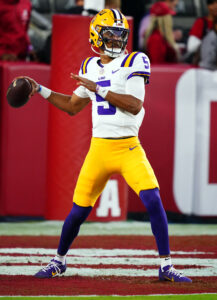 The Raiders signed Minshew as insurance in the event the team did not draft a quarterback. That protection measure ended up being necessary once this draft’s top six passers went off the board in the first 12 picks. This did not go down without a substantial Raiders effort, however, as the team once again conducted a thorough QB research project only to leave a first round without one.
The Raiders signed Minshew as insurance in the event the team did not draft a quarterback. That protection measure ended up being necessary once this draft’s top six passers went off the board in the first 12 picks. This did not go down without a substantial Raiders effort, however, as the team once again conducted a thorough QB research project only to leave a first round without one.
Pierce’s Jack Jones past produced a second chance; his Arizona State employment led to a spree of rumors surrounding what would have been a monster trade-up effort. Raiders-Jayden Daniels connections emerged by early February, after the ex-Sun Devils recruit had spent time with the team to support Pierce in Week 18.
The 2023 Heisman winner wanted to be a Raider, but draft rules being what they are, the Commanders’ 4-13 season put them in prime position to pounce after the Bears’ Caleb Williams choice. The Raiders met with Daniels, along with the other four non-Williams first-round arms in this class, but were hesitant — or undecided — on pulling the trigger to trade up for one of them.
A pre-draft report indicated Pierce advocated for a trade-up move while Telesco was fine standing down and retaining assets. After all, the Raiders made several first-round blunders under Gruden and then traded first- and second-rounders for Adams to start McDaniels’ tenure. The Raiders looked into Michael Penix Jr., viewing him as a Daniels consolation prize of sorts. But their evaluation of the Washington southpaw did not produce a consensus strong enough to warrant a trade into the top 10. Breaking with the Falcons’ evaluation, the Raiders only sought Penix in a trade-down maneuver.
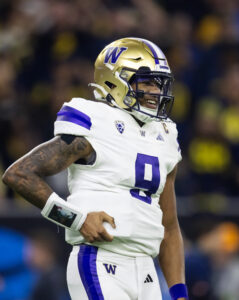 The Raiders appeared to make an offer for No. 2 overall, with new Commanders GM Adam Peters — a Vegas interviewee — confirming one team did send a proposal. Given the Pierce-Daniels ties becoming a central pre-draft storyline, it is fairly safe to assume the Raiders made the offer. Mark Davis OK’d a trade-up, and the Raiders also discussed terms with the Cardinals (No. 4) and Chargers (No. 5). Ultimately, Las Vegas was left out. The Falcons, Vikings and Broncos scooped up the final three remaining QBs between Nos. 8 and 12, leaving the Raiders to regroup around a best-player-available strategy.
The Raiders appeared to make an offer for No. 2 overall, with new Commanders GM Adam Peters — a Vegas interviewee — confirming one team did send a proposal. Given the Pierce-Daniels ties becoming a central pre-draft storyline, it is fairly safe to assume the Raiders made the offer. Mark Davis OK’d a trade-up, and the Raiders also discussed terms with the Cardinals (No. 4) and Chargers (No. 5). Ultimately, Las Vegas was left out. The Falcons, Vikings and Broncos scooped up the final three remaining QBs between Nos. 8 and 12, leaving the Raiders to regroup around a best-player-available strategy.
This year’s run of QBs in the top 12 left the consensus top tight end available at 13. The Raiders adding Bowers a year after trading up in Round 2 for Mayer will generate some challenges, in this receiver-heavy era, of deploying both. Bowers having a better receiving profile coming out of college, compared to Mayer operating as a more traditional tight end, would open the door to interesting 12 personnel wrinkles. This will be a challenge for Getsy, but Bowers does provide Minshew (and/or O’Connell) with a unique weapon.
Pierce denied Terrion Arnold‘s assertion the Raiders flipped a coin between he and Bowers, as that would be rather insane even considering Vegas’ apparent CB need. Bowers towered over this year’s TE prospects, being Georgia’s go-to pass catcher — a rare status in modern college football — in each of his three seasons in Athens. The dynamic pass catcher averaged at least 15 yards per reception in 2021 and ’22 and was on pace to surpass 1,000 yards last season, seeing an ankle injury slow him.
 Bowers caught 26 TD passes in three seasons, despite missing four games in 2023. He will be a building-block player for a Raiders team figures to be in on the 2025 QB class. With each of Las Vegas’ top three wideouts on veteran contracts, the team’s two tight ends will be in line to team with a to-be-determined QB addition in the long term.
Bowers caught 26 TD passes in three seasons, despite missing four games in 2023. He will be a building-block player for a Raiders team figures to be in on the 2025 QB class. With each of Las Vegas’ top three wideouts on veteran contracts, the team’s two tight ends will be in line to team with a to-be-determined QB addition in the long term.
Powers-Johnson and Glaze will vie for jobs during training camp, with the former more likely to wind up a 2024 starter. A one-year center starter at Oregon, Powers-Johnson is expected to play guard in Vegas. The Raiders, however, saw their second-round pick miss most of the offseason program due to an undisclosed injury. While Powers-Johnson may well be the team’s starting left guard — as two-year LG Dylan Parham is now at right guard — he will likely have some ground to cover once pads come on.
Beating out Whitehair may be a difficult task after Powers-Johnson — last year’s Rimington Award winner — missed on-field offseason work and will be attempting to change positions. Glaze, who played full college seasons at both right and left tackle, has worked as Munford’s RT backup thus far.
Extensions and restructures:
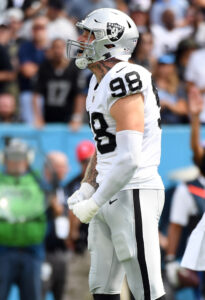 Easily the best move of Gruden’s second Raiders tenure, Crosby has become one of the NFL’s premier pass rushers. The 2019 fourth-rounder out of Eastern Michigan has never missed a game, and he led the league in tackles for loss in each of the past two seasons. Crosby has done his best work since signing a four-year, $94MM extension, a deal that commenced early in the McDaniels-Ziegler regime’s tenure. The edge rusher market has moved since, with less accomplished rushers surpassing him.
Easily the best move of Gruden’s second Raiders tenure, Crosby has become one of the NFL’s premier pass rushers. The 2019 fourth-rounder out of Eastern Michigan has never missed a game, and he led the league in tackles for loss in each of the past two seasons. Crosby has done his best work since signing a four-year, $94MM extension, a deal that commenced early in the McDaniels-Ziegler regime’s tenure. The edge rusher market has moved since, with less accomplished rushers surpassing him.
While the Raiders may be hesitant to extend Crosby with three years left on his contract, they rewarded him by moving money around within his deal. The team gave its top defender a $6MM raise for 2024 and moved $1.2MM in additional funds into 2025. This stripped some money from Crosby’s 2026 salary, but if he continues on his present path, it is highly unlikely the former mid-major talent remains on this contract by then.
Crosby’s deal now carries cap numbers of $30.5MM (2024) and $28.2MM (’25); no guaranteed salary is present next year. Bradley Chubb, Rashan Gary, Montez Sweat, Brian Burns and Joshua Hines-Allen have passed Crosby’s $23.5MM AAV, but the impact defender is not planning a power play for a better deal immediately. Crosby wants to remain with the Raiders throughout his career.
Other:
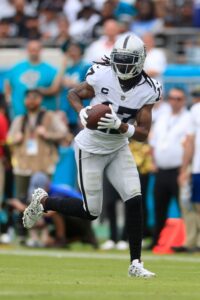 A year after insisting Keenan Allen was not available in his final Combine as Chargers GM, Telesco said Adams would be a Raider in 2024. The Raiders have received trade inquiries on the All-Pro wideout since before the 2023 deadline, and while they resisted, the three-time first-team All-Pro would stand to bring back a solid return for a team that could not do much with early-round draft choices from 2018-22. That has weakened Las Vegas’ roster, and our most recent Trade Rumors Front Office piece highlighted the events that have made Adams an ill-fitting piece for a team that does not appear to have its long-term QB in place.
A year after insisting Keenan Allen was not available in his final Combine as Chargers GM, Telesco said Adams would be a Raider in 2024. The Raiders have received trade inquiries on the All-Pro wideout since before the 2023 deadline, and while they resisted, the three-time first-team All-Pro would stand to bring back a solid return for a team that could not do much with early-round draft choices from 2018-22. That has weakened Las Vegas’ roster, and our most recent Trade Rumors Front Office piece highlighted the events that have made Adams an ill-fitting piece for a team that does not appear to have its long-term QB in place.
The team may or may not have set an unrealistic asking price on the 11th-year wideout, as a two-first-rounder cost surfaced in February. For his part, Adams has said he wants to stay, and Davis is interested in pairing Adams with the team’s next long-term QB. Of course, that rumor emerged before a draft that did not bring a passer back to Vegas. Will the Raiders reassess their Adams stance before this year’s deadline as a result?
The Brady holding pattern persists, with a few owners’ meetings coming and going without a vote being cast. The legendary QB-turned-FOX analyst is still more likely than not to eventually end up a Raiders part-owner, but clubs are understandably concerned about a conflict of interest. Roger Goodell went as far to say a Brady policy would need to be adopted regarding his access to team facilities as he prepares for broadcast assignments.
Top 10 cap charges for 2024:
- Maxx Crosby, OLB: $30.48MM
- Davante Adams, WR: $25.35MM
- Kolton Miller, LT: $15.68MM
- Christian Wilkins, DT: $10.3MM
- Jakobi Meyers, WR: $9.48MM
- Gardner Minshew, QB: $8MM
- Marcus Epps, WR: $7.29MM
- Andre James, C: $6.29MM
- Tyree Wilson, DL: $5.68MM
- Robert Spillane, LB: $5.3MM
This appears a full-on transition season for the Raiders, who may be biding their time ahead of a pivotal 2025 offseason. After Pierce’s reported interest in acquiring a long-term quarterback hopeful this year, steady QB rumors figure to flood Raiders news cycles in the coming months. For now, Pierce takes center stage after an unusual ascent to an NFL HC job. He is now in a division with Harbaugh, Andy Reid and Sean Payton. Although the clock on Pierce and Telesco may not start until the Raiders make their QB move, this will be a fascinating debut.
By Sam Robinson |
at July 5, 2024 10:39 pm
Kwesi Adofo-Mensah had gone two seasons with the quarterback his predecessor signed, but after Kirk Cousins‘ fourth set of Vikings extension talks did not produce a deal in 2023, the current Minnesota GM finally cut the cord. Cousins’ departure headlined an eventful Vikings offseason, one that later included a market-setting wide receiver contract.
As the Vikings transition at quarterback, they will use some of the money freed up by Cousins’ departure — following a not insignificant dead money total stemming from void years — on one of their Rick Spielman-era acquisitions. While Minnesota’s offseason featured notable moves at several positions, the decisions made at quarterback and wideout defined it.
Extensions and restructures:
Negotiations between the Vikings and Jefferson ran up to Week 1 last year. At that point, no team in the fifth-year option era (2011-present) had extended a first-round wide receiver with two years of rookie-deal control remaining. Jefferson and CeeDee Lamb were in that boat last year, and while extension rumors surfaced, no deals came to pass. The Vikings submitted an offer worth more than $28MM per year before the 2023 season started. With that proposal not topping Tyreek Hill‘s position-record AAV number, Jefferson predictably declined to set the stage for a 2024 reconvening. The superstar wideout was proven right by waiting.
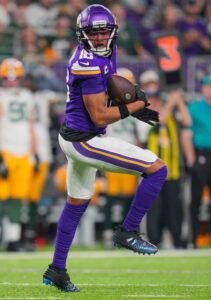 Even though Jefferson sustained a hamstring injury that sidelined him for seven games, he still managed a 1,000-yard season. Jefferson, 25, had already shattered Randy Moss‘ NFL record for receiving yardage through three seasons, accumulating 4,825. Jefferson’s age, his monster production, the Vikings moving off a proven QB’s contract and the receiver market shifting — following a record cap spike — beyond the $30MM place worked in the fifth-year pass catcher’s favor. Jefferson secured whopping terms and returned to work to begin establishing a rapport with Sam Darnold and J.J. McCarthy.
Even though Jefferson sustained a hamstring injury that sidelined him for seven games, he still managed a 1,000-yard season. Jefferson, 25, had already shattered Randy Moss‘ NFL record for receiving yardage through three seasons, accumulating 4,825. Jefferson’s age, his monster production, the Vikings moving off a proven QB’s contract and the receiver market shifting — following a record cap spike — beyond the $30MM place worked in the fifth-year pass catcher’s favor. Jefferson secured whopping terms and returned to work to begin establishing a rapport with Sam Darnold and J.J. McCarthy.
Skipping the start of Vikings OTAs in an effort to become the NFL’s highest-paid non-quarterback, Jefferson succeeded by passing Nick Bosa‘s $34MM-per-year contract. Also possessing leverage stemming from the Vikings’ natural interest in having their top player at workouts to begin training alongside its new QBs, the LSU alum pounced. Jefferson secured record-smashing guarantee figures, prevented the Vikings from backloading his deal the way Hill and Davante Adams‘ contracts are structured and managed this on a four-year agreement — one shorter than the Vikes initially sought.
The fifth wide receiver chosen in a memorable 2020 first round, Jefferson has set guarantee bars that are complicating the Cowboys and 49ers’ negotiations with their 2020 first-round wideouts. His total guarantees ($110MM) checked in $26MM north of A.J. Brown‘s new mark at the position. More importantly, the full guarantees ($88.7MM) are $36MM higher than the next-closest wideout. The WR investment business is booming, and the guarantees the Vikings authorized may give teams pause.
Rumblings about teams considering two-first-rounder trade offers for Jefferson emerged, with the Vikings loosely linked to a trade-up for LSU’s Malik Nabers. Little in terms of concrete info — unlike the Vikes and Giants’ Drake Maye trade-up offers — came out, however. No wide receiver has fetched two first-round picks in a trade since the 2000 offseason saw it happen twice — for Joey Galloway (Seahawks to Cowboys) and Keyshawn Johnson (Jets to Buccaneers) — but after Hill and Adams fetched first- and second-round picks in 2022 swaps, Jefferson’s age and the exploding WR market would have made him a clear candidate to end this drought.
The Vikings have a history of extending receivers and then trading them, having taken this route with Moss (2005) and Stefon Diggs (2020). Minnesota also unloaded Percy Harvin (2013) rather than extend him, but the Adofo-Mensah regime finished the Jefferson process with a commitment.
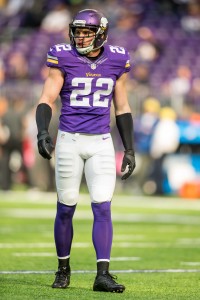 As it stands, the Vikings will pair Jefferson’s megadeal with McCarthy and Jordan Addison‘s rookie contracts. Although Minnesota now has the NFL’s highest-paid wide receiver and tight end (T.J. Hockenson), getting off Cousins’ contract will help the club afford the market-setting accords.
As it stands, the Vikings will pair Jefferson’s megadeal with McCarthy and Jordan Addison‘s rookie contracts. Although Minnesota now has the NFL’s highest-paid wide receiver and tight end (T.J. Hockenson), getting off Cousins’ contract will help the club afford the market-setting accords.
For a second straight year, the Vikings gave Smith a pay cut. The safety market’s inconsistency over the past two offseasons has impacted accomplished veterans. Smith signed two extensions that placed him atop the position’s market — in 2016 and 2021 — but Adofo-Mensah has led the way in back-to-back contract reworkings.
Smith, 35, is the Vikings’ longest-tenured player by a wide margin. He had agreed to a four-year, $64MM extension in August 2021, but after a 2022 restructure, the veteran Pro Bowler agreed to a $7MM pay cut in 2023 and again reduced his deal in March. Smith’s 2021 extension ran through 2025; it now expires a year early, via void years which have become a thorny subject during the Adofo-Mensah regime. Smith reduced a $15.3MM base salary to $9MM, with a $7MM signing bonus representing a solid guarantee for a 13th-year veteran at an unstable position.
Pro Football Focus ranked Smith, whose 176 career games are tied for fifth among defenders in Vikings history, 34th among safeties last season. If Smith is not re-signed before the 2025 league year, the Vikings will be tagged with $9.5MM in dead money. This would remind of Dalvin Tomlinson‘s 2023 exit.
Free agency additions:
- Jonathan Greenard, OLB. Four years, $76MM ($38MM guaranteed)
- Andrew Van Ginkel, LB. Two years, $20MM ($10MM guaranteed)
- Blake Cashman, ILB. Three years, $22.5MM ($9.48MM guaranteed)
- Sam Darnold, QB. One year, $10MM ($8.75MM guaranteed)
- Aaron Jones, RB. One year, $7MM ($7MM guaranteed)
- Shaquill Griffin, CB. One year, $4.55MM ($3.99MM guaranteed)
- Jerry Tillery, DL. One year, $2.75MM ($1.47MM guaranteed)
- Dan Feeney, OL. One year, $1.8MM ($1.38MM guaranteed)
- Trent Sherfield, WR. One year, $1.79MM ($1MM guaranteed)
- Jihad Ward, DL. One year, $1.79MM ($1MM guaranteed)
- Jonah Williams, DL. One year, $1.5MM ($350K guaranteed)
- Robert Tonyan, TE. One year, $1.13MM ($150K guaranteed)
- Kamu Grugier-Hill, LB. One year, $1.38MM ($143K guaranteed)
Not traded for one another, Greenard and Danielle Hunter — PFR’s Nos. 5 and 6 free agents this year — will nevertheless move into each other’s 2023 roles. The Vikings added Greenard early in free agency, doing so before Hunter committed to the Texans. Minnesota showed interest in Bryce Huff but paid more for Greenard. The new Vikings edge rusher’s age (27) works in his favor; he is three years younger than Hunter. The latter has delivered better work, but the Vikings are betting on Greenard’s best NFL stretch being ahead.
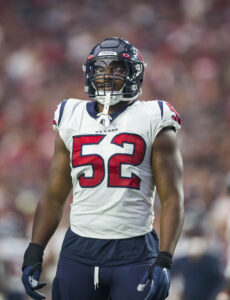 Drafted in Round 3 before Nick Caserio took over as GM, Greenard excelled under both Lovie Smith and then DeMeco Ryans. Greenard had tallied an eight-sack season (in 2021) before an injury-plagued 2022 stalled his early-career momentum. Last season brought new production territory. Ranking 20th with 33 quarterback pressures, Greenard led the Texans in sacks (12.5) despite Will Anderson Jr. winning Defensive Rookie of the Year acclaim and smashed his career-high with 22 QB hits. Greenard ranked sixth among edge rushers in ESPN’s pass rush win rate metric in 2023.
Drafted in Round 3 before Nick Caserio took over as GM, Greenard excelled under both Lovie Smith and then DeMeco Ryans. Greenard had tallied an eight-sack season (in 2021) before an injury-plagued 2022 stalled his early-career momentum. Last season brought new production territory. Ranking 20th with 33 quarterback pressures, Greenard led the Texans in sacks (12.5) despite Will Anderson Jr. winning Defensive Rookie of the Year acclaim and smashed his career-high with 22 QB hits. Greenard ranked sixth among edge rushers in ESPN’s pass rush win rate metric in 2023.
Starting over at OLB, the Vikings need this pace to continue. They still managed to land a 27-year-old edge defender at an upper-mid-market rate. Greenard’s $19MM AAV ranks 15th among edges, though his $38MM guarantee at signing sits eighth. He could certainly reward the Vikings on this deal, especially as the pass rush market — likely via Micah Parsons and a third Myles Garrett contract — moves toward $40MM per year.
A year after moving off the Dalvin Cook contract, the Vikings made a short-term bet on another 2017 RB draftee. Jones does not have the rushing numbers Cook compiled in Minneapolis, but the seven-year Packer is a slightly better receiving option who certainly showed more gas in the tank last season. The Vikings are quite familiar with the versatile back, who closed last season with five straight 100-yard rushing games to propel the Pack to the divisional round, and their interest emerged soon after Green Bay cut bait.
The Packers added a younger back (Josh Jacobs) but one that has not shown what Jones has as an outlet option. After reducing Jones’ pay in 2023, the Packers aimed to cut his wages once again. The sides could not agree on common ground, and the team dropped Jones shortly after the Jacobs deal was finalized. Jones’ Vikings guarantee surpasses Alexander Mattison‘s 2023 number, though not by too much, as the Vikes have one of this era’s best RBs at a midlevel rate.
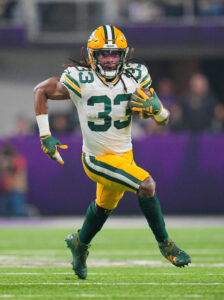 The team will bet on the aging (by RB standards) talent having juice left. The 1-A back in timeshares with Jamaal Williams and AJ Dillon in his career, Jones has logged 1,449 career touches. That ranks ninth among active RBs, though the number is close to where Cook’s count stood (1,503) when the Vikings dropped him.
The team will bet on the aging (by RB standards) talent having juice left. The 1-A back in timeshares with Jamaal Williams and AJ Dillon in his career, Jones has logged 1,449 career touches. That ranks ninth among active RBs, though the number is close to where Cook’s count stood (1,503) when the Vikings dropped him.
Jones rounds out an impressive skill-position cadre that includes Jefferson, Addison and Hockenson. This array of weaponry will be available to McCarthy in the long term, but it also could represent (by far) the best options Darnold has worked with as a pro. Brock Purdy enjoyed the 49ers’ unmatched arsenal during Darnold’s San Francisco year; his Jets and Panthers arrays, with Christian McCaffrey largely injured, do not rival what the Vikings possess. Although Darnold has been given plenty of time (56 starts) to show he is a mediocre quarterback, the former No. 3 overall pick chose an interesting opportunity in Minnesota.
Also tied to the Broncos and Commanders, Darnold chose the Vikings. Denver did not make a firm offer, and it is unknown where Washington went. Regardless, Darnold is poised to enter training camp as Minnesota’s starter. Darnold has flashed at points, but for the most part, the USC alum has struggled as a pro. The 27-year-old QB has never ranked higher than 25th in QBR, but he did not have enough snaps to qualify during an intriguing 2022 season in which he helped lead the Panthers back into the playoff race. Granted, this was due to a terrible NFC South, but Darnold averaged 8.2 yards per attempt with a limited Carolina skill corps that season.
It would not surprise to see the Vikings slow-play McCarthy’s climb; this would give Darnold a window to show better form and create a potential starter market for himself in 2025.
 In addition to rebooting on the edge, the Vikes spent midlevel cash to add linebacking help. Van Ginkel can be classified as a hybrid player, having experience on the edge and off the ball. He helped the Dolphins as a rotational rusher and emergency OLB starter last season, compiling six sacks and 19 QB hits.
In addition to rebooting on the edge, the Vikes spent midlevel cash to add linebacking help. Van Ginkel can be classified as a hybrid player, having experience on the edge and off the ball. He helped the Dolphins as a rotational rusher and emergency OLB starter last season, compiling six sacks and 19 QB hits.
The Dolphins drafted Van Ginkel during Brian Flores‘ time in Miami, and he reached 20 QB hits in the current Vikings DC’s South Florida finale (2021). This made the Vikings’ interest unsurprising, and the team’s Cashman move points Van Ginkel to the edge. A rumored Flores-Christian Wilkins reunion did not happen, but the Vikes did not leave free agency without adding one of their DC’s ex-charges.
Cashman will join emerging UDFA Ivan Pace in the Twin Cities, and this payday marks the culmination of a journey that had the ex-Jet as a special-teamer not long ago. Strictly a special-teamer from 2020-21, Cashman still only played 14% of the Texans’ defensive snaps in 2022. But Ryans gave him steady work last year, using him at a 71% snap rate. Cashman notched 106 tackles to eclipse his career-best number by a cool 66, adding nine tackles for loss en route to PFF ranking him as a top-10 ILB regular. The Vikings are giving the Minnesota alum a chance to come home as well, as Cashman grew up in nearby Eden Prairie.
Mentioned as one of the many suitors for franchise-tagged Chiefs cornerback L’Jarius Sneed, the Vikings only exited free agency with Griffin. While Griffin has 79 starts on his resume, two teams — the Jaguars and Texans — cut the soon-to-be 29-year-old CB in 2023. PFF still rated Griffin as a top-50 corner last season, but the former Seahawks mainstay qualifies as more stopgap than difference-maker. As it stands, Griffin has a path to a starting role. The Vikings, as should be expected, are still being tied to seeking CB help.
Re-signings:
- Blake Brandel, G. Three years, $9.5MM ($3.1MM guaranteed)
- David Quessenberry, T. One year, $1.8MM ($1.38MM guaranteed)
- Dalton Risner, G. One year, $2.41MM ($1.1MM guaranteed)
- Jonathan Bullard, DL. One year, $2.25MM ($750K guaranteed)
- Johnny Mundt, TE. One year, $2MM ($750K guaranteed)
- Brandon Powell, WR. One year, $2MM ($625K guaranteed)
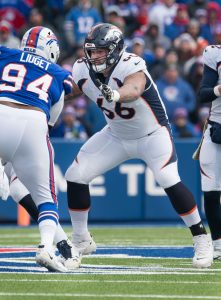 Even as the guard market produced five eight-figure-per-year UFA agreements this offseason, Risner is having a tough time convincing teams he is near that level. A Broncos starter for four seasons, the former second-round pick had not exactly received poor marks from the advanced metrics providers. But Risner has now struck out twice in free agency, waiting into the 2023 season before landing a gig and sitting on this year’s open market until May. Now heading into his age-29 season, the veteran guard is running out of time to cash in. He is sitting on 73 career starts, 11 coming with the Vikings last year.
Even as the guard market produced five eight-figure-per-year UFA agreements this offseason, Risner is having a tough time convincing teams he is near that level. A Broncos starter for four seasons, the former second-round pick had not exactly received poor marks from the advanced metrics providers. But Risner has now struck out twice in free agency, waiting into the 2023 season before landing a gig and sitting on this year’s open market until May. Now heading into his age-29 season, the veteran guard is running out of time to cash in. He is sitting on 73 career starts, 11 coming with the Vikings last year.
Risner made his way into Minnesota’s starting lineup in October 2023, eventually replacing the traded Ezra Cleveland. PFF assigned Risner a mid-pack rating (46th), though ESPN’s pass block win rate metric slotted him ninth among all interior linemen. He will battle Brandel for the Vikes’ left guard gig. Despite having just five starts and just 503 offensive snaps on his NFL resume, Brandel commanded more money than Risner this offseason.
Notable losses:
- Cam Akers, RB
- Anthony Barr, LB
- Kirk Cousins, QB
- Marcus Davenport, OLB
- Josh Dobbs, QB
- Troy Dye, LB
- Jordan Hicks, ILB
- Danielle Hunter, OLB
- Greg Joseph, K
- Dean Lowry, DL (released)
- James Lynch, DL
- Alexander Mattison, RB (released)
- K.J. Osborn, WR
- Chris Reed, G
- Austin Schlottmann, OL
- Khyiris Tonga, DL
- Oli Udoh, OL
- Nick Vigil, ILB
- D.J. Wonnum, OLB
The contracts Cousins and Hunter played out made the Vikings a historical outlier regarding an ability to retain top talent. Minnesota could not use its franchise tag on Hunter due to the parties’ August 2023 reworking, and Washington having tagged Cousins twice made a third tag — which no team has applied since the 2006 CBA made doing so prohibitive — a non-starter. This led to a nine-year Vikings sack ace and the team’s six-year quarterback heading south.
Read more
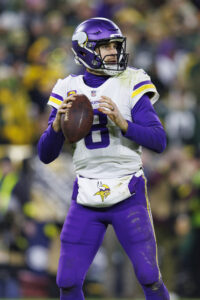 Adofo-Mensah made it work with Cousins in 2022 and ’23, an arrangement that generated a surprise 13-4 season. Cousins sought guarantees into Year 3 during the sides’ 2023 extension talks; the Vikings did not budge. Guarantees remained an issue this year. The fully guaranteed contract Cousins signed in 2018 armed him with leverage in each of his extension talks with the Vikes, leading to guarantee-heavy extensions in 2020 and 2022.
Adofo-Mensah made it work with Cousins in 2022 and ’23, an arrangement that generated a surprise 13-4 season. Cousins sought guarantees into Year 3 during the sides’ 2023 extension talks; the Vikings did not budge. Guarantees remained an issue this year. The fully guaranteed contract Cousins signed in 2018 armed him with leverage in each of his extension talks with the Vikes, leading to guarantee-heavy extensions in 2020 and 2022.
No deal in 2023 pointed Cousins toward the market, and although he expressed interest in staying in Minneapolis on several occasions, the financially savvy QB became a hotshot free agent once again. Cousins doing so ahead of his age-36 season and despite his Achilles tear illustrates the value above-average passers bring when free to negotiate with multiple teams.
The Vikings did make Cousins an offer and upped the guarantees before free agency; it just did not rival where the Falcons went. Ex-Kevin O’Connell Rams coworkers Raheem Morris and Zac Robinson are running the show in Atlanta, and it made sense for the team to chase a stable QB — given the trouble the NFC South club has encountered post-Matt Ryan — with experience in the system Robinson is implementing. The Falcons gave Cousins a $100MM practical guarantee on a four-year, $180MM deal, with locked-in money stretching into 2026 (this agreement produced a tampering penalty). Although Cousins may have reconsidered his path had he known the Falcons would turn around and draft Michael Penix Jr., another $100MM — which will push his career earnings past $330MM — would have been difficult to turn down under any circumstances.
Excluding alternate nods, Cousins has all of one Pro Bowl on his resume. That came under O’Connell in 2022. The Vikings jumping off this ride makes sense, even though it runs the risk of hurting their aerial capabilities this season. But Cousins logged five healthy seasons in Minnesota; the Vikes made the playoffs in two of them. The Vikings won one postseason contest with their affable passer, and while Cousins became the third-longest-tenured QB1 in Vikings history, he offered next to no mobility and has probably delivered his best NFL work. Though, the 12-year vet’s rapport with Jefferson will be difficult for Darnold and/or McCarthy to replicate this season.
Cousins departing after a void years-laden restructure moved $28.5MM in dead money onto Minnesota’s payroll. Dead money issues notwithstanding, the third-year GM used void years once again via more restructures this offseason. No such option was available for Hunter, whose run of contract reworkings stopped after last season.
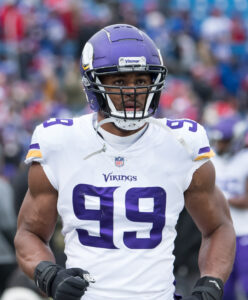 Hunter’s 2023 redo pointed him toward free agency, even though the Vikings did not throw in the towel on keeping him. The Pro Bowl OLB made his first market trip after a career-best season. Hunter saw a borderline-dominant season (16.5 sacks, NFL-most 23 tackles for loss) catapult him into a position in which he commanded a near-fully guaranteed deal from the Texans.
Hunter’s 2023 redo pointed him toward free agency, even though the Vikings did not throw in the towel on keeping him. The Pro Bowl OLB made his first market trip after a career-best season. Hunter saw a borderline-dominant season (16.5 sacks, NFL-most 23 tackles for loss) catapult him into a position in which he commanded a near-fully guaranteed deal from the Texans.
Not long after losing Greenard, Houston guaranteed $48MM of the $49.5MM in his two-year deal. That rare agreement, which will bring Hunter back to the city where he attended high school, came after the former third-round pick reestablished his value following two major injuries.
After a neck injury nixed Hunter’s 2020 season and a torn pec sidelined him for 10 games in 2021, the Mike Zimmer-era third-rounder moved his count of double-digit sack seasons to five. The Vikings depended on Hunter’s bounce-back effort, as their Davenport plan fizzled quickly last year. Davenport’s four-game season led to another “prove it” deal, this one a $6.5MM pact with the Lions.
Although the sack era excludes the famed Purple People Eaters D-line’s work, Hunter leaves Minnesota after racking up the third-most official sacks (87.5) in team history. Wonnum, who became a pivotal edge component due to the injuries the Vikings sustained in recent years, caught a bad break by suffering a torn quad in January. He joined the Panthers on a one-year deal.
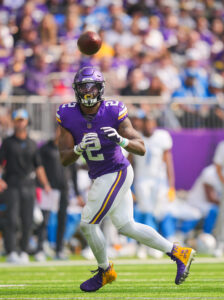 Mattison could not match his off-the-bench production as a starter, averaging 3.9 yards per carry and finishing in the bottom third in rushing yards over expected. The Vikings bailed on a two-year deal, and after ex-fifth-round pick Ty Chandler showed a spark late last season, he promises to mix in as a Jones 1-B.
Mattison could not match his off-the-bench production as a starter, averaging 3.9 yards per carry and finishing in the bottom third in rushing yards over expected. The Vikings bailed on a two-year deal, and after ex-fifth-round pick Ty Chandler showed a spark late last season, he promises to mix in as a Jones 1-B.
Osborn offered slot consistency with Cousins, producing 655- and 650-yard seasons from 2021-22, before finishing with 540 tethered to the Vikes’ gaggle of backups. Osborn did not make sense as a keeper, given the Jefferson payment. That said, the Patriots added the slot regular for just $4MM in March. Osborn’s exit leaves some questions about Minnesota’s WR3 role, with Sherfield (one 400-yard season in six tries) not having offered anything close to Osborn’s consistency.
Minnesota’s kicker from 2021-23, Joseph is now in Green Bay as Anders Carlson‘s top competitor. That represents a step down for the veteran, who kicked in every Vikings game over the past three seasons. Sixth-round pick Will Reichard, Alabama’s kicker for five seasons, is positioned to take over.
Trades:
Earlier this offseason, it looked like a team that wanted McCarthy would need to complete a notable trade-up transaction to secure necessary real estate. That did not end up being required, but the Vikings acquired more ammo by trading up 19 spots. Minnesota forked over a 2025 second to do so, giving Houston an important future asset. As it turned out, the Vikings used this pick to replace Hunter rather than Cousins. Though, the team made a memorable attempt to climb up for a quarterback.
Draft:
- Round 1, No 10 (via Jets): J.J. McCarthy (QB, Michigan)
- Round 1, No. 17 (via Jaguars): Dallas Turner (EDGE, Alabama)
- Round 4, No. 108: Khyree Jackson (CB, Oregon) (signed)
- Round 6, No. 177 (from Panthers through Jaguars): Walter Rouse (T, Oklahoma) (signed)
- Round 6: No. 203 (from Texans through Browns, Broncos and Jets): Will Reichard (K, Alabama) (signed)
- Round 7, No. 230 (from Falcons through Browns and Cardinals): Michael Jurgens (C, Wake Forest) (signed)
- Round 7, No. 232 (from Broncos through 49ers and Texans): Levi Drake Rodriguez (DT, Texas A&M Commerce) (signed)
With Darnold as the bridge, the Vikings made no secret of their interest in selecting a quarterback in the first round. Adofo-Mensah indicated the team would be comfortable with multiple options, and while Jayden Daniels interest surfaced, the Commanders confirming only one offer came in for their No. 2 pick — presumably from the Daniels-obsessed Raiders — it became clear Minnesota focused its post-Cousins efforts on another passer. Drake Maye what-ifs may follow McCarthy’s career, as the Vikings and Giants made offers to move up to No. 3.
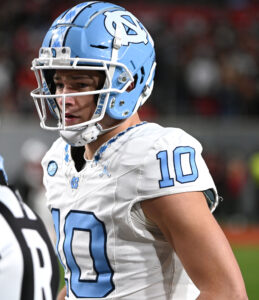 Neither NFC club was able to convince New England to pass on Maye. The Giants proposed Nos. 6 and 47, along with their 2025 first, for No. 3. Competing with this during the early part of the draft, the Vikings are believed to have sent the Pats an offer including Nos. 11 and 23, along with their 2025 first. Minnesota-Maye buzz built before the draft, with New York also enamored with the North Carolina prospect. The Vikings discussed terms with the Cardinals and Chargers, but no move that high became necessary for a player who appeared the team’s Maye backup plan.
Neither NFC club was able to convince New England to pass on Maye. The Giants proposed Nos. 6 and 47, along with their 2025 first, for No. 3. Competing with this during the early part of the draft, the Vikings are believed to have sent the Pats an offer including Nos. 11 and 23, along with their 2025 first. Minnesota-Maye buzz built before the draft, with New York also enamored with the North Carolina prospect. The Vikings discussed terms with the Cardinals and Chargers, but no move that high became necessary for a player who appeared the team’s Maye backup plan.
While the Giants shifted away from the position altogether, the Vikings were effectively pot-committed on adding one of this class’ arms. That turned out to be McCarthy, with a Sean Payton-led smokescreen effort potentially influencing the Vikings to part with a fourth-round pick and moving out of the fifth round (via the Jets) to jump up one spot for their QB hopeful.
McCarthy joined the rest of the top six non-Caleb Williams QB options in visiting Minnesota pre-draft; all but Daniels went through a workout. The Vikings were not closely tied to Michael Penix Jr., so it is not certain if the Falcons’ surprise move affected their plan. McCarthy will be expected to move into Minnesota’s lineup, potentially early in the season.
McCarthy said he spent more time with the Giants pre-draft, but the Vikings made him the first top-10 QB draftee in franchise history. Ownership is believed to have nudged the front office to concentrate on a long-term QB, after its recent year-to-year Cousins plan; that potentially helps explain the trade with the Texans.
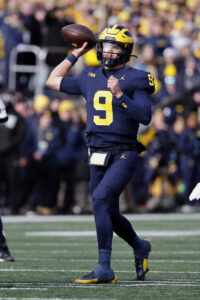 This will give the Vikings a rookie-deal QB starter — once McCarthy takes the baton from Darnold — for the first time since Teddy Bridgewater, and the 2014 first-rounder’s contract (marred by a severe knee injury) finished out with Sam Bradford on the books as well. McCarthy’s deal will give the Vikes a building block, and while teams’ interest in the Michigan prospect may have been exaggerated — as the Jim Harbaugh pupil fell to No. 10 — Minnesota obviously felt comfortable enough to make a pivotal investment.
This will give the Vikings a rookie-deal QB starter — once McCarthy takes the baton from Darnold — for the first time since Teddy Bridgewater, and the 2014 first-rounder’s contract (marred by a severe knee injury) finished out with Sam Bradford on the books as well. McCarthy’s deal will give the Vikes a building block, and while teams’ interest in the Michigan prospect may have been exaggerated — as the Jim Harbaugh pupil fell to No. 10 — Minnesota obviously felt comfortable enough to make a pivotal investment.
Wowing NFL staffers at his pro day, McCarthy was not asked to operate in a high-octane fashion. He attempted 332 passes in each of the past two seasons, reaching that number despite 14- and 15-game campaigns. McCarthy became the rare modern top-10 QB draftee without a 3,000-yard passing season, though his accuracy numbers (72.3% in 2023) impressed. McCarthy averaged nine yards per attempt last season, and his development becomes the central Vikings storyline.
The Vikes also met with Turner pre-draft, and they joined the Colts in benefiting from the draft’s offense-focused start. As a record 14 offensive players started the draft, the top pass rushers fell to the mid-teens. The Colts (Laiatu Latu), Seahawks (Byron Murphy) and Vikings capitalized and addressed their pass rush. Though, Minnesota needed to trade a fifth-round choice and 2025 third- and fourth-rounders to move up six spots. The Vikes had made the Seahawks an offer for No. 16 as well, appearing to emphasize the NFC North team’s interest in pass rushers.
Turner blazed to a 4.46-second 40-yard dash at the Combine, boosting his stock after he followed former teammate Will Anderson Jr. by winning SEC Defensive Player of the Year honors. Turner totaled 10 sacks and 14.5 TFLs during his final Alabama season. The Vikings added some edge options in Greenard and Van Ginkel; Turner becoming a quick study would make this a formidable pass rush.
Other:
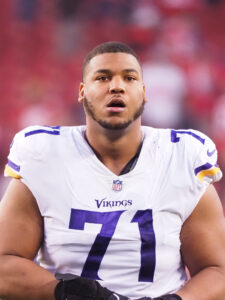 Continuing the trend of Spielman giving Adofo-Mensah building blocks, the former GM’s final first-round pick has become one of the NFL’s best young tackles. ESPN’s run block win rate metric ranked Darrisaw sixth in 2022; Pro Football Focus slotted him second among all tackles that season. PFF graded the Virginia Tech product as the NFL’s eighth-best tackle last season. Understandably, the Vikings are interested in extending Darrisaw. Talks have begun, but the 25-year-old blocker may need to wait.
Continuing the trend of Spielman giving Adofo-Mensah building blocks, the former GM’s final first-round pick has become one of the NFL’s best young tackles. ESPN’s run block win rate metric ranked Darrisaw sixth in 2022; Pro Football Focus slotted him second among all tackles that season. PFF graded the Virginia Tech product as the NFL’s eighth-best tackle last season. Understandably, the Vikings are interested in extending Darrisaw. Talks have begun, but the 25-year-old blocker may need to wait.
Minnesota extended Jefferson going into his fifth year, though the team tried to re-up the 2020 first-rounder last summer. The Vikings getting in early on Darrisaw may matter, as a Tristan Wirfs Buccaneers extension has not happened yet.
Wirfs is likely to eclipse Penei Sewell‘s tackle-record $28MM-per-year number. Rashawn Slater is also now extension-eligible. While Darrisaw does not have the accolades those first-rounders do, he can boost his value with a strong fourth season. The price figures to rise the longer the Vikings wait, but with only Brian O’Neill signed to an upper-crust contract up front, Minnesota should have a salary slot open for a Darrisaw deal.
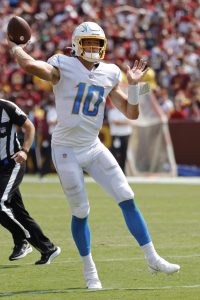 Cousins’ lofty dead money sum also impacts the Vikings on the contract front, but the team joined the Patriots in a full-court heave of sorts by asking about Herbert at the Combine. Tied to a $52.5MM-AAV contract, the Chargers standout is now tied to a new regime. Of course, Herbert’s presence played a central role in Harbaugh selecting the Bolts as his vehicle to return to the NFL. It represented a non-starter, though the inquiries make for a fun “what if?” Only two QBs (Deshaun Watson, Jim Plunkett) have been traded for three first-round picks since the merger. Herbert almost definitely would command such a haul, but both Minnesota and New England moved on to rookies.
Cousins’ lofty dead money sum also impacts the Vikings on the contract front, but the team joined the Patriots in a full-court heave of sorts by asking about Herbert at the Combine. Tied to a $52.5MM-AAV contract, the Chargers standout is now tied to a new regime. Of course, Herbert’s presence played a central role in Harbaugh selecting the Bolts as his vehicle to return to the NFL. It represented a non-starter, though the inquiries make for a fun “what if?” Only two QBs (Deshaun Watson, Jim Plunkett) have been traded for three first-round picks since the merger. Herbert almost definitely would command such a haul, but both Minnesota and New England moved on to rookies.
McCown coached Maye when the Tar Heels passer was in high school; the assistant will look to rebound from a rough stint as the Panthers’ QBs coach. Carolina axed the former quarterback shortly after firing first-year HC Frank Reich. McCown, who famously knocked the Vikings out of the 2003 playoffs as the Cardinals’ QB, will be tasked with tutoring another first-rounder after his Bryce Young mentorship featured some complications. Phillips served his three-week ban, stemming from a 2023 DWI arrest, this offseason.
Top 10 cap charges for 2024:
- Brian O’Neill, RT: $22.93MM
- T.J. Hockenson, TE: $14.04MM
- Byron Murphy, CB: $10.91MM
- Harrison Phillips, DL: $8.83MM
- Justin Jefferson, WR: $8.61MM
- Harrison Smith, S: $7.32MM
- Josh Oliver, TE: $6.17MM
- Garrett Bradbury, C: $5.77MM
- Jonathan Greenard, OLB: $5.74MM
- Sam Darnold, QB: $5MM
Darnold and McCarthy working with O’Connell will be interesting, given how Cousins performed in the third-year HC’s offense. After a dormant NFC North period, however, the Vikings are breaking in their new QBs at an interesting point for this division.
The Lions more than justified last year’s hype, delivering their best season since the Bobby Layne years, while the Packers navigated historic Aaron Rodgers dead money to reach the playoffs behind his replacement. With the Bears appearing to upgrade at QB via the Justin Fields-to-Caleb Williams switch and making key WR additions, this division appears deeper. This could result in a Vikings transition year, though the team exceeding expectations under O’Connell in the recent past offers some hope.
By Ely Allen |
at July 4, 2024 10:00 pm
The Cardinals knew the 2023 season would be a challenge with quarterback Kyler Murray coming back late from a 2022 torn ACL. First-year head coach Jonathan Gannon had an offense with a backup quarterback starting the year and inherited the 31st-ranked defense of 2022. Knowing that a turnaround was not likely last season, Arizona focused on implementing its new system under new leadership.
The past few months have seen the first full offseason under Gannon and new general manager Monti Ossenfort. After spending a year seeing what does and doesn’t work, the new brain trust went to work on how best to transform the roster to best fit their needs. Riding at the bottom of the NFC West for the past two years, the Cardinals had a lot to gain and not much to lose for the 2024 season.
Trades:
The 2023 season did not see the Cardinals generate much receiving success. Aside from the emergence of second-year tight end Trey McBride, not a single player on the offense eclipsed 600 yards receiving. Mainly, this was due to injuries at the quarterback and wide receiver positions, really all over the offense. In fact, Moore and McBride were the only skill players on the team to appear in all 17 games of the season last year. 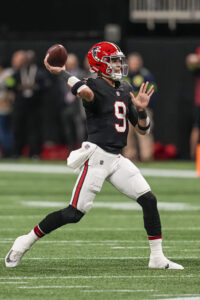
Moore was a second-round pick for Arizona out of Purdue back in 2021. As a rookie role player, Moore thrived in the WR4 role behind Christian Kirk, A.J. Green, and DeAndre Hopkins. He recorded career highs in receptions (54) and receiving yards (435). In his sophomore season, Moore looked to be embracing a larger role on the offense, nearly matching his rookie stats in just eight starts. However, a groin injury landed him on injured reserve for the remainder of the season, putting an early end to what looked to be a promising campaign.
Although Moore stayed healthy in 2023, the diminutive slot presence only produced 352 receiving yards. A seeming effort to retool the top end of the wide receivers room led to Moore’s shipment to Atlanta. In a rare player-for-player exchange, the Falcons provided Ridder in return. A third-round pick out of Cincinnati two years ago, Ridder competed for the honor of replacing franchise passer Matt Ryan as the new sheriff in town as a rookie. He did not beat out Marcus Mariota but ended up starting the last four games of the 2022 season after Mariota landed on IR with a knee issue.
Ridder retained the starting job heading into 2023, with the Falcons centering their offseason around him (and not pursuing high-profile QBs). Atlanta’s plan fizzled when Ridder struggled to prove effective as a full-time starter. He was benched in Weeks 9 and 10 in favor of Taylor Heinicke, though Arthur Smith claimed the move had nothing to do with his performance. An injury to Heinicke would reinstate Ridder atop the depth chart once again, but his grasp on the starting job remained a feeble one. The Falcons have since overhauled their QB room, signing Kirk Cousins and making the surprising move to draft Michael Penix Jr. in Round 1. The team dealt Ridder between these moves, keeping Heinicke on a pay cut.
In Arizona, Ridder will not be asked to start; Murray has that job locked up quite securely. But with Murray missing 18 games in the past three years, a need for a strong backup quarterback exists. Options such as Colt McCoy (3-3), Trace McSorley (0-1), David Blough (0-2), Joshua Dobbs (1-7), and Clayton Tune (0-1) have delivered only four wins in those 18 starts without Murray. It is hard to say Ridder has the talent to consistently win in a replacement scenario, but rostering a quarterback with a near-full season of starting experience is a big enough upgrade over the five players listed above, especially when all it costs is a receiver who failed to blossom in his third year of NFL play.
Free agency additions:
- Jonah Williams, T: Two years, $30MM ($19MM guaranteed)
- Justin Jones, DT: Three years, $30.17MM ($17.75MM guaranteed)
- Sean Murphy-Bunting, CB: Three years, $25.5MM ($14.2MM guaranteed)
- Bilal Nichols, DT: Three years, $21MM ($12MM guaranteed)
- Mack Wilson, LB: Three years, $12.75MM ($6.45MM guaranteed)
- DeeJay Dallas, RB: Three years, $8.25MM ($2.4MM guaranteed)
- Zay Jones, WR: One year, $2.25MM ($1.15MM guaranteed)
- Evan Brown, G: One year, $2.35MM ($1.1MM guaranteed)
- Chris Moore, WR: One year, $2MM ($750K guaranteed)
- Khyiris Tonga, DT: One year, $1.75MM ($400K guaranteed)
- Markus Bailey, LB: One year, $1.13MM
 The Cardinals sustained some decent losses this year (see below), some willingly, and made reasonable efforts to upgrade at those positions where possible. The team focused heavily on the offensive and defensive lines. While Arizona’s offseason featured the departure of longtime left tackle D.J. Humphries, Williams comes in to fill his place — though, really, he fills the space of Paris Johnson Jr., who will flip from right tackle to left tackle to replace Humphries in 2024.
The Cardinals sustained some decent losses this year (see below), some willingly, and made reasonable efforts to upgrade at those positions where possible. The team focused heavily on the offensive and defensive lines. While Arizona’s offseason featured the departure of longtime left tackle D.J. Humphries, Williams comes in to fill his place — though, really, he fills the space of Paris Johnson Jr., who will flip from right tackle to left tackle to replace Humphries in 2024.
Williams may seem like a lateral move from Humphries is terms of talent, but the former Bengals first-rounder is 26 and should have a bit more tread left on the tires than Humphries (30). He also comes at a slight discount to what Humphries was owed should he have been retained.
On the defensive front, Nichols and Jones do not look pretty as upgrades, grading out on Pro Football Focus (subscription required) as the 97th- and 107th-best defensive tackle regulars (out of 130) last year, but they look better than the departing Leki Fotu (117) and Jonathan Ledbetter (128) and are far more productive.
Jones proved disruptive on the Bears’ interior these past two years, totaling 7.5 sacks, 22 tackles for loss, and 24 quarterback hits over that span. Nichols hasn’t been that productive as of late, but in 2020, he also showed out as supplementary rusher for Chicago with five sacks, seven tackles for loss, and 13 quarterback hits. If both of these players can tap into their Bears versions, they can form a reasonably promising starting interior.
The Cardinals brought in Murphy-Bunting as a veteran addition to what is shaping up to be a young group of cornerbacks. The team upgrades in a big way at linebacker, as well, bringing in Wilson to replace part-time starters Josh Woods and Zeke Turner. 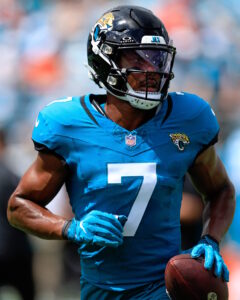
On offense, Jones comes in after an injury-riddled 2023 season with the Jaguars, hoping to recapture the magic of his 2022 campaign. Given a three-year, $24MM deal, Jones rewarded the Jaguars in his first Jacksonville season by smashing his career-high marks in an 82-catch, 823-yard showing. Last season, which featured PCL and femur injuries, was not as good. The former second-round pick was also arrested on a misdemeanor domestic battery charge in November, and the Jaguars cut bait as they retooled their WR room this offseason. Jones also visited the Cowboys, Chiefs and Titans. With the Cards, he should slot in as WR3 behind Marvin Harrison Jr. and Michael Wilson.
Brown joins the team after starting at center and guard for the Seahawks and Lions in the past three years. With Hjalte Froholdt taking care of business at center, the Cardinals seem to want to use Brown’s starting experience at left guard. Brown saw regular guard duty in 2022.
The addition of Dallas is an intriguing one. His contract includes rushing yards-based incentives, so it seems like the Cardinals expect him to work as a part of the offense. In Seattle, the former fourth-round pick out of Miami (Fla.) served mostly as a special teams asset, returning both kickoffs and punts, but $2.75MM per year seems like a lot for a return specialist. Dallas already had to compete with Michael Carter and Emari Demercado for running back snaps, but then the Cardinals used a third-round pick on a rusher, muddying the waters even further.
Re-signings:
- Elijah Wilkinson, OL: One year, $2MM ($1.58MM guaranteed)
- Blake Gillikin, P: Two years, $3.7MM ($1.2MM guaranteed)
- Trystan Colon, C: One year, $1.75MM ($450K guaranteed)
- Krys Barnes, LB: One year, $1.29MM ($100K guaranteed)
- Aaron Brewer, LS: One year, $1.38MM ($84K guaranteed)
- L.J. Collier, DE: One year, $1.29MM ($25K guaranteed)
- Bobby Price, CB: One year, $1.29MM ($25K guaranteed)
- Keith Ismael, C: One year, $1.11MM ($25K guaranteed)
- Jesse Luketa, LB: One year, $985K
- Carter O’Donnell, OL: One year, $915K
Arizona’s re-signings this offseason were mostly ancillary. Gillikin and Brewer obviously stand as the players most likely to occupy steady roles. Gillikin returns for a second year as the team’s primary punter, while Brewer is back as the long snapper for his ninth season in Arizona.
Wilkinson, Colon, Ismael, and O’Donnell provide reliable depth and versatility along the offensive line as backups. Barnes returns after tallying the team’s fifth-most tackles last season, though he likely takes a backseat with the addition of Wilson at linebacker.
Notable losses:
- Marquise Brown, WR
- Rashad Fenton, CB
- Leki Fotu, DT
- Antonio Hamilton, CB
- D.J. Humphries, T (released)
- Jonathan Ledbetter, DL (non-tendered as RFA)
- Geoff Swaim, TE
- Zeke Turner, LB
- Carlos Watkins, DT
- Josh Woods, LB
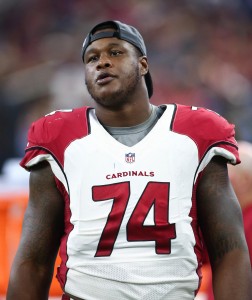 The biggest losses for Arizona this year come on the offensive side of the ball, though the team has done plenty in the offseason to address each. Humphries is perhaps the biggest name on this list. The 30-year-old had been a staple on the team’s offensive line since being drafted in the 2015 first round. The Pro Bowl tackle was a full-time starter from 2016-23, though he often missed significant time due to injury. Out of a possible 131 regular-season games, Humphries has missed 33. He remains unsigned.
The biggest losses for Arizona this year come on the offensive side of the ball, though the team has done plenty in the offseason to address each. Humphries is perhaps the biggest name on this list. The 30-year-old had been a staple on the team’s offensive line since being drafted in the 2015 first round. The Pro Bowl tackle was a full-time starter from 2016-23, though he often missed significant time due to injury. Out of a possible 131 regular-season games, Humphries has missed 33. He remains unsigned.
Humphries is not too far removed from playing great football, but with the injuries mounting, the financial burden of his contract was becoming too much to shoulder. Following his torn ACL to end the regular season, Humphries became an easy target for release due to his scheduled $22MM cap hit in 2024. By releasing Humphries, the team was able to gain back $15.95MM of cap savings.
The other big departure saw Brown sign with the Super Bowl champion Chiefs in free agency. Brown finished out his first-round rookie contract in Arizona after being traded from the Ravens during the 2022 draft. Brown never quite found the same success with the Cardinals that he had in Baltimore, mostly due to missed time with injuries.
Read more
After missing only three games in as many years with the Ravens, Brown has missed eight in the last two years alone in Arizona. With Murray also missing extensive time during Brown’s Cardinals stint, the reunion of Oklahoma teammates did not produce much of consequence. Still, the Cardinals considered extending the young wideout, something Brown seemed open to. Alas, no deal transpired, and Brown went to a team with a slightly different shade of red. 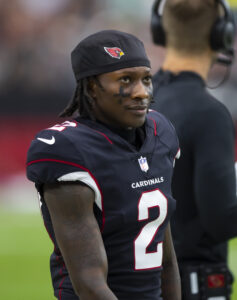
At cornerback, Hamilton set off to Atlanta. After Marco Wilson, who was claimed by the Patriots after being waived midseason last year, Hamilton played the most defensive snaps for the Cardinals at corner last season. Kei’Trel Clark and Starling Thomas played more snaps at outside corner than Hamilton and both return in 2024, though the arrivals of Murphy-Bunting and three rookie corners will make for more challenging routes to playing time.
The team did well to address its losses, though, working hard to reshape both the offensive and defensive fronts while also totally redoing the top end of the receiving corps.
Draft:
- 1-4: Marvin Harrison Jr., WR (Ohio State) (signed)
- 1-27: Darius Robinson, DL (Missouri) (signed)
- 2-43: Max Melton, CB (Rutgers) (signed)
- 3-66: Trey Benson, RB (Florida State)
- 3-71: Isaiah Adams (G, Illinois) (signed)
- 3-82: Tip Reiman (TE, Illinois) (signed)
- 3-90: Elijah Jones (CB, Boston College) (signed)
- 4-104: Dadrion Taylor-Demerson (S, Texas Tech) (signed)
- 5-138: Xavier Thomas (EDGE, Clemson) (signed)
- 5-162: Christian Jones (OT, Texas) (signed)
- 6-191: Tejhaun Palmer (WR, UAB) (signed)
- 7-226: Jaden Davis (CB, Miami) (signed)
The Cardinals will be trusting a lot to their rookie draft picks in 2024, utilizing a class that includes seven picks in the first three rounds.
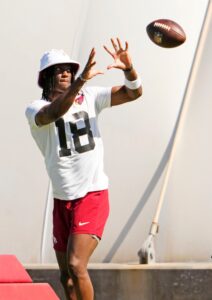 Headlining the class is the legacy wide receiver, Harrison, son of Hall of Fame Colts wideout Marvin Harrison. The younger Harrison was viewed by most as the top wide receiver in the draft class, reflected by his draft position as the first pass catcher to come off the board.
Headlining the class is the legacy wide receiver, Harrison, son of Hall of Fame Colts wideout Marvin Harrison. The younger Harrison was viewed by most as the top wide receiver in the draft class, reflected by his draft position as the first pass catcher to come off the board.
In his two seasons as a starter for the Buckeyes, Harrison was a unanimous All-American, even winning the Biletnikoff Award (awarded to the nation’s top receiver) in 2023. He immediately comes into Arizona as the team’s top receiving option. He’ll lead a new-look group that includes a 2023 third-rounder (Wilson) and an eighth-year veteran in Jones.
The Cardinals, who moved out of No. 3 overall to pick up assets in Ossenfort’s first draft at the controls, did not seriously consider trading out of Harrison draft real estate this year. Offers came in for No. 4, but similar to the Chargers at 5, Drake Maye being off the board reduced interest. Ossenfort said the team did not come close to moving the pick, being set on adding Harrison to a receiving corps that has lost Brown and DeAndre Hopkins over the past two offseasons.
Despite an unprecedented run of offensive players to open the draft, Robinson made it into the first round as the fifth pass rusher taken. Robinson is a versatile lineman who began his college career on the interior before moving out to end. He’s extremely disruptive and uses great length to swallow up ball carriers but will need to improve his pass-rushing arsenal to successfully pressure the quarterback in the NFL. Arizona will hope he can add an increased ability to a defense that saw Dennis Gardeck lead the team with only six sacks last year. 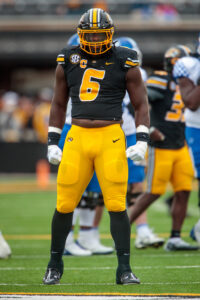
After struggling to find answers at cornerback throughout 2023, the Cardinals made some moves and will sport a retooled group this year. Murphy-Bunting and Melton are the new headliners. The brother of 2023 Seahawks seventh-round wide receiver Bo Melton, Max was a four-year starter for the Scarlet Knights. Melton was a ballhawk in college recording eight interceptions and 30 passes defensed in his collegiate career.
Of the Cards’ four third-round picks, Adams and Jones are set to have the biggest likely impacts. Jones will join Melton in attempting to bolster the team’s secondary. Adams will be in the running for the starting left guard job, though Brown has been pegged as the favorite for the starting gig. Benson should have the opportunity to push Demercado for the RB2 job, complementing James Conner‘s starting efforts. Reiman, likewise, should be able to push Elijah Higgins for the TE2 job behind McBride.
Benson remains the only player in the rookie class who has not signed his entry-level contract. He and Jets wide receiver Malachi Corley were the two first picks of the third round, and the agents of both players seem to be waiting on the other to sign their contract for leverage when negotiating guaranteed money on each player’s rookie deal.
Other:
An All-American left tackle at Ohio State, Johnson will make the move back to his college position after playing right tackle during his rookie season. This follows the career path of Humphries, who also switched from the right to the left side of the line after his rookie season.
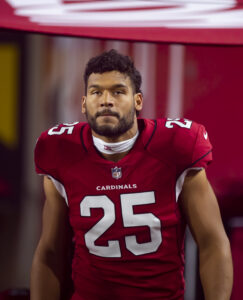 Collins saw a lack of production in a move to outside linebacker after recording 100 tackles as an inside ‘backer in his sophomore campaign. As a result, the team declined his fifth-year option. The Cardinals claim to want to keep the former first-round pick around, just not under the inflexible terms of the fifth-year option. This makes 2024 a contract year for the 25-year-old out of Tulsa.
Collins saw a lack of production in a move to outside linebacker after recording 100 tackles as an inside ‘backer in his sophomore campaign. As a result, the team declined his fifth-year option. The Cardinals claim to want to keep the former first-round pick around, just not under the inflexible terms of the fifth-year option. This makes 2024 a contract year for the 25-year-old out of Tulsa.
Harris worked with then-vice president of pro personnel Adrian Wilson to fill the interim duties of general manager during Steve Keim‘s leave of absence in 2022. The Cardinals passed over both for the job to replace Keim, and each longtime Arizona exec is now out of the picture. Wilson joined the Panthers last year. After leaving Arizona, Harris was sought after to interview for the Patriots’ top front office post. He joined other veteran executives in declining the request. Other departing execs include player personnel director Dru Grigson and director of college scouting Josh Scobey.
McDonough was awarded the $3MM arbitration settlement after accusing his former employer, Bidwill, of cheating and gross misconduct. McDonough had been demoted and eventually dismissed after making such claims with the team releasing a statement accusing McDonough of spousal abuse and neglect of his disabled adult daughter, allegations which were found to be “false and defamatory.” The arbitration case was successful in the defamation claims but did not result in damages owing to the team’s dismissal of McDonough, leading to the subsequent lawsuit.
Top 10 cap charges for 2023:
- Kyler Murray, QB: $49.12MM
- Budda Baker, S: $19.03MM
- Jalen Thompson, S: $12.47MM
- James Conner, RB: $8.93MM
- Kyzir White, OLB: $6.75MM
- Jonah Williams, RT: $6.61MM
- Justin Jones, DT: $6.55MM
- Marvin Harrison Jr., WR: $6.43MM
- Paris Johnson Jr., LT: $6.38MM
- Sean Murphy-Bunting, CB: $5.96MM
Ossenfort and Co. completed a lot of work updating the roster this offseason. Between the replacement of departing players with others that potentially fit the new system better and the influx of draft picks in the first few rounds, the Cardinals taking a step forward and becoming a surprise playoff contender should not be dismissed so quickly.
New targets for Murray, the new-look offensive and defensive fronts, and a second year under Gannon’s leadership all amount to big possibilities for the Cardinals in 2024. They do have a lot of ground to make up on the 49ers, Rams, and Seahawks, and 2024 might not be the season in which it all comes together, but Gannon and Ossenfort are doing everything in their power to build around the best parts of this team and show improvement in their second year at the helm.
By Sam Robinson |
at June 30, 2024 10:13 pm
The AFC’s underachievement kingpins for much of this century, the Chargers saw their most recent mission hit a wall last season. After GM Tom Telesco gave Brandon Staley another year in the wake of the 2022 team’s historic collapse, both ended up gone less than a year later. In terms of pure GMs, no AFC front office boss had been in place longer than Telesco. The Bolts responded by changing their managerial structure; their decision-making hierarchy now runs through a head coach.
Jim Harbaugh will be tasked with maximizing Justin Herbert in a way Staley and Anthony Lynn could not, and the Chargers stripped away their quarterback’s long-running receiving corps. Harbaugh’s pedigree aside, many questions come out of this Bolts offseason. But the team, after years of adding first-time HCs on lower-cost contracts, veered in a different direction as the Telesco era failed to turn steady offseason hype into much of consequence.
Coaching/Front Office:
Weeks before the Chargers fired Staley, Harbaugh connections began. While the team was also tied to Lions OC Ben Johnson early in the process and later linked loosely to Bill Belichick, Harbaugh buzz persisted. Chargers ownership contacted Harbaugh’s camp upon firing Staley, laying the groundwork for a bolder Bolts hire.
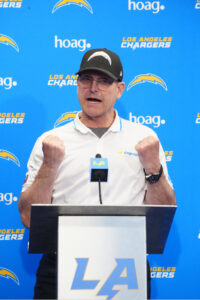 The embattled yet successful Michigan leader, whom the Wolverines sought to extend following a two-suspension season that ended with the program’s first national championship in 26 years, maximized his leverage by negotiating with the Big Ten school and scheduling a second Falcons interview. Harbaugh never made it to Atlanta for that meeting, viewing the Los Angeles gig as enticing enough to make his long-rumored jump back to the NFL.
The embattled yet successful Michigan leader, whom the Wolverines sought to extend following a two-suspension season that ended with the program’s first national championship in 26 years, maximized his leverage by negotiating with the Big Ten school and scheduling a second Falcons interview. Harbaugh never made it to Atlanta for that meeting, viewing the Los Angeles gig as enticing enough to make his long-rumored jump back to the NFL.
On paper, Harbaugh’s NFL exit qualified as odd. The former quarterback immediately turned around the 49ers upon arrival in 2011, guiding them to three straight NFC championship games. The 2011 and ’13 San Francisco squads fell just short of NFC championships while the ’12 team saw a still-debated non-whistle in the final seconds of Super Bowl XLVII cement a victory for Harbaugh’s older brother. Even after an 8-8 2014 season, Harbaugh enters the 2024 campaign in fifth place in all-time win percentage. For coaches who began their careers after the 1970 merger, no one outflanks Harbaugh’s .695 mark.
A power struggle with then-49ers GM Trent Baalke played the lead role in Harbaugh returning to his alma mater in 2015, but the early 2020s brought steady Harbaugh-to-NFL rumors. The fiery HC had said unfinished business remained in the pros, but interviews with the Vikings (2022) and Broncos (’23) did not provide a gateway back. Rumblings in front office circles pegged Harbaugh as difficult to work with, and while that may be accurate, the veteran leader has won everywhere he has camped.
Harbaugh, 60, guided Michigan to three straight CFP fields to continue a trend of turnarounds. The former Chargers starting QB rebuilt the Stanford program and then the 49ers. Nearly 15 years after his Andrew Luck partnership ended, Harbaugh made the jump to work with a comparable QB talent.
While the Chargers have not taken heat on a Bengals level for frugality, the perception they were not willing to go big for a high-profile head coach prompted an ownership message of reimagining the football operation upon canning Telesco and Staley. The Chargers had not hired anyone with prior HC experience since replacing Marty Schottenheimer with Norv Turner in 2007. In the years since, the Bolts paid first-timers Mike McCoy, Lynn and Staley lower salaries. Harbaugh will command a $16MM-per-year salary. While that fell short of his $18MM ask, it is believed — as HC salaries do not have to be disclosed — it places him near the top of the league.
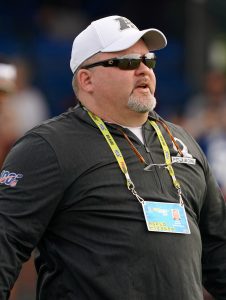 Considering Harbaugh’s past with Baalke, it certainly made sense for the Chargers to pair him with a pre-approved GM. Interviewing Giants assistant GM Brandon Brown twice, the Chargers used a John Harbaugh connection to find their Telesco successor. Hortiz will not hold final say like Telesco did, but the longtime Ravens exec has worked with the elder Harbaugh throughout the HC’s time in Baltimore.
Considering Harbaugh’s past with Baalke, it certainly made sense for the Chargers to pair him with a pre-approved GM. Interviewing Giants assistant GM Brandon Brown twice, the Chargers used a John Harbaugh connection to find their Telesco successor. Hortiz will not hold final say like Telesco did, but the longtime Ravens exec has worked with the elder Harbaugh throughout the HC’s time in Baltimore.
Hortiz, 48, served under Ozzie Newsome for 20 years and moved from the scouting level to college scouting director to director of player personnel with the Ravens. The team bumped Hortiz to the latter post in 2019, upon promoting Eric DeCosta to succeed Newsome. Hortiz has interviewed for GM jobs in the past, meeting about the Cardinals position last year and discussing the Giants and Steelers’ vacancies in 2022. Hortiz’s past with John Harbaugh, however, should give this partnership a better shot at succeeding in the long term compared to the Baalke-Jim Harbaugh pairing.
Although Alexander comes from the Jets, the former Joe Douglas lieutenant spent extensive time in Baltimore — alongside Douglas — leading up to his New York move. Hortiz hired a former coworker to be his second-in-command; Harbaugh did as well. Roman was Jim’s OC in all four years in San Francisco. The run-oriented OC — though, Roman has not spent much time with pass-first QBs — becomes a rare fourth-time NFL coordinator, having made stops in Buffalo and Baltimore since Harbaugh’s San Francisco exit.
The Ravens fired Roman after four seasons; he spent 2023 out of football. His Chargers fit will be fascinating, and it certainly appears — through the team’s actions in March and April — the Bolts will make the ground game a bigger part of their plan. It will be interesting to see how Roman tailors his style to Herbert, whose skills differ from the likes of Lamar Jackson, Tyrod Taylor and Colin Kaepernick. Roman last worked with a true pass-based signal-caller in 2012, when the 49ers made the midseason switch from Alex Smith to Kaepernick.
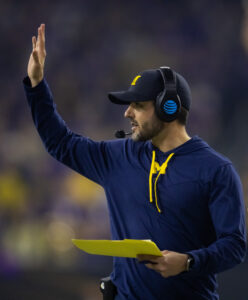 Harbaugh and Roman resurrected Smith’s career, and the future Chiefs starter carried a 70.2% completion rate at 8.0 yards per attempt when a concussion led to his 2012 benching. Roman was at the controls for Jackson’s dominant 2019 season, which brought a unanimous MVP, though his run-centric style wore thin as his Maryland stay progressed. Although Herbert is capable on the ground, Roman’s past will certainly make fantasy drafters uneasy about how he will proceed with one of the NFL’s most talented passers — especially given the team’s actions at wide receiver this offseason.
Harbaugh and Roman resurrected Smith’s career, and the future Chiefs starter carried a 70.2% completion rate at 8.0 yards per attempt when a concussion led to his 2012 benching. Roman was at the controls for Jackson’s dominant 2019 season, which brought a unanimous MVP, though his run-centric style wore thin as his Maryland stay progressed. Although Herbert is capable on the ground, Roman’s past will certainly make fantasy drafters uneasy about how he will proceed with one of the NFL’s most talented passers — especially given the team’s actions at wide receiver this offseason.
Minter, 41, checks both boxes when it comes to the Harbaughs. Like Mike Macdonald, the new Chargers DC worked under John Harbaugh (2017-20) and then Jim; Minter succeeded Macdonald as the Wolverines’ defensive play-caller in 2022. Minter made a significant jump, moving from Vanderbilt safeties coach to Michigan DC. The Big Ten power led Division I-FBS in scoring defense last season (10.4 points per game), and the Wolverines’ 268 yards allowed per game from 2022-23 ranked second.
Previously serving as Ravens DBs coach in the NFL, Minter will see his rise continue with this L.A. gig.
Trades:
Shortly after Harbaugh’s hire, Allen said he expected to remain with the Chargers. The team released Mike Williams to reach cap compliance by the March 13 deadline, but a day later, it bid farewell to one of the best players in franchise history. Given where WR prices have gone this offseason, Chicago having Allen tied to a mid-second-tier contract — he is due $18.1MM in 2024, the final season of a $20MM-AAV deal. The 11-year Charger’s departure may be difficult for the Bolts in the short term, as they depended on the high-end route runner for years.
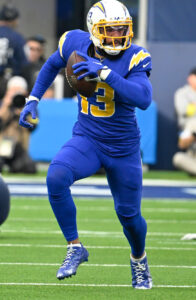 A 2013 third-round pick, Allen had been the team’s longest-tenured player for years. While unlikely to join Lance Alworth in the Hall of Fame and landing a bit south of where John Jefferson was at his early-career peak, Allen is probably the best Bolts receiver of the past 35 years. His 904 receptions and 10,530 yards rank second — by a wide margin — in Bolts history.
A 2013 third-round pick, Allen had been the team’s longest-tenured player for years. While unlikely to join Lance Alworth in the Hall of Fame and landing a bit south of where John Jefferson was at his early-career peak, Allen is probably the best Bolts receiver of the past 35 years. His 904 receptions and 10,530 yards rank second — by a wide margin — in Bolts history.
As Antonio Gates declined, the Chargers centered their aerial attacks around Allen. The Cal alum delivered six 1,000-yard seasons, including a 1,243-yard showing in just 13 games last season. With Allen poised to help Caleb Williams‘ NFL transition, no comparable option remains on the Chargers’ roster.
The Chargers restructured Allen’s contract to create cap space last year, leading to an $11.6MM dead money charge for 2024. The team offered Allen an extension, but it appeared — per Allen’s camp — it came at a reduced rate, with the 32-year-old receiver’s agent indicating the Bolts’ one proposal included pay cuts in 2025 and 2026. As could be expected given his 2023 season and the exploding wideout market, Allen emphatically refused a pay cut.
Extensions and restructures:
The restructures from Telesco’s final offseason in charge left Bosa, Mack, Allen and Williams all with cap hits of at least $32MM. The Chargers cut ties with their longtime receiving tandem but held onto their standout edge rushers, who accepted pay cuts to stay in Harbaugh’s first season. Assembled in 2022 upon the Chargers acquiring Mack from the Bears, this pair may well be going into its final season together. Mack’s Bears-built contract expires after the 2024 season.
Read more
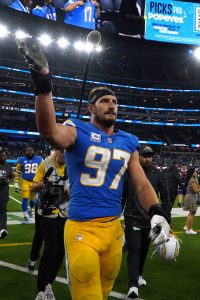 Going into his age-29 season, Bosa has seen injuries limit him significantly. This trend brought 20 absences over the past two seasons, making it a natural consideration for the Chargers to approach him about a pay cut. The talented OLB was attached to a $27MM-per-year contract, which still stood as a top-five number among edge defenders entering the offseason. Bosa, who has four Pro Bowls on his resume, is now on a two-year, $40.4MM deal.
Going into his age-29 season, Bosa has seen injuries limit him significantly. This trend brought 20 absences over the past two seasons, making it a natural consideration for the Chargers to approach him about a pay cut. The talented OLB was attached to a $27MM-per-year contract, which still stood as a top-five number among edge defenders entering the offseason. Bosa, who has four Pro Bowls on his resume, is now on a two-year, $40.4MM deal.
The March adjustment reduced Bosa’s cap number from $36.6MM to $26.1MM. No guaranteed money is due beyond 2024, giving the Chargers flexibility. If the team was to move on in 2025, at least $25MM in cap savings would emerge.
Mack’s 2018 Bears extension helped set the table for Bosa’s 2020 windfall, and while the older Bolts pass rusher was coming off a season-ending foot injury upon arriving in L.A., he has stayed healthy since. Now an eight-time Pro Bowler, Mack delivered a six-sack showing in Week 1 and rocketed back toward the top tier at his position by finishing with a career-high 17. Mack’s 22 QB hits were his most since his 2017 Raiders finale.
Mack, 33, has been a vital Bolts piece during a period spent largely without Bosa. Mack’s restructure lowered his 2024 cap hit from $38.5MM to $25.4MM. Harbaugh’s pledge this Chargers iteration can contend helped convince Bosa and Mack to stay, and the team will count on its veteran OLB pieces for at least one more season. Mack signing a six-year extension in 2018 undoubtedly will block him from a monster third contract, but the former Defensive Player of the Year has already done quite well in his career. The 2014 draftee has surpassed $150MM in career earnings.
Free agency additions:
- Gus Edwards, RB. Two years, $6.5MM ($3.38MM guaranteed)
- Bud Dupree, OLB. One year, $3MM ($2.75MM guaranteed)
- Kristian Fulton, CB. One year, $3.13MM ($2.45MM guaranteed)
- DJ Chark, WR. One year, $3MM ($2.1MM guaranteed)
- Denzel Perryman, LB. One year, $2.3MM ($1.88MM guaranteed)
- Will Dissly, TE. Three years, $14MM ($1MM guaranteed)
- Troy Dye, S. One year, $1.79MM ($665K guaranteed)
- Poona Ford, DT. One year, $1.79MM ($665K guaranteed)
- J.K. Dobbins, RB. One year, $1.61MM ($50K guaranteed)
- Tony Jefferson, S. One year, $1.21MM
- Bradley Bozeman, C. One year, $1.13MM
- Jesper Horsted, TE. One year, $1.13MM
- Hayden Hurst, TE. One year, $1.13MM
- Alex Leatherwood, OL. One year, $985K
A Saquon Barkley tie did emerge, but the Chargers — their increased interest in the run game notwithstanding — were never expected to spend big here post-Austin Ekeler. They ended up doubling down on familiarity, bringing in both of the top RBs from Roman’s Ravens years.
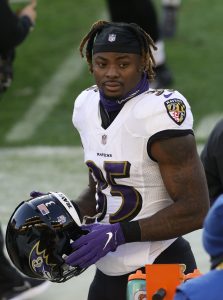 Both Dobbins and Edwards were available at low rates, the former especially, due to injury trouble. Dobbins missed all of the 2021 season and much of the 2022 campaign due to an ACL tear, and he suffered a torn Achilles — historically, a tougher injury for running backs to surmount — in Week 1 of last season.
Both Dobbins and Edwards were available at low rates, the former especially, due to injury trouble. Dobbins missed all of the 2021 season and much of the 2022 campaign due to an ACL tear, and he suffered a torn Achilles — historically, a tougher injury for running backs to surmount — in Week 1 of last season.
Dobbins displayed quality skills with a standout rookie year, when he averaged six yards per carry on 135 totes. Since the merger, only six other RBs (Mercury Morris, Jamaal Charles, Barry Sanders, O.J. Simpson, Adrian Peterson and C.J. Spiller) have averaged six yards per handoff on at least 130 carries. Upside exists, but Dobbins (43 missed games) is running out of time to show he can hold up in the NFL.
Also tearing an ACL in August 2021, Edwards joined Dobbins in missing time into the 2022 season. Edwards had shown he could hold up over an extended period, working as a complementary back — and eclipsing five yards per carry each year from 2018-20 — as Jackson became a franchise QB. The Ravens rewarded Edwards with a two-year, $9MM extension in 2021. Edwards did not play on that deal until late October 2022. Edwards’ post-injury work, however, earned him some guarantees Dobbins could not secure.
The Ravens depended on Edwards last season, having lost Dobbins and then speedy rookie Keaton Mitchell to season-ending maladies. Edwards, 29, saw his yards per carry drop to 4.1, but he led the AFC’s top-seeded team in rushing (810 yards) and scored 13 touchdowns. Particularly effective near the goal line, Edwards finished with a mid-pack 51 rushing yards over expected in 2023. The Chargers struggled to find an Ekeler backup for years, despite the perception RBs are easily replaceable. The team will bank on familiarity, though it was interesting to see the club sign off on two backs with major injuries in their recent pasts.
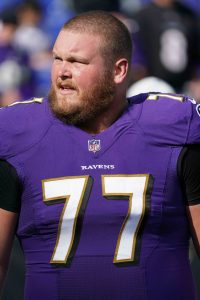 Carolina cut Bozeman, removing a $6MM-per-year contract from the payroll. The Chargers have three first-round picks and Trey Pipkins‘ midlevel deal up front; they will count on Bozeman bouncing back at a basement-level rate. Continuing a theme of Roman familiarity, Bozeman’s Ravens run (2018-21) overlapped entirely with Roman’s. Bozeman started 49 games — all but one of those coming with Roman as OC — at center and guard with Baltimore.
Carolina cut Bozeman, removing a $6MM-per-year contract from the payroll. The Chargers have three first-round picks and Trey Pipkins‘ midlevel deal up front; they will count on Bozeman bouncing back at a basement-level rate. Continuing a theme of Roman familiarity, Bozeman’s Ravens run (2018-21) overlapped entirely with Roman’s. Bozeman started 49 games — all but one of those coming with Roman as OC — at center and guard with Baltimore.
On a one-year Panthers deal in 2022, Bozeman ranked sixth in pass block win rate. Pro Football Focus graded Bozeman 21st at center last year but slotted him highest (11th) during his final Ravens season, when the former sixth-round pick converted to center after two years at guard. The Chargers did not re-sign their primary 2023 center, Will Clapp, leaving Bozeman a clear path to another gig as a starter in his age-30 season.
The Chargers passed on Malik Nabers and Rome Odunze in the draft, and while they reduced costs considerably at wide receiver, the team did bring in some help. After hosting Tyler Boyd, the team signed Chark. The Bolts also brought in Marquez Valdes-Scantling for a subsequent visit, signaling they might not be done receiver shopping. For now, however, Chark represents the only veteran piece acquired. He will join contract-year target Josh Palmer and 2023 first-rounder Quentin Johnston as veteran Chargers WRs.
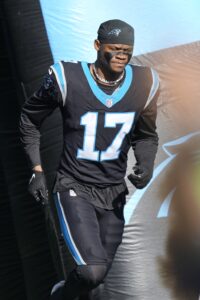 Harbaugh’s 49ers investments at receiver provided a blueprint for what Chargers fans could expect this offseason. Although those 49ers teams rostered Michael Crabtree, he was there when Harbaugh arrived. The team traded a sixth-round pick for Anquan Boldin and gave Randy Moss, Mario Manningham and Brandon Lloyd low-cost deals. This year’s Bolts are taking this route.
Harbaugh’s 49ers investments at receiver provided a blueprint for what Chargers fans could expect this offseason. Although those 49ers teams rostered Michael Crabtree, he was there when Harbaugh arrived. The team traded a sixth-round pick for Anquan Boldin and gave Randy Moss, Mario Manningham and Brandon Lloyd low-cost deals. This year’s Bolts are taking this route.
Chark, 27, is now on a fourth team in four seasons. This contract also marks the second straight year Chark will see a salary reduction. He signed a $10MM Lions deal in 2022 and a $5MM Panthers pact in ’23. A sporadically effective deep threat, the former Jaguars second-rounder did amass 525 yards in 15 games — his healthiest season since 2020 — and averaged at least 15 yards per catch in 2022 and ’23. With Herbert now set to target Chark, the 6-foot-3 weapon looms as an interesting wild card.
A down Fulton season tanked his market. The multiyear Titans starter still received interest, but given where his Chargers talks ended, it is highly unlikely his reported offers from the Broncos, Bengals and Cardinals were too notable.
Fulton missed time due to a benching as well as a stint on IR. After viewing Fulton as a midlevel corner during his 2021 and ’22 seasons as a starter, PFF slotted him as a bottom-10 option last season. He allowed a whopping 75.5% completion rate and a 114.1 passer rating as the closest defender, numbers way up from his prior two years. A starter for the Titans team that secured the AFC’s No. 1 seed in 2021, Fulton will look to bounce back under Minter in California.
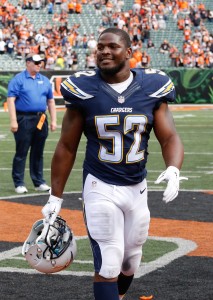 Dupree struggled with the Titans but received interest from two of his former teams — the Falcons and Steelers — this offseason. Dupree tied for the Atlanta lead with 6.5 sacks last season, though he opted for what looks like a situational role in L.A. Dupree did his best work with the Steelers, finishing a six-season run with 11.5- and eight-sack seasons; the latter came in an injury-shortened 2020 season. Now 31, the former first-rounder gives the Bolts a formidable two-deep at OLB, with second-rounder Tuli Tuipulotu flashing alongside Mack as a rookie.
Dupree struggled with the Titans but received interest from two of his former teams — the Falcons and Steelers — this offseason. Dupree tied for the Atlanta lead with 6.5 sacks last season, though he opted for what looks like a situational role in L.A. Dupree did his best work with the Steelers, finishing a six-season run with 11.5- and eight-sack seasons; the latter came in an injury-shortened 2020 season. Now 31, the former first-rounder gives the Bolts a formidable two-deep at OLB, with second-rounder Tuli Tuipulotu flashing alongside Mack as a rookie.
Drafted in Round 2 while the Chargers were still in San Diego, Perryman returns after three seasons away. The off-ball linebacker has been unable to secure favorable terms since his two-year, $12MM Chargers deal came to pass in 2019. The 2015 draftee, however, has remained too good to bench in the years since. Perryman, 31, played regular roles in Las Vegas and Houston. The Miami alum’s past two seasons did not match a 154-tackle 2021 campaign, but like Dupree, he offers a low-cost solution for a Chargers team in transition at linebacker.
Re-signings:
The Chargers only looked to the UDFA ranks to add a QB this offseason, keeping Stick at the QB2 spot on the depth chart after his first run of NFL work. The North Dakota State starter between Carson Wentz and Trey Lance, Stick replaced Herbert after his season-ending thumb injury. The Bolts lost each of Stick’s four starts, including a 63-21 demolition that spelled the end for Telesco and Staley, and he closed the season with a 63.8% completion rate (6.5 Y/A). It is interesting the Harbaugh-Hortiz pair did not do more than add a Division II UDFA (Casey Bauman), sticking with a Telesco-era backup. Though, the QB that defeated Harbaugh’s Wolverines in the 2022 CFP semifinal — TCU’s Max Duggan — remains on the roster.
Notable losses:
- Essang Bassey, CB
- Will Clapp, OL
- Michael Davis, CB
- Austin Ekeler, RB
- Alex Erickson, WR
- Gerald Everett, TE
- Will Grier, QB
- Jalen Guyton, WR
- Jaylinn Hawkins, S
- Justin Hollins, OLB
- Austin Johnson, DL
- Joshua Kelley, RB
- Eric Kendricks, LB (released)
- Corey Linsley, C (released)
- Dean Marlowe, S
- Kenneth Murray, LB
- Tanner Muse, LB
- Nick Vannett, TE
- Mike Williams, WR (released)
- Nick Williams, DL
Two cornerstones of the Telesco era are now on the east coast, with Ekeler and Williams respectively joining the Commanders and Jets. Both skill-position bastions were central figures in the Bolts’ Herbert- and Philip Rivers-centered offenses. While Williams’ cap number had moved to an untenable place, the team let Ekeler walk for barely a $4MM-per-year accord.
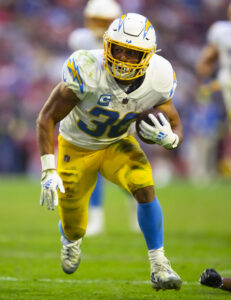 Ekeler lobbied for a new deal and was granted permission to seek a trade when it became clear no extension was coming. Despite Ekeler being tied to a mid-market deal (four years, $24.25MM), not much interest is believed to have developed. Ekeler, 29, then played out the contract and did not fare especially well.
Ekeler lobbied for a new deal and was granted permission to seek a trade when it became clear no extension was coming. Despite Ekeler being tied to a mid-market deal (four years, $24.25MM), not much interest is believed to have developed. Ekeler, 29, then played out the contract and did not fare especially well.
After leading the NFL in touchdowns in 2021 and ’22, Ekeler averaged a career-low 3.5 yards per carry and totaled 1,064 scrimmage yards. The versatile back suffered an early-season high ankle sprain. Saquon Barkley joined Ekeler in sustaining a high ankle sprain in September; the Giants RB landed a much better free agency deal (three years, $37.75MM) compared to the Chargers talent.
The Commanders added Ekeler on a two-year, $8.43MM deal. In terms of guarantees at signing, Ekeler surprisingly checked in eighth ($4.21MM) among free agent backs this year. As teams (the Chargers among them) reevaluated their RB positions over the past several years, three-down players have been prioritized. Ekeler’s pass-oriented skillset, which produced a 993-yard receiving season (2019) and two more 600-plus-yard aerial years, did not end up doing him any favors on a third contract. Not known for a hardnosed between-the-tackles style, Ekeler will attempt to bounce back in Washington as the Chargers pivot to cheaper players who offer better inside skills.
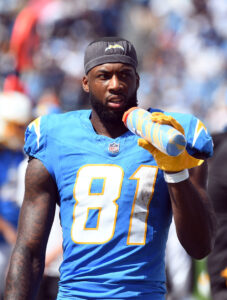 Injuries impeded Williams during much of his Chargers career, though he only missed a significant portion of the schedule last season. Williams’ Week 3 ACL tear brought challenges in a Chargers season that skidded off the rails, and Williams’ absence — after suffering a back fracture in a meaningless Week 18 game in Denver — in the infamous wild-card game in Jacksonville impacted the visitors in a 27-point collapse.
Injuries impeded Williams during much of his Chargers career, though he only missed a significant portion of the schedule last season. Williams’ Week 3 ACL tear brought challenges in a Chargers season that skidded off the rails, and Williams’ absence — after suffering a back fracture in a meaningless Week 18 game in Denver — in the infamous wild-card game in Jacksonville impacted the visitors in a 27-point collapse.
Telesco backed Staley’s decision to play starters in that Week 18 matchup against the Broncos, which did not impact the Chargers’ seed. Weeks into the new regime’s tenure, Williams became the first cap-clearing domino to fall.
Leading the NFL in yards per catch in Rivers’ final Bolts season, Williams served as Herbert’s top long-range option. The Chargers gave the former first-rounder a more multidimensional role in 2021, when he totaled a career-high 1,146 yards. Not as dependable as Allen, Williams will be difficult to replace but had become too pricey — particularly with the 2023 restructure ballooning his 2024 cap hit to $32MM — after two straight injury-marred seasons.
Linsley intends to retire, leaving the game after 10 seasons. An All-Pro in his final Packers season and Pro Bowler in his 2021 Chargers debut, the former fifth-round pick played three seasons on a then-center-record contract (five years, $62.5MM). A non-emergent heart issue shut down Linsley after three games last season, stalling a dependable run with the Bolts. Linsley, who started 99 games with the Packers from 2014-20, did not give up a sack in 33 games as a Charger.
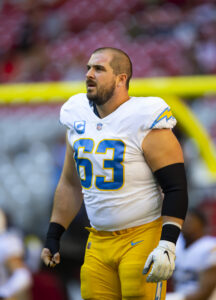 The team is also saving money at tight end, adding to the questions at the skill positions ahead of training camp. Everett delivered midlevel work on his midlevel contract, averaging just 8.1 yards per reception last season — a step down from his 555-yard 2022 showing. The Bolts added less proven receiving TEs — Hayden Hurst, Will Dissly — and spent all of $1MM in combined guaranteed money.
The team is also saving money at tight end, adding to the questions at the skill positions ahead of training camp. Everett delivered midlevel work on his midlevel contract, averaging just 8.1 yards per reception last season — a step down from his 555-yard 2022 showing. The Bolts added less proven receiving TEs — Hayden Hurst, Will Dissly — and spent all of $1MM in combined guaranteed money.
Dissly has excelled as a run blocker, while Hurst has been more effective as a receiver. The former first-round pick does have a 571-yard season (with the 2020 Falcons) on his resume but was struggling before sustaining a season-ending concussion. Receiving a post-traumatic amnesia diagnosis, Hurst had said he would have been ready to play before the season ended, only being shut down due to the Panthers’ season being lost.
Unsurprisingly, the Harbaugh-Hortiz regime passed on paying Murray. The 2020 first-rounder did not live up to his draft slot, being benched in 2021 and grading as a bottom-10 linebacker (per PFF) in 2022 and ’23. Murray did return to a full-time role last season, with he and Kendricks — made a cap casualty for a second straight offseason — being the team’s three-down linebackers. The Titans still see upside in Murray, giving him a two-year, $15.5MM contract.
Draft:
- Round 1, No. 5: Joe Alt (T, Notre Dame) (signed)
- Round 2, No. 34 (via Patriots): Ladd McConkey (WR, Georgia) (signed)
- Round 3, No. 69: Junior Colson (LB, Michigan) (signed)
- Round 4, No. 105: Justin Eboigbe (DL, Alabama) (signed)
- Round 4, No. 137 (from Chargers): Tarheeb Still (CB, Maryland) (signed)
- Round 5, No. 140: Cam Hart (CB, Notre Dame) (signed)
- Round 6, No. 181: Kimani Vidal (RB, Troy) (signed)
- Round 7, No. 225: Brenden Rice (WR, USC) (signed)
- Round 7, No. 253: Cornelius Johnson (WR, Michigan) (signed)
The Williams release and Allen trade ended a seven-season partnership and opened a gaping hole at wide receiver, but Harbaugh laid breadcrumbs about the team going in a different direction. Considering Roman’s presence and comment about a true commitment to the run game, the Bolts passing on Nabers at No. 5 was not too surprising.
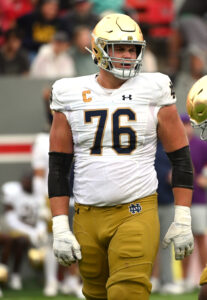 The Chargers held discussions on the No. 5 pick and were mentioned as eager to trade down. But Drake Maye looked to be the driver of notable trade offers. The Giants and Vikings sent trade proposals to the Patriots headlined by 2025 first-round picks, but after New England took Maye, Arizona and Los Angeles did not look to receive comparable offers. This cut into the Chargers’ leverage, moving the team toward an O-line pick. While JC Latham noise emerged close to the draft, Alt had been rumored as Harbaugh’s preference well before the event.
The Chargers held discussions on the No. 5 pick and were mentioned as eager to trade down. But Drake Maye looked to be the driver of notable trade offers. The Giants and Vikings sent trade proposals to the Patriots headlined by 2025 first-round picks, but after New England took Maye, Arizona and Los Angeles did not look to receive comparable offers. This cut into the Chargers’ leverage, moving the team toward an O-line pick. While JC Latham noise emerged close to the draft, Alt had been rumored as Harbaugh’s preference well before the event.
Going with Alt as the highest-drafted O-lineman since Russ Washington in 1968, the Chargers are moving the career-long Notre Dame left tackle to the right side. This will pair Alt and Pro Bowler Rashawn Slater, giving the team three first-round O-linemen — along with guard Zion Johnson — up front. The team is set to have just one new starter up front in 2024 (Alt), but the player he will displace at right tackle — Trey Pipkins — is shifting to right guard. Pipkins has never taken an NFL snap at guard, but Harbaugh’s “best five” approach is in motion.
Notre Dame left tackles Zack Martin and Mike McGlinchey converted to new positions as rookies. Alt will follow McGlinchey by changing tackle spots, as Slater has proven effective in his three-year L.A. run. Alt should bring a high floor to the Bolts, having earned first-team All-American honors in two straight seasons. Forty years after the Chiefs chose Alt’s father — John — in the first round, his son will also become an immediate AFC West starter. Anything short of the Chargers rostering a top-shelf tackle duo will be a disappointment.
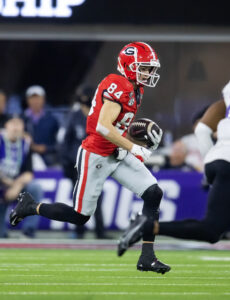 The team circled back to its receiver need to start Day 2, trading up three spots (via the Patriots) for McConkey. While the Chargers could conceivably bring the slot player along slowly due to the presences of Palmer, Johnston and Chark, it should be expected the 6-foot target will be a key part of the 2024 Bolts’ attack.
The team circled back to its receiver need to start Day 2, trading up three spots (via the Patriots) for McConkey. While the Chargers could conceivably bring the slot player along slowly due to the presences of Palmer, Johnston and Chark, it should be expected the 6-foot target will be a key part of the 2024 Bolts’ attack.
Back and ankle injuries limited McConkey in 2023, after he accumulated 762 receiving yards in 2022. He still averaged a career-best 15.9 yards per catch last season. McConkey improved his draft stock by blazing to a 4.39-second 40-yard dash at the Combine. Palmer has proven capable in the slot and has some experience outside, but the former third-round pick is in a contract year. Johnston did not show much as a rookie, which should keep Palmer as a vital presence. As a Harbaugh pick, McConkey is in place to be a potential long-term Palmer successor.
Although the Chargers had no need for J.J. McCarthy, Harbaugh could not resist reuniting with two of his former Michigan charges. The departures of Murray and Kendricks point to an early role for Colson, who is in a unique position of following both his HC and DC to the pros. Colson earned second-team All-Big Ten acclaim in 2022 and ’23. As of now, a Perryman-dependent Bolts LB group looks to have a three-down slot available for Colson.
Other:
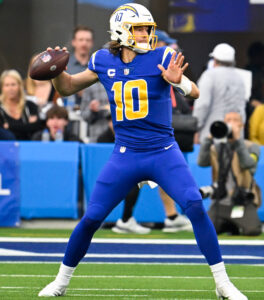 Blockbuster trades involving promising young quarterbacks have occurred. Deshaun Watson represents one case, Jay Cutler another. Those QBs’ situations had deteriorated to varying degrees; the Chargers seriously considering moving Herbert would have been far more stunning. The former Pro Bowl starter attracted Harbaugh’s interest, pulling him back to the NFL, and has shown himself to be one of the game’s most talented throwers.
Blockbuster trades involving promising young quarterbacks have occurred. Deshaun Watson represents one case, Jay Cutler another. Those QBs’ situations had deteriorated to varying degrees; the Chargers seriously considering moving Herbert would have been far more stunning. The former Pro Bowl starter attracted Harbaugh’s interest, pulling him back to the NFL, and has shown himself to be one of the game’s most talented throwers.
Like Rivers, Herbert has been at the controls for some agonizing losses. Harbaugh will be asked to address this franchise-defining problem, with the star QB — who is signed through 2029 — at the root of the solution effort.
Herbert’s left tackle is now signed for two more seasons. The Chargers said goodbye to a few mainstays on offense this offseason and cut costs at a few positions, but Slater should be expected to land in extension rumors in the near future. Andrew Thomas‘ $23.5MM-per-year Giants deal, which came in his first offseason of eligibility, would stand to provide a roadmap. Slater earning a second Pro Bowl nod and doing so under Harbaugh would up his price, as the cap has spiked and fellow 2021 first-rounder Penei Sewell reset the tackle market ($28MM AAV, $85MM guaranteed) in April.
Top 10 cap charges for 2024:
- Joey Bosa, OLB: $26.11MM
- Khalil Mack, OLB: $25.4MM
- Derwin James, S: $19.86MM
- Justin Herbert, QB: $19.35MM
- Trey Pipkins, OL: $8.75MM
- Joe Alt, RT: $6.03MM
- Rashawn Slater, LT: $5.29MM
- Morgan Fox, DL: $4.75MM
- Zion Johnson, G: $4.02MM
- Asante Samuel Jr., CB: $4.02MM
The Chargers made the playoffs just twice in Rivers’ final 10 seasons with the team; they are 1-for-4 with Herbert at the helm. Harbaugh will be tasked with turning an era-defining tide. Harbaugh’s return spices up an AFC West that includes the two-time reigning champions and Sean Payton. In Harbaugh and Herbert, the Bolts have a fascinating combo in place to rebuild this operation. The team that had been viewed as the top Chiefs divisional deterrent for several years fell flat too often despite well-regarded rosters. Harbaugh will put his historic NFL win percentage on the line aiming to bring his quirky but successful M.O. back to the pros.
By Sam Robinson |
at June 26, 2024 10:19 pm
The 2023 Giants offseason brought significant investments from the Joe Schoen regime in Dave Gettleman-era acquisitions. One of those moves has come to define Schoen’s regime. The team’s decision to give Daniel Jones a four-year, $160MM deal with two fully guaranteed seasons, while franchise-tagging Saquon Barkley, ended one long-running partnership and has another on shaky ground. Months after Jones’ ACL tear wrapped a woeful season from the now-well-paid quarterback, Barkley signed with the Eagles.
Following a surprise playoff showing in the Schoen-Brian Daboll partnership’s first season, the Giants tumbled off that tier in 2023. Jones is back in “prove it” territory, while Daboll — his 2022 Coach of the Year accolade notwithstanding — may join his QB in a make-or-break year. This Giants offseason involved key decisions, though it largely boiled down to one call in late April.
Trades:
The Giants look to have benefited from both the Panthers’ regime change and the fallout from the now-infamous rejected Rams trade proposal at the 2022 deadline. It took only a package headlined by a second-round pick for the Giants to pry Burns from the Panthers, who had franchise-tagged the disgruntled edge rusher. Burns, 26, will now team with Kayvon Thibodeaux to give the Giants their best-looking OLB duo since at least Jason Pierre-Paul and Olivier Vernon.
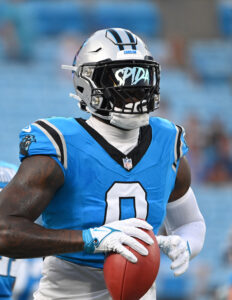 A complex route formed to deliver Burns to New York; a fork in that road emerged in October 2022. As the Panthers regrouped following Matt Rhule‘s firing, they dealt Christian McCaffrey to the 49ers for four picks. None of those was a first-rounder. Other Carolina cogs drew extensive interest, with Burns at the front of that pack. Shortly after the Rams missed out on McCaffrey, the team — at the end of its “eff them picks” period — attempted to add a reinforcement to a sinking Super Bowl title defense by offering two first-rounders and a third for Burns.
A complex route formed to deliver Burns to New York; a fork in that road emerged in October 2022. As the Panthers regrouped following Matt Rhule‘s firing, they dealt Christian McCaffrey to the 49ers for four picks. None of those was a first-rounder. Other Carolina cogs drew extensive interest, with Burns at the front of that pack. Shortly after the Rams missed out on McCaffrey, the team — at the end of its “eff them picks” period — attempted to add a reinforcement to a sinking Super Bowl title defense by offering two first-rounders and a third for Burns.
Still owing the Lions their 2023 first-rounder from the Matthew Stafford trade, the Rams could not offer their 2023 first. That turned out to matter, as then-GM Scott Fitterer — whose job security was unstable after David Tepper axed Rhule — viewed the opportunity to discuss an extension with Burns as more valuable than 2024 and ’25 firsts. Denying Burns a chance to land in Los Angeles with a likely extension awaiting reframed the Panthers’ re-up talks with their top pass rusher.
Irked at Carolina turning down a big trade offer that doubled as a path for an L.A. extension, Burns did not come to terms with the team that drafted him. As Burns’ asking price soared, Fitterer balked at extending him in 2023. After Fitterer’s firing, the Panthers took what they could get — after pausing extension talks in early March — and finally cut bait.
Burns and the Panthers were not believed to be close on terms, as the five-year veteran pushed for a deal in the $30MM-per-year range before Nick Bosa became the NFL’s first $30MM-AAV edge rusher. Burns asking for terms bettering T.J. Watt‘s Steelers extension understandably spooked the Panthers, who did receive trade offers for the Ron Rivera-era draftee at last year’s deadline. Of course, those proposals are not believed to have come in near where the Rams went.
 The Giants gave Burns a five-year, $141MM extension upon completing the trade. Not seeing Azeez Ojulari deliver consistency alongside Thibodeaux, the Giants greenlit a big-ticket deal that should pair well — for the time being, at least — with their top-10 pick’s rookie contract. Although the Jaguars’ Josh Allen passed Burns this spring, the new Giants OLB still ranks third among edges in AAV ($28.2MM) and fourth in total guarantees ($87.5MM) and fully guaranteed money ($76MM). Much will be expected from a player who has proven reliable while settling in outside the top tier, production-wise, at his position.
The Giants gave Burns a five-year, $141MM extension upon completing the trade. Not seeing Azeez Ojulari deliver consistency alongside Thibodeaux, the Giants greenlit a big-ticket deal that should pair well — for the time being, at least — with their top-10 pick’s rookie contract. Although the Jaguars’ Josh Allen passed Burns this spring, the new Giants OLB still ranks third among edges in AAV ($28.2MM) and fourth in total guarantees ($87.5MM) and fully guaranteed money ($76MM). Much will be expected from a player who has proven reliable while settling in outside the top tier, production-wise, at his position.
While Jones’ AAV checks in beyond Burns’, the latter received the most guaranteed money in Giants history. Burns is 1-for-5 in 10-plus-sack seasons, totaling 12.5 in 2022, and he ranks just 12th in sacks since 2019 (46). In terms of QB hits since Burns entered the league, he ranks 14th (95). The Florida State alum has certainly done well for himself despite solid but unspectacular work in Charlotte, though he was asked to deliver high-end production despite his team playing from behind more often than not.
Thibodeaux registered 11.5 sacks on a bad team last season. He certainly stands to benefit from Burns’ presence, and it will be interesting to see how the Giants proceed when their younger OLB becomes extension-eligible. That point comes in January, though with a fifth-year option in place to extend Thibodeaux’s rookie deal through 2025, the Giants have some time with their current arrangement. Burns’ 2024 and ’25 salaries are guaranteed at signing. If he is on the Giants’ roster on Day 5 of the 2025 league year, his full 2026 salary is guaranteed.
This is a big commitment for the Giants, who also looked into Bryce Huff. The team presumably inquired about Huff before Burns talks accelerated, though the trade negotiations with Carolina — which featured extensive familiarity considering Schoen worked with the Panthers for nearly 20 years and worked with Morgan in Buffalo — began well before the trade came to pass.
Free agency additions:
- Jon Runyan Jr., G. Three years, $33MM ($17MM guaranteed)
- Devin Singletary, RB. Three years, $16.5MM ($9.5MM guaranteed)
- Jermaine Eluemunor, OL. Two years, $14MM ($6.75MM guaranteed)
- Drew Lock, QB. One year, $5MM ($4.95MM guaranteed)
- Matthew Adams, LB. One year, $1.29MM ($968K guaranteed)
- Austin Schlottmann, OL. One year, $1.4MM ($500K guaranteed)
- Jalen Mills, DB. One year, $1.38MM ($468K guaranteed)
- Gunner Olszewski, WR. One year, $1.13MM ($468K guaranteed)
- Jordan Phillips, DT. One year, $1.79MM ($430K guaranteed)
- Carter Coughlin, LB. One year, $1.29MM ($368K guaranteed)
- Jack Stoll, TE. One year, $1.12MM ($327K guaranteed)
- Chris Manhertz, TE. One year, $1.38MM ($118K guaranteed)
- Miles Boykin, WR. One year, $1.29MM ($118K guaranteed)
- Aaron Stinnie, G. One year, $1.29MM ($100K guaranteed)
- Isaiah McKenzie, WR. One year, $1.38MM ($75K guaranteed)
- Matt Nelson, OL. One year, $1.29MM ($75K guaranteed)
- Darnay Holmes, CB. One year, $2MM ($50K guaranteed)
- Allen Robinson, WR. One year, $1.31MM ($25K guaranteed)
- Tre Herndon, CB. One year, $1.13MM
- David Long, CB. One year, $1.13MM
- Jacob Saylors, RB. One year, $795K
Daboll brought in multiple former Bills pieces this offseason, the Singletary move being the most notable. After producing on a near-veteran-minimum contract with the Texans, the sixth-year RB will be tasked with replacing Saquon Barkley in New York. Barkley and Singletary are on different talent planes, as their respective contracts illustrated in March; the Giants believe they will be able to get by with the latter, who still quadrupled his guarantee figure from 2023.
 Singletary, 26, operated in Daboll’s offense over his first three seasons. During that span, the Bills used the 5-foot-7 back as their primary option behind Josh Allen. Despite drafting Zack Moss in the 2020 second round, Buffalo kept Singletary in the lead role. The ex-Florida Atlantic standout — a 2019 third-round pick — missed just one game over his final three Bills seasons and has offered reliable production. From 2021-23, Singletary totaled between 1,091 and 1,099 scrimmage yards. He has not offered too much as a receiver, never eclipsing 280 yards in a season. Receiving production from backs — a Barkley strong suit at points — will be an area to monitor within the Giants’ offense this season.
Singletary, 26, operated in Daboll’s offense over his first three seasons. During that span, the Bills used the 5-foot-7 back as their primary option behind Josh Allen. Despite drafting Zack Moss in the 2020 second round, Buffalo kept Singletary in the lead role. The ex-Florida Atlantic standout — a 2019 third-round pick — missed just one game over his final three Bills seasons and has offered reliable production. From 2021-23, Singletary totaled between 1,091 and 1,099 scrimmage yards. He has not offered too much as a receiver, never eclipsing 280 yards in a season. Receiving production from backs — a Barkley strong suit at points — will be an area to monitor within the Giants’ offense this season.
Next Gen Stats gave Singletary a mid-pack ranking in rush yards over expected, but he outplayed the one-year, $1.77MM Houston contract. The Texans turned to Singletary over Dameon Pierce to help their C.J. Stroud-piloted operation to the playoffs. Singletary also ran behind a makeshift offensive line for much of the season, as the Texans dealt with injuries basically everywhere Shaq Mason was not playing up front. Singletary notched a career-high 898 rushing yards, though the Texans did not offer him as much as they ended up paying Joe Mixon (three years, $19.75MM; $13MM guaranteed at signing).
Big Blue did not offer Barkley much blocking aid, and last year involved a spate of injuries. The team tried a low-cost approach at guard last season; the effort failing prompted more spending in 2024. Enter Runyan and Eluemunor, who are in place at left and right guard.
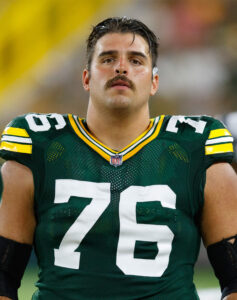 Having given Elgton Jenkins a top-market contract, the Packers predictably let Runyan walk. The latter will play his home games in the stadium where his father, a longtime Eagles right tackle, frequently tussled with Michael Strahan. One of five UFA guards to draw an eight-figure-per-year contract this offseason, Runyan brings three years of starter experience to New York. PFR’s No. 32 overall free agent, Runyan should be a big upgrade from recent Giants guard offerings.
Having given Elgton Jenkins a top-market contract, the Packers predictably let Runyan walk. The latter will play his home games in the stadium where his father, a longtime Eagles right tackle, frequently tussled with Michael Strahan. One of five UFA guards to draw an eight-figure-per-year contract this offseason, Runyan brings three years of starter experience to New York. PFR’s No. 32 overall free agent, Runyan should be a big upgrade from recent Giants guard offerings.
The $10MM-per-year blocker logged full seasons at both guard positions, shifting to RG to accommodate Jenkins’ move back inside during the 2022 season. A 50-game starter, the former sixth-round pick ranked 17th among interior O-linemen in pass block win rate last season. Pro Football Focus slotted Runyan 47th among guards.
This year marks a new position and foreign contractual territory for Eluemunor, who had played on three straight one-year deals (none eclipsing $3MM) with the Raiders. The low-cost starter parlayed his work at right tackle and right guard into a midlevel contract. Eluemunor, 29, started 31 games — mostly at RT — for the Raiders over the past two seasons. PFF rated the former Ravens fifth-rounder 36th among tackles in 2023.
The Giants’ decision to give Evan Neal another shot at right tackle will kick Eluemunor inside, where has not played regularly since 2021. Even in his 2021 Raiders debut, Eluemunor only logged 266 snaps at guard. He did not see any time there last season. PFF has rated Neal as a bottom-two tackle regular in each of the past two seasons, and he is coming off a midseason foot fracture — an injury initially misdiagnosed as a sprained ankle — that sidelined him throughout the Giants’ offseason program.
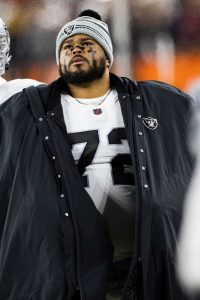 Eluemunor looms as an emergency fix for the Giants, who have some interior insurance in Stinnie — who started in Super Bowl LV and made 11 starts last season — and Schlottmann (14 career starts in Denver and Minnesota). The Giants have converted guard Joshua Ezeudu tentatively in place as their swing tackle, but the 2022 third-rounder allowed five sacks despite playing just 266 snaps in place of Andrew Thomas last season.
Eluemunor looms as an emergency fix for the Giants, who have some interior insurance in Stinnie — who started in Super Bowl LV and made 11 starts last season — and Schlottmann (14 career starts in Denver and Minnesota). The Giants have converted guard Joshua Ezeudu tentatively in place as their swing tackle, but the 2022 third-rounder allowed five sacks despite playing just 266 snaps in place of Andrew Thomas last season.
The offseason additions aside, Neal’s development remains paramount in New York, as the Schoen regime drafted him seventh overall. Neal continuing down this road would remind of Ereck Flowers‘ underwhelming (in New York, that is) career path.
Before the Giants came to terms with Lock, they were on the Jameis Winston radar. The latter ended up in Cleveland, helping lead Lock to the Big Apple. A run of rumors has emerged regarding Lock’s role, and while the ex-Broncos and Seahawks QB has not been a team’s preferred starter since Teddy Bridgewater‘s second 2021 concussion forced Vic Fangio to move Lock back into his lineup, the former second-round pick has been mentioned as a possible Jones competitor at multiple points this offseason.
Seahawks GM John Schneider said the prospect of a competition with Jones helped lure Lock away from Seattle, and NFL.com’s Daniel Jeremiah noted shortly after the draft the Missouri alum carries a legitimate shot at wresting the job from Jones. Lock has said he expects his role to be a Jones backup, and Daboll pushed back on the notion this will be a competition. Lock seeing starts may not remind of the ignominious Mike Glennon stretch, but if the Giants are starting the inconsistent ex-Broncos option without Jones having suffered an injury, the team’s big-picture plan will have veered well off course.
 Lock’s only full season as a starter (2020) featured him leading the NFL in INTs (15) despite only finishing 12 games. The Broncos traded for Bridgewater to demote the John Elway-era draftee and then included him in 2022’s blockbuster Russell Wilson trade. Despite Lock initially being viewed as more likely to succeed Wilson in Seattle, he lost a battle with Geno Smith and never threatened the eventual Comeback Player of the Year’s job security again.
Lock’s only full season as a starter (2020) featured him leading the NFL in INTs (15) despite only finishing 12 games. The Broncos traded for Bridgewater to demote the John Elway-era draftee and then included him in 2022’s blockbuster Russell Wilson trade. Despite Lock initially being viewed as more likely to succeed Wilson in Seattle, he lost a battle with Geno Smith and never threatened the eventual Comeback Player of the Year’s job security again.
Lock, 27, is a career 59.7% passer who holds a 6.7 yards-per-attempt figure. The Giants could look to park Jones late in the season — similar to the Raiders and Broncos’ actions with their starters over the past two years — in a bubble-wrap scenario that prevents $12MM in injury guarantees from entering the equation, but that would seemingly only come up if the team is well out of the playoff mix. Still, Lock represents an interesting wild card whose usage could be telling about the franchise’s immediate future.
Wilson’s short free agency tour stopped through New York, though this “what if” involving a Giants QB investment did not rival the one that came in April. Wilson, who ended up with the Steelers on a vet-minimum deal, would have likely held the upper hand on Jones in a competition. As of now, Lock is intriguing insurance.
Re-signings:
Notable losses:
- Saquon Barkley, RB
- Ben Bredeson, G
- Matt Breida, RB
- Gary Brightwell, RB (waived/injured)
- Cam Brown, LB
- Randy Bullock, K
- Parris Campbell, WR
- Jarrad Davis, LB
- Jacob Eason, QB
- Mark Glowinski,G (released)
- Sean Harlow, OL
- Adoree’ Jackson, CB
- Xavier McKinney, S
- Matt Peart, T
- Tyre Phillips, OL
- Justin Pugh, OL
- A’Shawn Robinson, DL
- Sterling Shepard, WR
- Jack Stoll, TE
- Tyrod Taylor, QB
- Darren Waller, TE (retired)
- Jihad Ward, DL
- Cade York, K
 In terms of accomplishments, Frank Gifford is the best running back in Giants history. Production-wise, it is Tiki Barber, who still sits in the top 30 on the NFL’s rushing yardage list. For sheer talent, it is difficult to beat Barkley, whom the Giants hoped would make a Canton case someday. If Barkley is to launch a Hall of Fame case, he will need to make significant contributions in Philadelphia.
In terms of accomplishments, Frank Gifford is the best running back in Giants history. Production-wise, it is Tiki Barber, who still sits in the top 30 on the NFL’s rushing yardage list. For sheer talent, it is difficult to beat Barkley, whom the Giants hoped would make a Canton case someday. If Barkley is to launch a Hall of Fame case, he will need to make significant contributions in Philadelphia.
The Giants closed a six-year Barkley partnership by determining they did not want to pay what it required — or even close to it — to employ the two-time Pro Bowler in 2024. That will mean, barring injury, two games against Barkley this season.
The team made it clear in 2023 Jones would be its priority and Barkley the secondary concern. Positional value supported this stance, despite Barkley being a far superior player. Barkley played the season on a $10.1MM franchise tag. Barkley suffered a high ankle sprain early in the season, but he exited 2023 a safer bet following Jones’ ACL tear. As the Giants launched a serious research effort to consider adding a Jones replacement, Barkley said they were not among the four teams to make an offer (though, Barkley and Schoen’s accounts may differ here, as a recent Hard Knocks trailer dangled). This led to a three-year, $37.75MM Eagles agreement.
Read more
Even amid another macro reevaluation of RB importance, Barkley was proven right about his value. Before applying the tag in 2023, the Giants submitted multiple offers. The July 2023 proposal featured a guarantee figure around $22MM, but the Giants reduced the AAV below $12MM in that proposal. Barkley passed, pocketed the $10.1MM tag salary and will add $26MM more fully guaranteed on his Eagles deal. Barkley fared best of this year’s deep free agency RB class, becoming the NFL’s fourth-highest-paid RB. Though, his guarantees at signing lead the pack.
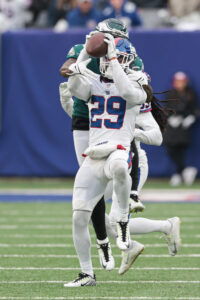 Next Gen Stats slotted Barkley 10th in RYOE last season, which also featured the former Offensive Rookie of the Year match his TD total (10) from 2022 despite missing three games. Barkley amassed 962 rushing yards, averaging 68.7 per game; both totals ranked fourth in his career.
Next Gen Stats slotted Barkley 10th in RYOE last season, which also featured the former Offensive Rookie of the Year match his TD total (10) from 2022 despite missing three games. Barkley amassed 962 rushing yards, averaging 68.7 per game; both totals ranked fourth in his career.
Passing a on second tag, the Giants still held discussions with Barkley’s team at the Combine. Schoen and Co. ended up viewing Barkley’s age (27) as an issue regarding another payment. They ended up with Singletary, who is just seven months younger. Though, Singletary has been far more durable than Barkley, who has missed 25 games due to injury. Singletary also has 1,063 career touches to Barkley’s 1,489.
The Giants did consider transition-tagging McKinney, which would have cost them $13.8MM. This amount that did not stop the Patriots from keeping Kyle Dugger off the market, but in an offseason that saw safety value take a hit, the Giants passed on paying McKinney. It turned out to be quite costly to acquire McKinney, whom the Packers gave a four-year deal worth $67MM. McKinney’s camp gave the Giants the chance to match the offer; they did not, ending this partnership after four years. McKinney’s Big Apple stay reminds of Landon Collins‘ initial stint, with both coming to New York as second-rounders from Alabama before each left for monster paydays.
Green Bay gave McKinney a top-four safety contract, an agreement that continues to strip away safety talent from New York’s roster. With an eye on a McKinney extension, the Giants let Julian Love defect to the Seahawks in 2023. The Giants and McKinney tabled talks to 2024, but in an offseason that featured no other free agent safety fetch more than $8MM per year, McKinney’s market was strong.
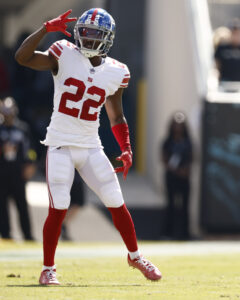 Pro Football Focus ranked McKinney as the NFL’s fourth-best safety last season and the best overall coverage player at the position. A zero-time Pro Bowler who missed chunks of the 2020 and ’22 seasons with injuries, McKinney made a claim about being the NFL’s best safety this offseason. His contract nearly reflected the boast, and with he and Love both gone, the Giants are pivoting to a secondary full of rookie-contract players.
Pro Football Focus ranked McKinney as the NFL’s fourth-best safety last season and the best overall coverage player at the position. A zero-time Pro Bowler who missed chunks of the 2020 and ’22 seasons with injuries, McKinney made a claim about being the NFL’s best safety this offseason. His contract nearly reflected the boast, and with he and Love both gone, the Giants are pivoting to a secondary full of rookie-contract players.
The Giants appeared prepared to let Jackson leave after his three-year contract expired. A Gettleman-era signee, Jackson started throughout his Giants tenure and played a key role in helping the team to a wild-card win. After missing extended time with an MCL sprain down the stretch in 2022, Jackson helped the Giants contain Justin Jefferson. Last season, which began with an unexpected move to the slot to accommodate rookie Tre Hawkins, did not generate momentum for the former first-rounder. PFF rated Jackson 117th among corners. Jackson’s completion rate and passer rating as the closest defender skyrocketed from 2022. Ahead of an age-29 season, the ex-Titan remains unsigned.
With plans to part with Jackson, the Giants hosted both Tre’Davious White and Darious Williams on visits; both ended up with the Rams. New York did not add a significant piece at this position in free agency, though Herndon — a Jaguars regular for the past five seasons — has 34 career starts and extensive slot experience. While Herndon figures to compete with Holmes and rookie Andru Phillips for the slot gig, the Giants are preparing to shift previous slot patrolman Cor’Dale Flott to the outside role opposite Deonte Banks.
 Lasting only 12 games, Waller’s Giants tenure disappointed. The Giants shipped the third-rounder they received in the Kadarius Toney trade to the Raiders for Waller, who had battled injuries near the end of his Las Vegas tenure. When healthy, Waller had been one of the NFL’s best pass-catching tight ends. More hamstring trouble intervened for the former Pro Bowler, however, leading to a midseason run of absences. The high-priced TE finished with 552 receiving yards, showing signs of his Oakland/Vegas version. But he recently confirmed retirement rumors that circulated in March, leaving the NFL before his 32nd birthday.
Lasting only 12 games, Waller’s Giants tenure disappointed. The Giants shipped the third-rounder they received in the Kadarius Toney trade to the Raiders for Waller, who had battled injuries near the end of his Las Vegas tenure. When healthy, Waller had been one of the NFL’s best pass-catching tight ends. More hamstring trouble intervened for the former Pro Bowler, however, leading to a midseason run of absences. The high-priced TE finished with 552 receiving yards, showing signs of his Oakland/Vegas version. But he recently confirmed retirement rumors that circulated in March, leaving the NFL before his 32nd birthday.
Citing diminished desire and detailing a medical event that left him hospitalized for three days, Waller will leave the NFL after nine seasons. Though, a few of those came as he struggled with substance abuse as a Ravens wide receiver. The veteran’s exit leaves the Giants in a dire TE situation.
Despite Waller retirement breadcrumbs, the Giants passed on adding a receiving tight end in free agency. Their draft investment — fourth-rounder Theo Johnson — did average 16.4 yards per catch in 2022. But he never topped 350 receiving yards in a Penn State season. A competition between Johnson, Lawrence Cager and 2022 fourth-rounder Daniel Bellinger is on tap. Cager and Johnson received offseason first-team reps, and while Bellinger — the team’s top 2023 backup — was out with an injury, the less proven pieces may be vying for the pass-catching TE role.
Draft:
- Round 1, No. 6: Malik Nabers (WR, LSU) (signed)
- Round 2, No. 47 (from Seahawks): Tyler Nubin (S, Minnesota) (signed)
- Round 3, No. 70: Andru Phillips (CB, Kentucky) (signed)
- Round 4, No. 107: Theo Johnson (TE, Penn State) (signed)
- Round 5, No. 166 (from 49ers through Panthers): Tyrone Tracy Jr. (RB, Purdue) (signed)
- Round 6, No. 183: Darius Muasau (LB, UCLA) (signed)
 Daniel Jones‘ knee injury did not tank the Giants to a place necessary to pull off their 2024 goal; Tyrod Taylor and Tommy DeVito combined to deliver five wins. Rumors about the Giants attempting to reset at quarterback with a draft pick, as Jones’ $81MM in guarantees are done after this year, surfaced quickly after the November ACL tear. But the 6-11 record secured the No. 6 overall draft slot. The Giants’ QB research project turned out to produce a clear line of demarcation, and the team’s draft slot proved insufficient to land the passer this front office coveted.
Daniel Jones‘ knee injury did not tank the Giants to a place necessary to pull off their 2024 goal; Tyrod Taylor and Tommy DeVito combined to deliver five wins. Rumors about the Giants attempting to reset at quarterback with a draft pick, as Jones’ $81MM in guarantees are done after this year, surfaced quickly after the November ACL tear. But the 6-11 record secured the No. 6 overall draft slot. The Giants’ QB research project turned out to produce a clear line of demarcation, and the team’s draft slot proved insufficient to land the passer this front office coveted.
Although rumors connected the Giants to J.J. McCarthy weeks away from the draft, April buzz centered around Drake Maye. The two-year North Carolina starter became the Giants (and Vikings’) preferred option, and the player once viewed as the clear second option to Caleb Williams in this class drew notable trade offers as the No. 3 overall pick neared.
After longtime Jones backer John Mara OK’d a first-round QB pick, the Giants offered Nos. 6 and 47, along with their 2025 first-rounder, for the Pats’ No. 3 slot. Considering the Giants have finished poorly enough to secure top-10 draft slots six times since 2015 and have some rather long odds at 2024 success, the Patriots had a viable offer on the table. Accepting it would have changed the Giants’ plans and turned Jones into a bridge quarterback.
New England declining New York’s trade gave Jones yet another chance, as the Giants — after visits with McCarthy, Michael Penix Jr. and Bo Nix — did not deem any member of the trio as worthy of the No. 6 pick. Jones’ contract structure leaves the team in limbo, as rumors tying Big Blue to the 2025 QB crop will emerge, but the team is giving the 2019 No. 6 overall pick what almost definitely amounts to a last chance.
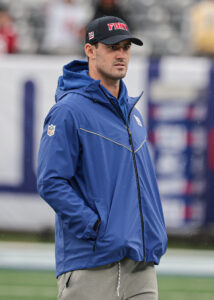 Jones succeeded under these circumstances in 2022, powering a moderately talented team to the playoffs. The Giants then became the only team in the fifth-year option era (2011-present) to decline a QB’s option and then re-sign him. Jones, 27, is now coming off a major injury that stands to limit his run-game effectiveness. Considering how pivotal that dimension was (708 yards) to Jones in 2022, the ACL injury keeping him in the pocket more often would increase his degree of difficulty at convincing the Giants to pay his nonguaranteed 2025 salary ($30MM, with a $41.6MM cap hit). Jones will have better aerial options, at least, while he attempts another bounce-back effort.
Jones succeeded under these circumstances in 2022, powering a moderately talented team to the playoffs. The Giants then became the only team in the fifth-year option era (2011-present) to decline a QB’s option and then re-sign him. Jones, 27, is now coming off a major injury that stands to limit his run-game effectiveness. Considering how pivotal that dimension was (708 yards) to Jones in 2022, the ACL injury keeping him in the pocket more often would increase his degree of difficulty at convincing the Giants to pay his nonguaranteed 2025 salary ($30MM, with a $41.6MM cap hit). Jones will have better aerial options, at least, while he attempts another bounce-back effort.
A QB-or-WR decision had long defined this Giants draft, and the Nabers choice will attempt to solve a years-long issue. Since their March 2019 Odell Beckham Jr. trade, the Giants have whiffed on two wideout investments (Kenny Golladay, Kadarius Toney) and grounded out (Golden Tate) on another. Three years after the Gettleman regime eyed DeVonta Smith — only to see the Eagles pounce as pre-draft rumors of Giants interest circulated — the team has Nabers to help a quarterback that has never played with a WR1-level talent. Darius Slayton has been the team’s top wideout by default; he would not qualify as a No. 2 option for several clubs.
Submitting a dominant season to close his LSU career and help Jayden Daniels win the Heisman, Nabers gives the Giants their best receiver hope since Beckham. After a 1,000-yard 2022 showing, Nabers went for 1,569 yards and 14 TDs. He dropped a 4.35-second 40 time at his pro day, and some teams rated him higher than the more polished Marvin Harrison Jr.
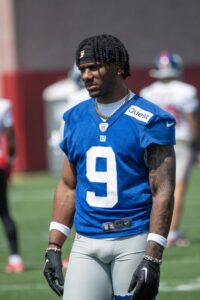 The Nabers backers viewed him as more explosive compared to the well-rounded Ohio State product. The Giants will find out, as Nabers should be set to immediately become the team’s top weapon. This stands to drop Slayton in the pecking order, though he and Schoen Day 2 picks Wan’Dale Robinson and Jalin Hyatt comprise a better WR corps compared to what Jones worked with in 2022.
The Nabers backers viewed him as more explosive compared to the well-rounded Ohio State product. The Giants will find out, as Nabers should be set to immediately become the team’s top weapon. This stands to drop Slayton in the pecking order, though he and Schoen Day 2 picks Wan’Dale Robinson and Jalin Hyatt comprise a better WR corps compared to what Jones worked with in 2022.
Not re-signing McKinney or Jackson, the Giants devoted Day 2 to their secondary. Nubin and Phillips are each expected to vie for immediate roles. The Giants grabbed a Minnesota alum in Round 2 for the second straight year, as Nubin follows center John Michael Schmitz. Nubin intercepted a career-high five passes in 2023, earning first-team All-Big Ten acclaim. While Jason Pinnock sits as a Giants safety starter, it would seemingly take an underwhelming training camp to keep Nubin from landing the other first-string post over Dane Belton.
While the Giants did end up using a fifth-rounder on a running back for the second straight year, they were connected to USC’s MarShawn Lloyd and hosted Texas’ Jonathon Brooks on a “30” visit. The latter development influenced the Panthers to trade one spot in front of the Giants in Round 2 to nab Brooks. Tracy and Eric Gray, barring a veteran option being added — a rumored scenario — will compete for carries behind Singletary.
Other:
Reports of tension between Daboll and both his top coordinators emerged during last season. While Kafka remains — albeit with a potential demotion due to rumblings about the HC taking over play-calling duties — Martindale cursed out his former boss on his way out. The two-year Giants DC, who did not have ties to Daboll prior to New York, was viewed as disobedient at points last season. He and longtime assistant Drew Wilkins, whom Daboll fired to prompt the shouting match, had been accused of effectively going rogue. Martindale, who drew HC interest in 2023, is now Michigan’s DC.
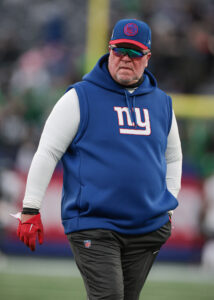 A lengthy replacement search — which included the Panthers blocking an Ejiro Evero meeting — ended with Bowen, a six-year Mike Vrabel assistant who called defensive plays in Tennessee for the past three seasons. The Titans ranked sixth in scoring defense during a 2021 season that produced an AFC No. 1 seed, but amid regular injuries, the unit fared worse over the past two seasons. DVOA did place Bowen’s final Titans unit 18th, which bettered his blitz-happy predecessor’s work (21st).
A lengthy replacement search — which included the Panthers blocking an Ejiro Evero meeting — ended with Bowen, a six-year Mike Vrabel assistant who called defensive plays in Tennessee for the past three seasons. The Titans ranked sixth in scoring defense during a 2021 season that produced an AFC No. 1 seed, but amid regular injuries, the unit fared worse over the past two seasons. DVOA did place Bowen’s final Titans unit 18th, which bettered his blitz-happy predecessor’s work (21st).
Bowen used a 3-4 base scheme throughout his Titans tenure; that will help make a Giants transition smooth. It is interesting Bowen is working with several Martindale assistants, minus the Wilkins brothers. That will be a Giants subplot to monitor as the defense takes shape.
Leading the Giants in receiving yards in four of the past five seasons, Slayton became the team’s de facto WR1 due to the team’s above-referenced missteps at the position. He re-emerged from a rare rookie-contract pay cut in 2022 to lead the Giants’ playoff squad in receiving and, amid QB issues, managed to cross 700 yards for a fourth time in 2023. Slayton, 27, attempted to secure better terms entering the second season of a two-year, $12MM deal. The Giants drafting Nabers cut into Slayton’s leverage, and it did not take much in the way of incentives to bring him back to OTAs.
Top 10 cap charges for 2024:
- Daniel Jones, QB: $47.86MM
- Andrew Thomas, LT: $23.26MM
- Brian Burns, OLB: $15.5MM
- Dexter Lawrence, DT: $14.58MM
- Bobby Okereke, ILB: $11.21MM
- Kayvon Thibodeaux, OLB: $8.55MM
- Darius Slayton, WR: $7.95MM
- Graham Gano, K: $7.21MM
- Evan Neal, RT: $6.7MM
- Jon Runyan Jr., G: $6.5MM
Barring restructures or extensions, Deshaun Watson and Dak Prescott are on pace to shatter the record for cap hits. Quietly, Jones is also in position to eclipse that mark. Seeing as the Giants will not want to add dead money on Jones’ deal beyond 2024, they are unlikely to restructure the contract to create cap space.
Beyond the incessant scrutiny on Jones, the Giants will attempt to show last season was an injury-driven fluke and stay the course. Logging only one season of 20-plus touchdown passes (2019) and one year in the QBR top half (2022), the Eli Manning successor will enter a sixth season as a starter. Jones hovers at the center of the Giants’ rebound effort, but after so much went into a mission to identify his potential replacement, it would appear more likely than not the team is looking for a new starting QB in 2025. Until then, the Giants will attempt to surprise with their collection of Gettleman-era cornerstones (sans Barkley and McKinney) and Schoen draft choices in a division again expected to feature an Eagles-Cowboys duel at the top.
By Sam Robinson |
at September 9, 2023 10:59 pm
Quarterback acquisitions generated top headlines this offseason, while the slew of developments affecting the running back market moved that position’s value to a precarious point. On that note, our latest Offseason In Review series is in the books. Here are the PFR staff’s looks at how teams assembled their 2023 rosters:
AFC East
AFC North
AFC South
AFC West
NFC East
NFC North
NFC South
NFC West
By Ben Levine |
at September 9, 2023 6:00 pm
Following a busy offseason in 2022, the Dolphins didn’t take nearly as many swings in 2023.
It’s hard to blame them. The front office didn’t have to make up for any mistakes from last spring, as the team’s major acquisitions (receiver Tyreek Hill and offensive tackle Terron Armstead) both proved to be worth the investment. The organization also seemed to make the right decision in Mike McDaniel, as the head coach helped guide the Dolphins to their first playoff appearance since the 2016 season.
The Dolphins are clearly hoping that they can take another step forward during McDaniel’s second season at the helm. Of course, much of the team’s success will depend on the health of Tua Tagovailoa, but the team made enough offseason moves to remain in the playoff conversation heading into the 2023 campaign.
Trades:
For the second-straight offseason, the Dolphins made their biggest splash via trade, as they acquired one of the league’s top cornerbacks. Jalen Ramsey was more than productive during his three-plus seasons with the Rams, earning Pro Bowl nods each season while also being named to a pair of first-team All-Pro squads.
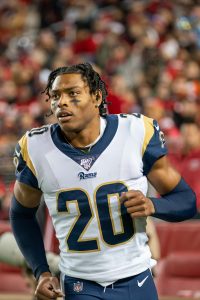 He didn’t earn the same accolades in 2022, but it was still a standout season for the veteran. Ramsey didn’t miss a game for the first time since 2018 while establishing career highs in tackles (88), passes defended (18), and interceptions (four). The 28-year-old ended up grading out as Pro Football Focus’ third-overall cornerback (among 118 qualifiers), and he paced the position with his run defense score.
He didn’t earn the same accolades in 2022, but it was still a standout season for the veteran. Ramsey didn’t miss a game for the first time since 2018 while establishing career highs in tackles (88), passes defended (18), and interceptions (four). The 28-year-old ended up grading out as Pro Football Focus’ third-overall cornerback (among 118 qualifiers), and he paced the position with his run defense score.
The Dolphins clearly identified cornerback as a need heading into the offseason. Miami’s defense struggled in 2022, particularly against the pass. Miami ranked 27th in passing yards allowed per game and 29th in interceptions. The Dolphins’ need was only magnified when it was revealed that Byron Jones was unlikely to play again, leading to his release.
Unfortunately for the Dolphins, the team won’t immediately get to see their new acquisition on the field. Ramsey suffered a torn meniscus during training camp, keeping him on the sideline for the first few months of the season. There was initial hope that Ramsey could be ready for the season opener, but his placement on injured reserve assures that he won’t see the field until Week 5 at the earliest.
Elsewhere on the trade front, the Dolphins swapped cornerbacks with the Cowboys before the roster deadline. The team gave up on former first-round pick Noah Igbinoghene, who appeared in 32 games for the Dolphins across three seasons. In exchange, they received Kelvin Joseph, a former second-rounder who played the majority of his snaps on special teams over the past two seasons in Dallas.
The Dolphins added Dan Feeney to their offensive line mix during the offseason, guaranteeing $3.13MM of his salary in the process. The veteran was ultimately squeezed off the roster, but the front office managed to find a taker in the Bears vs. cutting him for nothing.
Free agency additions:
- Eli Apple, CB: One year, $1.41MM ($500K guaranteed)
- Jake Bailey, P: One year, $1.23MM ($1.09MM guaranteed)
- Braxton Berrios, WR: One year, $3.5MM ($1.5MM guaranteed)
- DeShon Elliott, S: One year, $1.77MM ($1.08MM guaranteed)
- Tyler Kroft, TE: One year, $1.29MM ($1.16MM guaranteed)
- David Long, LB: Two years, $11MM ($6.5MM guaranteed)
- Mike White, QB: Two years, $8MM ($4.5MM guaranteed)
- Isaiah Wynn, OT: One year, $2.3MM ($1.96MM guaranteed)
Miami used free agency to fill some key backup spots on their roster. The team’s biggest acquisition was linebacker David Long, who was added to the linebackers room following four seasons with the Titans. The former sixth-round pick saw a larger role during each of his four seasons in Tennessee, culminating in a 2022 campaign where he compiled a career-high 86 tackles. 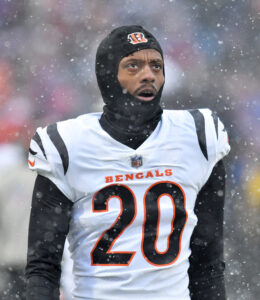 Long has missed time in each of his four NFL seasons, but as long as he’s healthy, he’s expected to start at inside linebacker next to Jerome Baker.
Long has missed time in each of his four NFL seasons, but as long as he’s healthy, he’s expected to start at inside linebacker next to Jerome Baker.
Eli Apple was added as a depth piece while the Dolphins looked to rework their cornerback corps, but he’ll likely see a significant role with Jalen Ramsey sidelined to start the season. Fortunately, Apple brings plenty of starting experience, as the veteran has started 78 of his 88 appearances. The 28-year-old spent the past two seasons in Cincinnati, collecting 98 tackles and two interceptions in 31 games.
DeShon Elliott also brings some starting experience to Miami’s secondary, with the former sixth-round pick having 35 starts on his resume. After spending the first three seasons of his career with the Ravens, Elliott spent the 2022 season in Detroit, where the safety chipped in 96 tackles and one interception. He’ll likely be the top backup to safeties Brandon Jones and Jevon Holland.
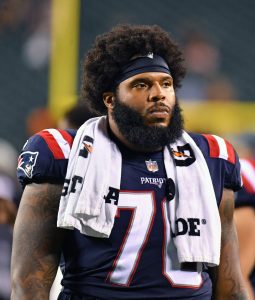 On the offensive side of the ball, the team made their biggest addition on the offensive line. Isaiah Wynn was once a first-round pick by the Patriots, but he fell out of favor in New England. Following a 2022 season where he was limited to only nine games (seven starts), the lineman hit free agency with little fanfare. He eventually got a one-year contract from Miami, where he’ll provide an upside option on the offensive line. While Wynn only ranked 72nd among 81 qualifying OTs in 2022 (per Pro Football Focus), he graded as an above-average option in each of his first three seasons in the NFL, including a 2020 campaign where he ranked 11th at his position.
On the offensive side of the ball, the team made their biggest addition on the offensive line. Isaiah Wynn was once a first-round pick by the Patriots, but he fell out of favor in New England. Following a 2022 season where he was limited to only nine games (seven starts), the lineman hit free agency with little fanfare. He eventually got a one-year contract from Miami, where he’ll provide an upside option on the offensive line. While Wynn only ranked 72nd among 81 qualifying OTs in 2022 (per Pro Football Focus), he graded as an above-average option in each of his first three seasons in the NFL, including a 2020 campaign where he ranked 11th at his position.
The rest of the team’s offensive additions are destined for backup roles. Mike White showed a little something while serving as the Jets backup/occasional starter over the past two seasons, and he’ll now be the team’s top insurance if (or when) Tua Tagovailoa is sidelined. Tyler Kroft projects as more of a backup/blocking tight end, but he’ll help soak up some of the snaps that were lost when Mike Gesicki left for the Patriots. Braxton Berrios only missed one game for the Jets over the past four seasons, and he’ll likely see a role as a key returner and as a WR option behind Tyreek Hill and Jaylen Waddle.
Read more
Re-signings:
- Justin Bethel, CB: One year, $1.32MM ($1.17MM guaranteed)
- Raheem Mostert, RB: One year, $2.12MM ($1MM guaranteed)
- Nik Needham, CB: One year, $2MM ($750K guaranteed)
- Duke Riley, LB: Two years, $5MM ($2.25MM guaranteed)
- Andrew Van Ginkel, LB: One year, $2.65MM ($1.5MM guaranteed)
- Jeff Wilson Jr., RB: Two years, $6MM ($1.08MM guaranteed)
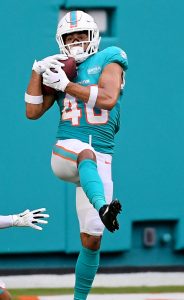 While the Dolphins did do some work to revamp their cornerbacks room, they also made sure to retain a pair of veterans at the position. Nik Needham was a part-time starter for the Dolphins over the past four years, but he was limited to only six games in 2022 before suffering a torn Achilles. He’s starting the season on the PUP as he works his way back from injury, but he’ll eventually rejoin what should be a deep CB room. Justin Bethel was also brought back following his first season in Miami. The special teams ace has appeared in at least 300 special teams snaps in each of his 11 NFL seasons.
While the Dolphins did do some work to revamp their cornerbacks room, they also made sure to retain a pair of veterans at the position. Nik Needham was a part-time starter for the Dolphins over the past four years, but he was limited to only six games in 2022 before suffering a torn Achilles. He’s starting the season on the PUP as he works his way back from injury, but he’ll eventually rejoin what should be a deep CB room. Justin Bethel was also brought back following his first season in Miami. The special teams ace has appeared in at least 300 special teams snaps in each of his 11 NFL seasons.
The Dolphins also brought back a pair of depth pieces at linebacker. Andrew Van Ginkel was once a starter for the Dolphins, starting 25 of his 33 appearances between 2020 and 2021. He started only five of his 17 appearances last season, but he still chipped in 47 tackles while appearing in 29 percent of his team’s defensive snaps. Duke Riley has seen a similar role in Miami over the past two years, appearing in more than a fourth of his team’s defensive snaps while contributing 71 tackles.
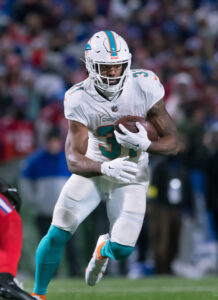 While the Dolphins flirted with a number of potential running back upgrades (which we’ll get to below), the team will return a pair of veterans for the time being. Following five-plus seasons in San Francisco, Raheem Mostert joined Mike McDaniel in Miami for the 2022 season. The running back managed to stay mostly healthy for the first time in years, and he finished the season with a career-high 1,093 yards from scrimmage.
While the Dolphins flirted with a number of potential running back upgrades (which we’ll get to below), the team will return a pair of veterans for the time being. Following five-plus seasons in San Francisco, Raheem Mostert joined Mike McDaniel in Miami for the 2022 season. The running back managed to stay mostly healthy for the first time in years, and he finished the season with a career-high 1,093 yards from scrimmage.
Jeff Wilson Jr. was also brought over from San Francisco midseason, with the veteran contributing 484 yards from scrimmage in eight games. The veteran will start the upcoming season on injured reserve, perhaps opening the door for some of the team’s younger options at the position to step up.
Notable losses:
- Teddy Bridgewater, QB
- Myles Gaskin, RB (released)
- Mike Gesicki, TE
- Melvin Ingram, LB
- John Jenkins, DL
- Byron Jones, CB (released)
- Greg Little, OT
- Thomas Morstead, P
- Elandon Roberts, LB
- Eric Rowe, S
- Brandon Shell, OT
- Trent Sherfield, WR
The Dolphins didn’t let any crucial players leave this offseason, but they did watch some top-end depth walk out the door. Mike Gesicki appeared to be a foundational piece a few years ago, with the tight end combining for 126 catches, 1,483 yards, and eight touchdowns between the 2020 and 2021 seasons. 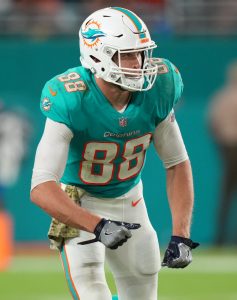 With Tyreek Hill added to the offense and Jaylen Waddle commanding more targets, Gesicki saw a lesser role on offense in 2022, finishing with 32 catches for 362 yards and five touchdowns. The Dolphins will turn to Durham Smythe, Tyler Kroft, and UDFA Julian Hill to guide the TE room in 2023.
With Tyreek Hill added to the offense and Jaylen Waddle commanding more targets, Gesicki saw a lesser role on offense in 2022, finishing with 32 catches for 362 yards and five touchdowns. The Dolphins will turn to Durham Smythe, Tyler Kroft, and UDFA Julian Hill to guide the TE room in 2023.
Trent Sherfield didn’t put up the biggest numbers in 2022, but he still appeared in more than half of Miami’s offensive snaps. The wideout got into all 17 games during his lone season in Miami, finishing with 30 catches for 417 yards and two touchdowns. Free agent addition Braxton Berrios will likely fill the departed receiver’s spot on the depth chart.
Teddy Bridgewater signed a one-year deal with Miami last offseason to serve as Tua Tagovailoa insurance. The veteran ended up getting into five games (two starts), tossing four touchdowns vs. four interceptions. The Dolphins lost both of his starts. Bridgewater joined the Lions this offseason while the Dolphins pivoted to a cheaper backup QB plan in Mike White. Myles Gaskin also saw his stint with the Dolphins come to an end. The running back had 1,818 yards from scrimmage and 12 touchdowns between the 2020 and 2021 seasons, but he was limited to only four games and 14 touches in 2023.
Brandon Shell and Greg Little both played significant roles on Miami’s offensive line in 2022, with the veterans combining for 18 starts. Little remains a free agent while Shell announced his sudden retirement after joining the Bills this offseason.
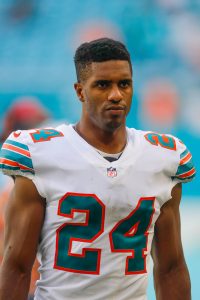 On defense, Byron Jones‘ stint with the Dolphins ended after only three seasons. The cornerback inked a five-year, $82MM deal with the organization back in 2020, and while he didn’t earn the same accolades as he did during his Dallas tenure, he still started all 30 of his appearances for Miami between 2020 and 2021. Jones ended up missing the entire 2022 season while recovering from left Achilles surgery, with the cornerback later claiming on social media that he could no longer “run or jump.” Jones was later released after failing his physical, with the organization citing his cap hit as reasons for the move.
On defense, Byron Jones‘ stint with the Dolphins ended after only three seasons. The cornerback inked a five-year, $82MM deal with the organization back in 2020, and while he didn’t earn the same accolades as he did during his Dallas tenure, he still started all 30 of his appearances for Miami between 2020 and 2021. Jones ended up missing the entire 2022 season while recovering from left Achilles surgery, with the cornerback later claiming on social media that he could no longer “run or jump.” Jones was later released after failing his physical, with the organization citing his cap hit as reasons for the move.
When it comes to 2022 production, Elandon Roberts was the biggest loss for the Dolphins defense. The linebacker started 43 of his 47 games since joining Miami in 2020. This included a career season for Roberts in 2022, with the former sixth-round pick compiling 107 tackles and 4.5 sacks. That performance likely priced the player out of the Dolphins’ plans, and he ended up getting a two-year deal from the Steelers.
Eric Rowe spent four seasons in Miami, but after starting 29 games through his first two seasons with the organization, he was limited to only 10 starts (in 31 games) between 2021 and 2022. The veteran served as a versatile weapon on Miami’s secondary, a role that will likely be filled by offseason addition DeShon Elliott.
After several underwhelming seasons, Melvin Ingram had a bounce-back year during his lone season in Miami. The pass rusher got into about half of his team’s defensive snaps while contributing six sacks, 10 QB hits, and seven tackles for loss. John Jenkins had a part-time role on the defensive line.
Extensions and restructures:
The Dolphins will have some important contract decisions to make next offseason, but the front office used this offseason to hold on to some important depth pieces on both sides of the ball.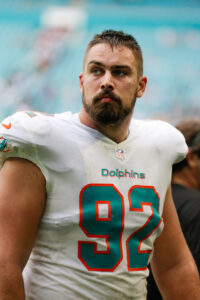 Zach Sieler has turned into an important depth piece on Miami’s defensive line, with the former Ravens sixth-round pick seeing a larger role in each of his three-plus seasons with the Dolphins. This culminated in a 2022 campaign where Sieler started 15 of his 17 appearances, compiling 70 tackles, 3.5 sacks, and a pair of forced fumbles.
Zach Sieler has turned into an important depth piece on Miami’s defensive line, with the former Ravens sixth-round pick seeing a larger role in each of his three-plus seasons with the Dolphins. This culminated in a 2022 campaign where Sieler started 15 of his 17 appearances, compiling 70 tackles, 3.5 sacks, and a pair of forced fumbles.
Durham Smythe has spent all five seasons of his career in Miami, mostly serving as a blocker while starting 56 of his 79 appearances. Smythe showed some talent in the receiving game in 2020 and 2021, hauling in 60 receptions for 565 yards and two scores. He could be in line for more work in 2023 with Mike Gesicki no longer in the picture.
Blake Ferguson has served as the team’s long snapper for the past three seasons, appearing in all 50 games for the Dolphins.
Draft:
The Dolphins have been active in trades over the past few years, leaving the front office with few draft assets in 2023. The team ultimately emerged from the draft with four rookies, although three UDFAs ended up also making the roster.
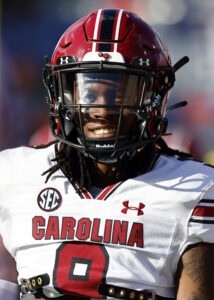 Cam Smith was a major part of the team’s makeover at cornerback. The South Carolina product lived up to his four-star-recruit billing, totaling six interceptions and 18 pass breakups during his time with the Gamecocks. He primarily served as a nickel cornerback in college, a role that he could hold in the NFL. For the time being, the rookie looks like he’ll be the top backup to Xavien Howard and Eli Apple on the outside, at least until Jalen Ramsey is back on the field.
Cam Smith was a major part of the team’s makeover at cornerback. The South Carolina product lived up to his four-star-recruit billing, totaling six interceptions and 18 pass breakups during his time with the Gamecocks. He primarily served as a nickel cornerback in college, a role that he could hold in the NFL. For the time being, the rookie looks like he’ll be the top backup to Xavien Howard and Eli Apple on the outside, at least until Jalen Ramsey is back on the field.
The Dolphins added some intrigue to their uninspiring RB room by selecting Texas A&M running back Devon Achane in the third round. Achane was productive during his final two years at college, compiling 2,469 yards from scrimmage and 21 touchdowns. With Jeff Wilson Jr. starting the season on injured reserve, the rookie could immediately see a role behind Raheem Mostert in Miami’s backfield.
Other:
The Dolphins made a significant change to their coaching staff, although it wasn’t all that surprising. Josh Boyer was a holdover from Brian Flores‘ Miami staff, but Mike McDaniel was quick to move off of him following an underwhelming 2022 season. Miami’s defense dropped from 16th to 24th in points allowed last season, and they fell from 10th to 15th in DVOA. Boyer wasn’t the only defensive coach to get canned; the Dolphins also let go of outside linebackers coach Ty McKenzie, safeties coach Steve Gregory, and assistant linebackers coach Steve Ferentz.
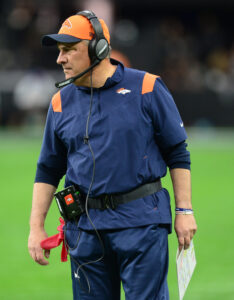 The Dolphins ultimately added Vic Fangio to their staff to take over the defense. The veteran coach was considered the premier defensive play-caller available, and the Dolphins got him to Miami by making him the highest-paid coordinator in the NFL. Fangio last roamed an NFL sideline during his three-year stint as the Broncos’ head coach. That resulted in an underwhelming 19-30 record, and Fangio ultimately spent the 2022 season as a consultant with the Eagles.
The Dolphins ultimately added Vic Fangio to their staff to take over the defense. The veteran coach was considered the premier defensive play-caller available, and the Dolphins got him to Miami by making him the highest-paid coordinator in the NFL. Fangio last roamed an NFL sideline during his three-year stint as the Broncos’ head coach. That resulted in an underwhelming 19-30 record, and Fangio ultimately spent the 2022 season as a consultant with the Eagles.
The Dolphins had some interesting financial decisions to make this offseason, starting with their franchise quarterback. The Dolphins committed to Tua Tagovailoa at least through the 2024 season when they picked up the quarterback’s fifth-year option, but the two sides couldn’t agree to a long-term deal before the start of the season. Miami is likely wary of committing to Tagovailoa considering his injury history, especially a troubling run of concussions during the 2022 campaign. However, the former first-round pick took a clear step forward in 2022, and the Dolphins could be ready to open the wallet next offseason if Tagovailoa has a repeat performance.
The Dolphins didn’t pick up the fifth-year options on a pair of disappointing former first-round picks. Austin Jackson started 28 of his 30 appearances through his first two seasons in the NFL, but the lineman was limited to only a pair of games in 2022 while spending two stints on injured reserve. The 24-year-old is expected to slide back into the starting lineup for the 2023 campaign, but the Dolphins front office were confident making this upcoming season a prove-it year for the offensive tackle. Noah Igbinoghene found himself in and out of the lineup during his three seasons in Miami. The cornerback was limited to only two starts in nine games last season, and he was eventually traded to the Cowboys before the roster deadline.
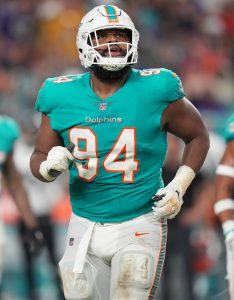 Tagovailoa wasn’t the only notable extension-eligible player to go without a long-term deal. Christian Wilkins pushed hard for a new contract with the Dolphins, with the defensive tackle stageing a hold-in as he looked to get a bump on his $10.75MM salary in 2023. With some of the league’s top DTs earning twice that amount, Wilkins was holding out for a significant pay day. The Dolphins were hoping to retain the defensive tackle via an extension but couldn’t agree to terms, leading the team to announce that they were tabling contract talks until after the season.
Tagovailoa wasn’t the only notable extension-eligible player to go without a long-term deal. Christian Wilkins pushed hard for a new contract with the Dolphins, with the defensive tackle stageing a hold-in as he looked to get a bump on his $10.75MM salary in 2023. With some of the league’s top DTs earning twice that amount, Wilkins was holding out for a significant pay day. The Dolphins were hoping to retain the defensive tackle via an extension but couldn’t agree to terms, leading the team to announce that they were tabling contract talks until after the season.
The Dolphins’ offseason headlines were also as much about what they didn’t do as what they did do. The team was seemingly connected to every running back, available or not, with the team rumored to be interested in the likes of Dalvin Cook, D’Andre Swift, Saquon Barkley, Josh Jacobs, and Jonathan Taylor. The team was most connected to Cook, but the free agent RB ended up linking up with the team’s division rival in New York. The Dolphins will enter the season having not added a significant name to the running backs room, but there’s a good chance the organization will be connected to any big names that become available between now and the trade deadline.
Top 10 cap charges for 2023:
- Emmanuel Ogbah, DE: $17.18MM
- Tyreek Hill, WR: $12.82MM
- Jerome Baker, LB: $12.51MM
- Christian Wilkins, DT: $10.75MM
- Xavien Howard, CB: $10.07MM
- Tua Tagovailoa, QB: $9.63MM
- Terron Armstead, OT: $9.23MM
- Connor Williams, G: $8.37MM
- Bradley Chubb, LB: $7.54MM
- Jaylen Waddle, WR: $7.38MM
The Dolphins have spent the past three seasons hovering around nine or 10 wins. With the team appearing to take a cultural and foundational step forward under Mike McDaniel in 2022, they’ll be expected to make more progress in 2023.
The team’s two biggest moves (acquiring Jalen Ramsey and hiring Vic Fangio) will likely have the biggest impact on Miami’s postseason hopes this season. However, many of the team’s secondary transactions helped maintain some sense of continuity, and that should be enough for the Dolphins to compete for a playoff spot in a crowded AFC.
By Sam Robinson |
at September 9, 2023 2:35 pm
The 49ers have managed to field top-flight rosters — outside of the quarterback position — over the past two seasons. That talent, along with Kyle Shanahan‘s play-calling acumen, powered San Francisco to consecutive NFC championship games. Neither going the 49ers’ way applies some pressure for the otherwise well-built team to come up with a viable quarterback solution. For the time being, that is Brock Purdy, who has recovered from UCL surgery.
Undoubtedly affected by the Trey Lance miss, the 49ers have used Purdy as a partial makeup call. Will the 2022 Mr. Irrelevant’s form last? If not, the 49ers have Sam Darnold as a new option. Either Purdy or Darnold would step into an offense housing four first-team All-Pros, and with Javon Hargrave in the fold, the 49ers are prepared to throw a better defensive front at opponents this season. Will this be the year Shanahan’s bunch takes the final step and wins the organization’s sixth title?
Extensions and restructures:
Days before Week 1, contingency plans were in place in the event the Bosa contract was not finalized. Fortunately for the 49ers, they will have the reigning Defensive Player of the Year in uniform Sunday. Holdout is technically the correct term to use, but Bosa’s effort differed from those waged by Chris Jones and Zack Martin. With the 49ers having worked on this contract for weeks and having planned it for over a year, they surely expected Bosa to either hold in or hold out. That differs from the Martin and Jones holdouts, somewhat contentious in nature. With the 49ers allowed to waive Bosa’s fines due to this being a rookie-contract holdout, Bosa’s absence barely qualifies as a speedbump. And, like Martin, the holdout benefited Bosa.
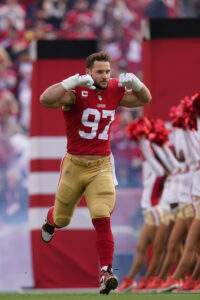 The question throughout this holdout centered around how much longer Aaron Donald‘s $31.7MM-per-year contract — one the Chiefs have attempted to treat as an outlier — would reside atop the defensive salary pecking order. Donald used a retirement threat and generational dominance to secure those terms without any new years added to his deal. Six years younger than Donald, Bosa used his importance to a loaded 49ers team — but one that depends on its top player to stay on the Super Bowl-contending level — to secure a true market reset.
The question throughout this holdout centered around how much longer Aaron Donald‘s $31.7MM-per-year contract — one the Chiefs have attempted to treat as an outlier — would reside atop the defensive salary pecking order. Donald used a retirement threat and generational dominance to secure those terms without any new years added to his deal. Six years younger than Donald, Bosa used his importance to a loaded 49ers team — but one that depends on its top player to stay on the Super Bowl-contending level — to secure a true market reset.
T.J. Watt‘s $28MM-AAV deal topped the edge defender market for two years, and the Steelers OLB locked down his game-changing second contract three days before the 2021 season. Bosa nearly matched that, accepting the 49ers’ offer four days before his team’s Week 1 trip to Pittsburgh. Watt’s contract only topped Joey Bosa‘s AAV by $1MM, making the 49ers’ Nick Bosa re-up’s result an eye-popping conclusion.
The guarantee-at-signing figure is not yet in place, and the number through three years will need to be measured as well to fully evaluate this contract. The 49ers also made Trent Williams the highest-paid tackle by inflating the AAV with a lofty final-year number. On the surface, however, Nick Bosa’s contract reshapes the edge rusher market. The $122.5MM total guarantee amount checks in more than $20MM north of Joey Bosa’s previous defender record.
This contract may create some difficulties for the Chiefs and Jones to cross the finish line, as it weakens Kansas City’s effort to classify Donald’s contract as an outlier, and cause trouble for the Cowboys and Micah Parsons down the road. Nick Bosa has more than demonstrated his value in San Francisco. Along with Jimmy Garoppolo‘s return to health, Bosa’s 2019 arrival catalyzed the 49ers’ transformation from 4-12 team to Super Bowl LIV entrant. Bosa sat out much of his final Ohio State season, readying for the NFL, and ended up in San Francisco largely because of Garoppolo’s injury ruining the 2018 team’s season.
The rare third-generation NFLer, Bosa put himself back on track for this contract by returning from a September 2020 ACL tear to play all 20 49ers games in 2021. Bosa led the league in tackles for loss that year and posted a career-high 18.5 sacks last season. His 48 QB hits in 2022 broke up a J.J. Watt sweep atop that list. While the recently retired superstar still holds four of the top five figures since QB hits became charted, Bosa’s 48 hits now sit third on that list. The 49ers will bet on the younger of this generation’s NFL Bosas anchoring their defense for the long haul.
Free agency additions:
- Javon Hargrave, DT: Four years, $81MM ($40MM guaranteed)
- Sam Darnold, QB: One year, $4.5MM ($3.5MM guaranteed)
- Isaiah Oliver, CB: Two years, $6.75MM ($2.91MM guaranteed)
- Jon Feliciano, OL: One year, $2.25MM ($2.25MM guaranteed)
- Clelin Ferrell, DE: One year, $2.5MM ($1.24MM guaranteed)
- Brandon Allen, QB: One year, $1.23MM ($200K guaranteed)
- Matt Pryor, OL: One year, $1.3MM
Among San Francisco’s signings, Hargrave’s contract obviously jumps out. Not long after Garoppolo’s contract came off their books, the 49ers sprang into action and allocated that cash to strengthen a strength. After the Bosa signing, the 49ers now have three defensive linemen making more than $17MM per year. The 49ers’ decision to trade DeForest Buckner, extend Arik Armstead and replace Buckner with Javon Kinlaw backfired. But they faced an either/or proposition with Buckner and Armstead at the time. Hargrave comes in as a fearsome hired gun, an arrangement made possible by Purdy’s seventh-round rookie contract.
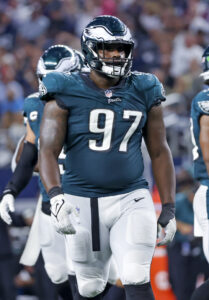 The Eagles rolled out an embarrassment of riches on their D-line last season, threatening the 1984 Bears’ sack record. While Philadelphia (70 sacks) fell two short of the 46 defense’s longstanding mark, the team produced four double-digit sack totals. Hargrave was among those, tallying a career-high 11 sacks. This is a big commitment for a D-tackle going into his age-30 season, but Hargrave used his Eagles contract to confirm he is among the league’s best inside rushers. After toiling as an unearthed gem of sorts alongside Cameron Heyward and Stephon Tuitt in Pittsburgh, Hargrave broke through in Philly.
The Eagles rolled out an embarrassment of riches on their D-line last season, threatening the 1984 Bears’ sack record. While Philadelphia (70 sacks) fell two short of the 46 defense’s longstanding mark, the team produced four double-digit sack totals. Hargrave was among those, tallying a career-high 11 sacks. This is a big commitment for a D-tackle going into his age-30 season, but Hargrave used his Eagles contract to confirm he is among the league’s best inside rushers. After toiling as an unearthed gem of sorts alongside Cameron Heyward and Stephon Tuitt in Pittsburgh, Hargrave broke through in Philly.
Buckner and Bosa only overlapped for one season, which happened to produce a Super Bowl berth, so it will be interesting to see what well-regarded D-line coach Kris Kocurek can do with a Bosa-Armstead-Hargrave troika. Missing only three games in seven seasons, Hargrave also offers durability the 49ers have lacked from Armstead and Kinlaw. This certainly looks like the 49ers’ best defensive line since that 2019 unit.
Kocurek reviving Ferrell’s career would further highlight his potential for a defensive coordinator post. The Raiders surprised most by taking Ferrell fourth overall in 2019, but the Mike Mayock–Jon Gruden pick did not live up to his draft slot. During his final two years with the Raiders, the Clemson product had drifted to the backup level. Ferrell totaled just 5.5 sacks over the past three seasons, lowering his price in free agency. Had Bosa extended his holdout past Week 1, however, Ferrell was in place to start alongside 2022 second-rounder Drake Jackson. The fifth-year edge rusher looms as a wild card in Steve Wilks‘ defense.
The 49ers targeted Oliver as a nickel who could match up with bigger slot receivers, following Jimmie Ward in that regard. The Falcons moved Oliver inside later in his run with the team, and Pro Football Focus rated him as a top-10 corner last year. That said, the 210-pound cover man did not impress in the preseason. It will be interesting to see if he can stick as the slot option for the 49ers, who have Charvarius Ward and Deommodore Lenoir camped on the boundaries.
 Shanahan has shown tremendous confidence in Purdy, who completed his rehab and shed limitations earlier than expected. But Darnold came into the NFL undeniably more talented. And the former No. 3 overall pick impressed during his first offseason in San Francisco. Shanahan has spoken highly of the former Jets and Panthers starter, and while Darnold has enjoyed plenty of opportunities to showcase his skill (55 starts), it is difficult to compare his New York and Charlotte setups to Shanahan’s infrastructure. Darnold, 26, joined the 49ers largely because of Shanahan and their array of skill-position talent.
Shanahan has shown tremendous confidence in Purdy, who completed his rehab and shed limitations earlier than expected. But Darnold came into the NFL undeniably more talented. And the former No. 3 overall pick impressed during his first offseason in San Francisco. Shanahan has spoken highly of the former Jets and Panthers starter, and while Darnold has enjoyed plenty of opportunities to showcase his skill (55 starts), it is difficult to compare his New York and Charlotte setups to Shanahan’s infrastructure. Darnold, 26, joined the 49ers largely because of Shanahan and their array of skill-position talent.
Darnold has also shown himself to be an unremarkable pro QB through five seasons, and he has battled availability issues in each of his seasons. But it did not seem to be much of a contest between he and Trey Lance for the 49ers’ backup job, even as Lance carried experience in Shanahan’s system. Darnold QB2 buzz circulated in the spring and intensified before camp.
The 49ers had targeted a veteran QB due mostly to Purdy and Lance’s injury issues, but Darnold has the pedigree to potentially challenge Purdy, should the former Iowa State starter struggle coming off elbow surgery. Brutal QB injury fortune has hounded the Shanahan-era 49ers. While Darnold is only tied to a $4.5MM salary, he could become an important figure in the NFC’s Super Bowl chase.
Re-signings:
- Jake Brendel, C: Four years, $16.5MM ($5MM guaranteed)
- Tashaun Gipson, S: One year, $2.9MM ($2.17MM guaranteed)
- Kevin Givens, DT: One year, $2MM ($2MM guaranteed)
- Colton McKivitz, T: Two years, $4.56MM ($1.87MM guaranteed)
- Taybor Pepper, LS: Three years, $3.96MM ($1.5MM guaranteed)
- Ross Dwelley, TE: One year, $1.7MM ($700K guaranteed)
- Kerry Hyder, DE: One year, $1.1MM
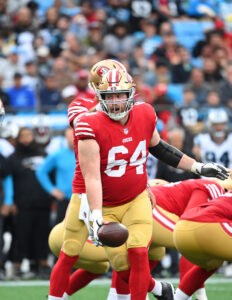 Center retention was not particularly costly around the league this offseason. Five teams — the 49ers, Browns, Jets, Panthers and Vikings — preferred continuity over installing an outsider at the pivot. The Brendel, Ethan Pocic, Connor McGovern, Bradley Bozeman and Garrett Bradbury deals all came in at less than $6MM. For Brendel, that represented a reward for capitalizing on a surprising opportunity.
Center retention was not particularly costly around the league this offseason. Five teams — the 49ers, Browns, Jets, Panthers and Vikings — preferred continuity over installing an outsider at the pivot. The Brendel, Ethan Pocic, Connor McGovern, Bradley Bozeman and Garrett Bradbury deals all came in at less than $6MM. For Brendel, that represented a reward for capitalizing on a surprising opportunity.
The 49ers brought in ex-Shanahan Falcons cog Alex Mack for what turned out to be a one-off in 2021, installing him over Brendel. Rather than chase a veteran last year, the team promoted Brendel, who came into the season with 250 offensive snaps in six seasons. The confidence paid off for the 49ers, who received 20 total starts from Brendel. The former UDFA, who will turn 31 on Sunday, graded fifth in ESPN’s run block win rate metric during his starter audition.
Overall, the 49ers should be better positioned on their interior O-line due to the experience first-time starters Brendel, Aaron Banks and Spencer Burford gained last season. Feliciano, who shifted back to guard this offseason, started for the Giants at center throughout last season. He makes for a nice swing backup and potential Burford platoon partner. But right tackle does present a question.
Read more
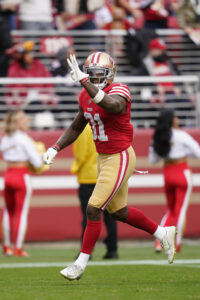 Mike McGlinchey was a top-10 pick who started throughout a five-year Bay Area tenure. McKivitz is a former fifth-round choice with five starts in three seasons. The 49ers gave him the right tackle job before training camp, certainly indicating confidence in the West Virginia alum. The potential for a steep McGlinchey-to-McKivitz mcdrop-off (sorry) exists, though last season was a fairly good sign in the coaching staff’s judgment regarding inexperienced O-line starters. McKivitz working out would be quite cost-efficient for the 49ers, who only have one starting O-lineman earning more than $5MM per year.
Mike McGlinchey was a top-10 pick who started throughout a five-year Bay Area tenure. McKivitz is a former fifth-round choice with five starts in three seasons. The 49ers gave him the right tackle job before training camp, certainly indicating confidence in the West Virginia alum. The potential for a steep McGlinchey-to-McKivitz mcdrop-off (sorry) exists, though last season was a fairly good sign in the coaching staff’s judgment regarding inexperienced O-line starters. McKivitz working out would be quite cost-efficient for the 49ers, who only have one starting O-lineman earning more than $5MM per year.
A career-long starter who has played for five teams in 11 seasons, Gipson earned the trust of DeMeco Ryans, who moved Ward back to cornerback. As Talanoa Hufanga soared to All-Pro acclaim, Gipson provided a nice sidekick presence. The former Browns, Jaguars, Bears and Texans starter intercepted a career-high five passes; PFF graded both 49ers safeties as top-35 options.
Gipson’s age (33) clearly factored into the low-level re-up he inked with the 49ers, but he managed to be a non-QB from the 2012 draft class who mattered to a team last season. Gipson looks to have a found a nice late-career fit, with San Francisco coaxing plus safety play at a low rate.
Notable losses:
- Azeez Al-Shaair, LB
- Daniel Brunskill, OL
- Samson Ebukam, DE
- Jimmy Garoppolo, QB
- Robbie Gould, K
- Maurice Hurst, DT
- Josh Johnson, QB
- Tyler Kroft, TE
- Jordan Matthews, WR/TE
- Mike McGlinchey, T
- Emmanuel Moseley, CB
- Charles Omenihu, DE
- Hassan Ridgeway, DT
- Jason Verrett, CB
- Jimmie Ward, S
- Jordan Willis, DL
Garoppolo arrived in San Francisco in unusual fashion, coming over via a trade on which Bill Belichick and Robert Kraft were believed to have disagreed. The 2017 trade and subsequent extension preempted a Shanahan-Kirk Cousins reunion, a move the 49ers had eyed after beginning the Shanahan-John Lynch era without a starter-caliber QB on the roster. Garoppolo went 38-17 as the 49ers’ starter, enjoying the friendly confines Shanahan’s offense offers, and quarterbacked the team to four playoff wins. Garoppolo’s low ceiling drew regular scrutiny, and the 49ers could not rely on their longtime starter to stay healthy.
 Missing 30 games due to injury since his September 2018 ACL tear, Garoppolo was never ultimately replaced by handpicked heir apparent Trey Lance. But Garoppolo’s 2020 ankle ailment, three-injury 2021 (leading to a two-surgery 2022) and December foot fracture obscured the run of capable QB play he provided the 49ers during their Shanahan-era high points. The 49ers did well to circle back to Garoppolo, once his mid-offseason shoulder surgery cooled his trade market, last year. He started the 12-game win streak Purdy finished.
Missing 30 games due to injury since his September 2018 ACL tear, Garoppolo was never ultimately replaced by handpicked heir apparent Trey Lance. But Garoppolo’s 2020 ankle ailment, three-injury 2021 (leading to a two-surgery 2022) and December foot fracture obscured the run of capable QB play he provided the 49ers during their Shanahan-era high points. The 49ers did well to circle back to Garoppolo, once his mid-offseason shoulder surgery cooled his trade market, last year. He started the 12-game win streak Purdy finished.
Shanahan made it clear this offseason that, despite the 49ers’ about-face in 2022, the 31-year-old QB would not be back. The Raiders ditched the durable Derek Carr for a Garoppolo-Josh McDaniels reunion; they will be the team rolling the dice on Garoppolo’s health.
One of the league’s top run-blocking right tackles, McGlinchey appeared ticketed to leave once the 49ers gave Trent Williams a six-year, $138.1MM deal in March 2021. Mutual interest in a second contract emerged, but Lynch eventually acknowledged the only viable path for McGlinchey to stay in San Francisco would be his market underwhelming. The ex-Notre Dame standout was on-hand for some big sequences in 49ers run-game annals. He helped Raheem Mostert threaten Eric Dickerson‘s playoff rushing record in the 2019 NFC championship game demolition and, after recovering from a 2021 quadriceps injury, was present for Christian McCaffrey‘s post-trade surge.
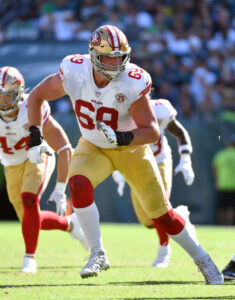 The 49ers paid up for Hargrave and did not appear in on the McGlinchey market, which led to the five-year starter inking a five-year, $87.5MM Broncos accord. Denver, which started 10 different Week 1 right tackles from 2013-22, conveyed its commitment to filling that position by giving McGlinchey a $52.5MM practical guarantee. The 49ers have now let two five-year O-line starters — McGlinchey and Laken Tomlinson — walk in consecutive offseasons.
The 49ers paid up for Hargrave and did not appear in on the McGlinchey market, which led to the five-year starter inking a five-year, $87.5MM Broncos accord. Denver, which started 10 different Week 1 right tackles from 2013-22, conveyed its commitment to filling that position by giving McGlinchey a $52.5MM practical guarantee. The 49ers have now let two five-year O-line starters — McGlinchey and Laken Tomlinson — walk in consecutive offseasons.
Dre Greenlaw‘s 2022 extension effectively paved a path out of San Francisco for Al-Shaair, whose place in the 49ers’ linebacker hierarchy only changed due to injury. Greenlaw going down in 2021 led to Al-Shaair playing a three-down role alongside Fred Warner. But Greenlaw coming back restored order. Al-Shaair also missed time due to injury last year; he will anchor a new-look Tennessee ILB corps.
New Titans GM Ran Carthon brought Al-Shaair and Brunskill to Nashville as low-cost starters. Brunskill lost his starting gig to Burford last year, sliding into a swing role. But he still rotated with the Day 3 rookie, playing 519 offensive snaps. The two-year right guard starter could be missed, though having Jon Feliciano (54 career starts) as an interior swingman may effectively replace Brunskill.
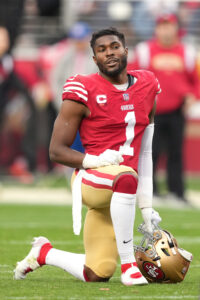 Ryans poached Ward and Willis for his new Houston team. Ward, 32, resided as the longest-tenured 49ers starter, signing three contracts and staying nine years. The 2014 first-round pick missed extensive time due to injury and toggled back and forth from safety to nickel corner during his run. Although Ward was moved off safety once again during Ryans’ watch last season, the two-year 49ers DC communicated to him he would be interested in taking the veteran DB with him wherever he went. Ryans kept his word, with Ward signing a two-year, $13MM deal to serve as a mentor of sorts on a rebuilding Texans team.
Ryans poached Ward and Willis for his new Houston team. Ward, 32, resided as the longest-tenured 49ers starter, signing three contracts and staying nine years. The 2014 first-round pick missed extensive time due to injury and toggled back and forth from safety to nickel corner during his run. Although Ward was moved off safety once again during Ryans’ watch last season, the two-year 49ers DC communicated to him he would be interested in taking the veteran DB with him wherever he went. Ryans kept his word, with Ward signing a two-year, $13MM deal to serve as a mentor of sorts on a rebuilding Texans team.
Saving money for the Bosa windfall, the 49ers let both Omenihu and Ebukam walk. Both two-year contributors benefited from rushing on the Bosa-fronted D-line, and the Chiefs and Colts respectively signed each to three-year contracts. Both the ex-Bosa wingmen scored guarantees that topped veterans Leonard Floyd, Frank Clark and Jadeveon Clowney this offseason. The Colts gave Ebukam $10.75MM; Omenihu secured $8.6MM from the Chiefs. Omenihu’s guarantees are in jeopardy, however, thanks to the six-game suspension he incurred in connection with his January domestic violence arrest.
Trades:
The Darnold signing eventually became a 49ers white flag on Lance, who is teetering on becoming one of the modern draft’s biggest busts. Unlike Ryan Leaf or JaMarcus Russell, however, this top-three QB pick has barely played. Lance’s past three-plus years have doubled as one of the strangest career arcs for any top prospect in NFL history. The dual-threat talent became a top prospect despite playing one season at a non-Division I-FBS program — albeit the best non-Division I-FBS program — and is gone after finishing just three games as a starter.
 It is possible more Lance warts would have formed had the COVID-19 pandemic not nixed the 2020 Division I-FCS season, but the Cowboys will attempt to redevelop a player whose development has been thrown off at every turn. Lance sat out the 2020 slate, save for one exhibition game, and did not threaten Garoppolo’s job in 2021. A finger injury limited Lance as a rookie, and after the September 2022 ankle fracture required two surgeries, the 49ers began holding trade talks for an extended period this year. Lance, 23, went from unquestioned starter during the 2022 offseason to third-stringer in 2023; he threw just 31 regular-season passes in between.
It is possible more Lance warts would have formed had the COVID-19 pandemic not nixed the 2020 Division I-FCS season, but the Cowboys will attempt to redevelop a player whose development has been thrown off at every turn. Lance sat out the 2020 slate, save for one exhibition game, and did not threaten Garoppolo’s job in 2021. A finger injury limited Lance as a rookie, and after the September 2022 ankle fracture required two surgeries, the 49ers began holding trade talks for an extended period this year. Lance, 23, went from unquestioned starter during the 2022 offseason to third-stringer in 2023; he threw just 31 regular-season passes in between.
Regardless of the rumors of Shanahan initially preferring Mac Jones — after the 49ers traded two first-round picks to move up from No. 12 to No. 3 in March 2021 — and being talked into Lance, the team’s decision-maker on the offensive side signed off on adjusting his offense for the unusual prospect. The 49ers receiving only a fourth-round pick represents an obvious value disaster, as the opportunity cost from the 2021 and ’22 first rounds stings.
The Cowboys are the only team believed to have offered a fourth, leading the 49ers to abandon their aim to trade Lance to an AFC team. They seemed prepared to trade Lance within the conference earlier in the offseason, when the Vikings engaged in talks for the Minnesota native. While Lance said in May he wanted to stay in San Francisco, he changed his tune after Darnold was announced as the backup in August. Dallas is expected to keep Lance as its third-stringer this season, with the recently re-signed Cooper Rush backing up Dak Prescott. With a $5.3MM guarantee on the books for 2024, Lance will need to at least win the backup job to cling to NFL relevance.
Draft:
- Round 3, No. 87 (from Vikings): Ji’Ayir Brown, S (Penn State) (signed)
- Round 3, No. 99: Jake Moody, K (Michigan) (signed)
- Round 3, No. 101: Cameron Latu, TE (Alabama) (signed)
- Round 5, No. 155 (from Dolphins): Darrell Luter Jr., CB (South Alabama) (signed)
- Round 5, No. 173: Robert Beal Jr., DE (Georgia) (signed)
- Round 6, No. 216: Dee Winters, LB (TCU) (signed)
- Round 7, No. 247: Brayden Willis, TE (Oklahoma) (signed)
- Round 7, No. 253: Ronnie Bell, WR (Michigan) (signed)
- Round 7, No. 255: Jalen Graham, LB (Purdue) (signed)
The 49ers’ 2023 first-round pick ended up changing hands three times, going from San Francisco to Miami to Denver to New Orleans. The McCaffrey trade moved the 49ers’ second-rounder to Carolina. Fortunately for 49ers draft buffs, they hold their own first- and second-round picks in 2024.
Zane Gonzalez sustained an injury during the preseason, leading to an injury settlement. Moody was always on track to become the 49ers’ kicker, given his draft slot. This year’s first kicker taken, Moody earned back-to-back All-American honors with the Wolverines. He will replace Robbie Gould, the 49ers’ kicker for the past six seasons. Gould, 40, remains unsigned.
The recent history of the first kicker chosen in a draft does not present great job security for Moody. The Browns cut Cade York (Round 4, 2022) after one season. Justin Rohrwasser (Round 5, 2020) never kicked in the NFL, and the Vikings waived Daniel Carlson (Round 5, 2018) after two games (though, he rebounded with the Raiders). The only other Day 2 kicker chosen in the previous 10 drafts, Roberto Aguayo (2016), famously flamed out one year after the Buccaneers used a second-rounder on him.
Holding only compensatory third-rounders this year, the 49ers moved up (via the Vikings) from No. 102 to select Brown. The Penn State-developed safety totaled 10 interceptions between the 2021 and ’22 seasons with the Nittany Lions, and the JUCO transfer added 4.5 sacks as a senior. Scouts Inc. graded Brown as this year’s No. 67 overall prospect. He is positioned as a backup to start his career. Latu is out for the year after a preseason knee injury.
Other:
Ryans worked his way up from the quality control level, rising quickly after beginning his coaching career on Shahanan’s first 49ers staff. Going 2-for-2 in NFC title game appearances as a defensive coordinator, Ryans became a locked-in HC candidate. The 49ers ranked first in total defense, points allowed and defensive DVOA. Shanahan has now lost back-to-back defensive coordinators to HC jobs, with Ryans following Robert Saleh to the AFC. Ryans was popular to the point he canceled multiple interviews — with the Colts and Cardinals — and narrowed his search to the Broncos or Texans. He ended up preferring his former team, which offered a six-year contract (after making its previous two HCs one-and-dones). Ryans took Slowik, who memorably rose from PFF staffer to 49ers pass-game coordinator, with him as his offensive coordinator.
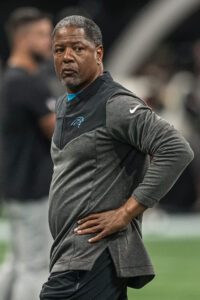 Coming off one of the most successful interim HC seasons in modern NFL history, Wilks saw his 6-6 showing in charge of the Panthers still precede the team choosing another candidate (Frank Reich). Considering the paths of Saleh and Ryans, this is pretty good spot for Wilks, 54, to make another attempt at landing a top sideline job. Wilks, who is part of Brian Flores‘ discrimination suit, has moved from a 2021 role as the University of Missouri’s DC (after being out of football in 2020) to the leader of last year’s top defense. Mutual interest in a reunion existed between the 49ers and Vic Fangio, but Mike McDaniel lured him to Miami with a monster DC salary (north of $4.5MM).
Coming off one of the most successful interim HC seasons in modern NFL history, Wilks saw his 6-6 showing in charge of the Panthers still precede the team choosing another candidate (Frank Reich). Considering the paths of Saleh and Ryans, this is pretty good spot for Wilks, 54, to make another attempt at landing a top sideline job. Wilks, who is part of Brian Flores‘ discrimination suit, has moved from a 2021 role as the University of Missouri’s DC (after being out of football in 2020) to the leader of last year’s top defense. Mutual interest in a reunion existed between the 49ers and Vic Fangio, but Mike McDaniel lured him to Miami with a monster DC salary (north of $4.5MM).
Carthon also joined Shanahan from the start, coming over from the Rams. After interviewing for the Bears, Giants and Steelers’ GM gigs in 2022, Carthon landed one of the two vacancies this year. The former Florida Gators running back and son of ex-Giants fullback Maurice Carthon, Ran finished his 49ers tenure as the team’s director of player personnel. 49ers assistant GM Adam Peters declined interviews with both the Cardinals and Titans. The 49ers collected three additional third-round picks following the departures of Ryans and Carthon, after previously picking up Rooney Rule-driven third-rounders for the exits of McDaniel, Saleh and Martin Mayhew.
Losing Purdy in the first quarter of the NFC championship game, the 49ers were prepared to bring Philip Rivers out of a two-year retirement to start in Super Bowl LVII — had they miraculously dispatched the Eagles. That quickly became unrealistic, but San Francisco losing Purdy and Josh Johnson prompted the NFL to reinstate the emergency third QB rule.
 Shanahan did not waver from his confidence in Purdy this offseason, reinstalling him as the starter as Darnold and Lance battled for the backup job. Purdy, who beat out Nate Sudfeld for the 49ers’ third-string job to start last season, avoided Tommy John surgery and beat the timetable from the internal brace procedure. The early-March procedure was to require a six-month recovery duration, but instead of pushing up against the regular season, Purdy was back in time to see preseason action. While Darnold looms, Purdy does not appear to be on a short leash.
Shanahan did not waver from his confidence in Purdy this offseason, reinstalling him as the starter as Darnold and Lance battled for the backup job. Purdy, who beat out Nate Sudfeld for the 49ers’ third-string job to start last season, avoided Tommy John surgery and beat the timetable from the internal brace procedure. The early-March procedure was to require a six-month recovery duration, but instead of pushing up against the regular season, Purdy was back in time to see preseason action. While Darnold looms, Purdy does not appear to be on a short leash.
The 49ers have more All-Pro skill-position starters than non-All-Pros, keeping Aiyuk as an overqualified auxiliary pass catcher. Amid Deebo Samuel‘s self-proclaimed step back last season, however, Aiyuk led the 49ers with 1,015 receiving yards. San Francisco rebuffed trade interest in Aiyuk, and the team now has him locked in through 2024. An Aiyuk payment would be challenging for a team with Samuel and George Kittle signed to upper-crust deals at their respective positions, but the 49ers are understandably not shutting down that prospect with two years remaining on his contract.
Top 10 cap charges for 2023:
- Arik Armstead, DT: $23.76MM
- Trent Williams, LT: $12.54MM
- George Kittle, TE: $9.48MM
- Fred Warner, LB: $9.1MM
- Deebo Samuel, WR: $8.65MM
- Javon Hargrave, DT: $6.6MM
- Kyle Juszczyk, FB: $6.57MM
- Charvarius Ward, CB: $6.42MM
- Sam Darnold, QB: $5.71MM
- Dre Greenlaw, LB: $5.55MM
Still rostering a number of Super Bowl LIV starters, the 49ers may not be facing a closing window just yet. But the clock is ticking. The team has proven it can soar to rarified heights with modest quarterback play. If Purdy can take a step forward in his first full season at the controls, the 49ers will be tough to stop.
All eyes will be on the unlikely starter post-injury. Such is life in the NFL, as the intergalactic skill-position group or the bolstered defensive line probably will not be enough to push the 49ers to the summit without Purdy at least maintaining his 2022 form. Barring a 2020-like slew of major injuries, though, the 49ers will still be in the thick of the NFC’s shallower contender mix.
By Sam Robinson |
at September 8, 2023 10:04 pm
Sticking with their all-in approach around Tom Brady a year too long, the Buccaneers still benefited considerably from their 2020 free agency coup. The franchise added a second Super Bowl title and saw Brady display better form in 2021. Brady’s unretirement helped the Bucs stay atop the NFC South, but it took a historically terrible division for that to happen. The Bruce Arians-to-Todd Bowles transition did not go well, and the latter’s seat may already be warm.
The Bucs’ round of early-2020s restructures — Brady’s chief among them — led to cap trouble this year and did not allow for the team to make splashy outside upgrades. As a result, the Bucs are not receiving much attention going into their first post-Brady season.
Free agency additions:
- Baker Mayfield, QB: One year, $4MM ($4MM guaranteed)
- Greg Gaines, DT: One year, $3.5MM ($3.5MM guaranteed)
- Matt Feiler, G: One year, $2.5MM ($1.29MM guaranteed)
- Ryan Neal, S: One year, $1.23MM ($1.1MM guaranteed)
- Chase Edmonds, RB: One year, $1.23MM ($153K guaranteed)
- Chase McLaughlin, K: One year, $1.13MM ($100K guaranteed)
Mayfield will soon take snaps for a fourth team in barely 20 months. The Ravens also discussed terms with Mayfield, though those talks were framed around the former No. 1 overall pick becoming a QB2 upgrade. The Bucs carried an obvious quarterback need following Brady’s second retirement, but the $35.1MM void-years bill kept the team out of the Derek Carr and Jimmy Garoppolo markets. While the Bucs also considered Jacoby Brissett, he ended up with the Commanders for twice the money Mayfield scored. With the Bucs mandating a low-cost veteran, the former No. 1 overall pick has what likely profiles as a last chance to prove himself as a starter.
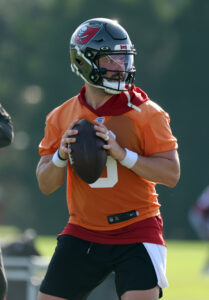 With the exception of rookie-contract players, Mayfield’s $4MM AAV is miles below every other Week 1 QB. The $4MM base value make it more in line with the backup tier, and many QB2 options — Brissett, Andy Dalton, Taylor Heinicke, Marcus Mariota, Jarrett Stidham — landed more than the player who was in talks with the Browns about a lucrative extension in 2021.
With the exception of rookie-contract players, Mayfield’s $4MM AAV is miles below every other Week 1 QB. The $4MM base value make it more in line with the backup tier, and many QB2 options — Brissett, Andy Dalton, Taylor Heinicke, Marcus Mariota, Jarrett Stidham — landed more than the player who was in talks with the Browns about a lucrative extension in 2021.
It is difficult to overstate the tumble Mayfield’s stock has taken since he was at the heart of the Browns snapping a 17-season playoff drought. A shoulder injury keyed a 2021 dip, but Mayfield did not bounce back in Carolina. Instead, his Panthers tenure ended with the team waiving him — as he sat dead last in QBR — despite having clawed back into the dreadful NFC South race. Illustrating how bad Mayfield was in Carolina, his memorable Los Angeles stay — which included the two-days-notice 98-yard game-winning drive to stun the Raiders — did not pull him out of last place. Mayfield played well against the Broncos on Christmas Day but still finished miles behind the second-worst signal-caller in 2022 QBR.
Bucs were willing to take what amounted to a flier on the 2017 Heisman winner, and instead of drafting another passer, they only pitted two-year third-stringer Kyle Trask against Mayfield. It took all three preseason games for Mayfield to beat out the 2021 second-rounder. Mayfield finished the 2020 season with 26 touchdown passes, eight interceptions and a 10th-place QBR finish. That represents his most recent healthy season, one that powered Kevin Stefanski to Coach of the Year honors and involved the Browns embarrassing the Steelers in Round 1 despite Stefanski home with COVID-19.
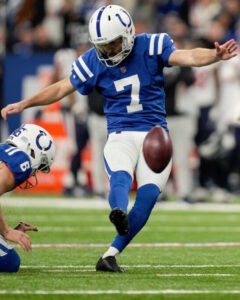 The Bucs will hope a stable Mayfield offseason leads to this form resurfacing, but while Tampa Bay may have that Cleveland team outflanked for receiver talent, an elite Browns O-line aided the 6-foot-1 QB that year. New Tampa Bay OC Dave Canales coaching under ex-Sean McVay assistant Shane Waldon in Seattle stands to help Mayfield, who is going into his age-28 season. But it will certainly not surprise to see Trask receive an extended look. Barring a Mayfield turnaround few expect, the Bucs look likely to enter the 2024 offseason with a dire QB need.
The Bucs will hope a stable Mayfield offseason leads to this form resurfacing, but while Tampa Bay may have that Cleveland team outflanked for receiver talent, an elite Browns O-line aided the 6-foot-1 QB that year. New Tampa Bay OC Dave Canales coaching under ex-Sean McVay assistant Shane Waldon in Seattle stands to help Mayfield, who is going into his age-28 season. But it will certainly not surprise to see Trask receive an extended look. Barring a Mayfield turnaround few expect, the Bucs look likely to enter the 2024 offseason with a dire QB need.
For the second time in four years, McLaughlin and Rodrigo Blankenship battled for a kicker job. After Blankenship beat out McLaughlin to succeed Adam Vinatieri in Indianapolis in 2020, the latter won the relocated rematch. While McLaughlin has enjoyed some extended work — in being a full-time option in Cleveland and Indianapolis over the past two years — the Bucs will be the 2019 UDFA’s seventh NFL team.
Both Feiler and Gaines served as multiyear starters in Los Angeles — Feiler at right guard for the Chargers, Gaines as a defensive tackle for the Rams — and their price tags aligned with the Bucs’ offseason itinerary. Purging more veterans than the Bucs did this year, the Rams let both Aaron Donald‘s recent wingmen — Gaines and A’Shawn Robinson — walk. Gaines, 27, started for the past two seasons and totaled 8.5 sacks and 19 QB hits in that span. With Calijah Kancey arriving in Round 1, it looks like Gaines will return to a bench role.
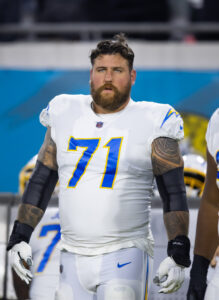 Feiler, 31, has been a starter for the past five seasons — for the Steelers and Bolts — and Pro Football Focus rated him as a top-20 guard in 2019 and ’21. The Bucs have the former UDFA at a discount because of a down 2022, when PFF slotted him outside the top 60 at the position. Given the Bucs’ rampant injury issues up front last season, Feiler offers short-term stability. He has missed just four games over the past four years. The Feiler addition will allow the Bucs to move 2022 second-rounder Luke Goedeke to right tackle, his primary college position.
Feiler, 31, has been a starter for the past five seasons — for the Steelers and Bolts — and Pro Football Focus rated him as a top-20 guard in 2019 and ’21. The Bucs have the former UDFA at a discount because of a down 2022, when PFF slotted him outside the top 60 at the position. Given the Bucs’ rampant injury issues up front last season, Feiler offers short-term stability. He has missed just four games over the past four years. The Feiler addition will allow the Bucs to move 2022 second-rounder Luke Goedeke to right tackle, his primary college position.
Edmonds joins Mayfield in coming off a rough 2022. After his Cardinals work led to a two-year, $12MM Dolphins pact, Edmonds proved a poor fit in Mike McDaniel‘s offense. The Dolphins included the underwhelming satellite back as salary filler in the Bradley Chubb trade. The Broncos then cut him in March. In a bad year to be a free agent running back, Edmonds did score another opportunity and will slide in as the team’s passing-down back complementing Rachaad White. Edmonds, 27, did excel in a similar role alongside Kenyan Drake in 2020 but saw James Conner‘s re-emergence overshadow him the following year.
Re-signings:
- Jamel Dean, CB: Four years, $52MM ($21.5MM guaranteed)
- Anthony Nelson, OLB: Two years, $10MM ($5.5MM guaranteed)
- Lavonte David, ILB: One year, $4.5MM ($4.5MM guaranteed)
- William Gholston, DL: One year, $2.67MM ($1.32MM guaranteed)
- Aaron Stinnie, OL: One year, $1.4MM
- Nick Leverett, OL: One year, $940K
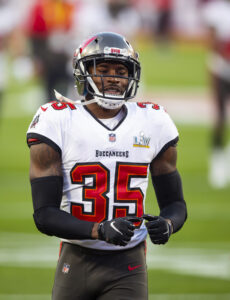 In Saints-like fashion, the Bucs managed to move from $55MM-plus over the cap upon Brady’s February 1 retirement to a place where they could make a viable offer to retain Dean. The Bucs followed their Carlton Davis blueprint with Dean. A year after they let Davis test free agency and then signed him to a three-year, $44.5MM deal, the Bucs reeled Dean back in early during the legal tampering period. Neither Davis nor Dean landed top-10 cornerback money, but both contract sit in the top 15 among AAV at the position.
In Saints-like fashion, the Bucs managed to move from $55MM-plus over the cap upon Brady’s February 1 retirement to a place where they could make a viable offer to retain Dean. The Bucs followed their Carlton Davis blueprint with Dean. A year after they let Davis test free agency and then signed him to a three-year, $44.5MM deal, the Bucs reeled Dean back in early during the legal tampering period. Neither Davis nor Dean landed top-10 cornerback money, but both contract sit in the top 15 among AAV at the position.
Excelling in press coverage, Dean played a major role for the 2020 Super Bowl champion Bucs iteration and overtook Sean Murphy-Bunting last season. Dean did perform better in 2021 compared to 2022, allowing no touchdowns and limiting QBs to a collective 50.0 passer rating; those numbers shot up to four and 86.0 last season. But Dean also played more snaps last year, going from 685 in 2021 to 885. PFF rated Dean as last season’s 10th-best corner, and the former third-round pick will stay with the team that drafted him.
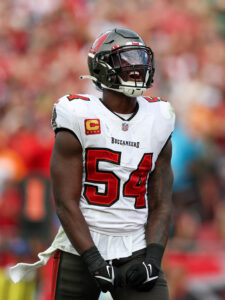 One of the best players in franchise history, David is back with the Bucs on a fourth contract. For a bit, it looked like the linebacker stalwart would leave Tampa after 11 seasons. David, 33, signed a lucrative five-year deal in 2015 and then, as the Bucs completed a historic talent-retention effort to retain the entire core of their Super Bowl LV-winning team, reupped on a two-year deal in 2021. This contract will bring a pay reduction for one of this era’s best off-ball linebackers, but as the Bucs transition to their post-Brady period, keeping David and Dean ensures continuity from their Super Bowl squad.
One of the best players in franchise history, David is back with the Bucs on a fourth contract. For a bit, it looked like the linebacker stalwart would leave Tampa after 11 seasons. David, 33, signed a lucrative five-year deal in 2015 and then, as the Bucs completed a historic talent-retention effort to retain the entire core of their Super Bowl LV-winning team, reupped on a two-year deal in 2021. This contract will bring a pay reduction for one of this era’s best off-ball linebackers, but as the Bucs transition to their post-Brady period, keeping David and Dean ensures continuity from their Super Bowl squad.
The former second-round pick totaled 124 tackles last season and has 10-plus TFLs in four of the past five seasons. David’s three sacks last season quietly ran his total to 29 over the course of his career. With Devin White generating criticism for inconsistency, the Bucs have continued to rely on David. The Nebraska product has seen his consistency pay off. After the Bucs ended a playoff drought that had covered David’s first eight seasons, he became a vital piece for two strong teams to start the 2020s.
Shaq Barrett‘s return from a midseason Achilles tear should move Nelson back to a rotational role — behind Barrett and Joe Tryon-Shoyinka — but the former fourth-round pick does have 10.5 sacks over the past two seasons. Barrett coming back will give the Bucs an interesting two-deep at outside linebacker, with third-rounder Yaya Diaby joining Nelson, who forced three fumbles last season as the Bucs attempted to get by without their top sack artist.
Notable losses:
- Genard Avery, LB
- Giovani Bernard (retired)
- Tom Brady, QB (retired)
- Cameron Brate, TE (released)
- Mike Edwards, S
- Leonard Fournette, RB (released)
- Blaine Gabbert, QB
- Akiem Hicks, DL
- Julio Jones, WR
- Scotty Miller, WR
- Sean Murphy-Bunting, CB
- Carl Nassib, OLB
- Keanu Neal, S
- Rakeem Nunez-Roches
- Breshad Perriman, WR
- Kyle Rudolph, TE (retired)
- Logan Ryan, S
- Donovan Smith, LT (released)
- Ryan Succop, K (released)
- Josh Wells, OL
Brady’s Bucs period added a key separation between he and Bill Belichick‘s legacies, and while the tenure did not necessarily end well, the QB icon reaching seven Super Bowl titles and ending a 12-year Tampa Bay playoff drought classifies the 2020 signing as an undisputed win for the franchise. Brady’s preposterously long prime lasted through the 2021 season, and although he showed flashes (in the form of some wild comebacks) as the 2022 Bucs broke down, the unretirement year brought clear decline signs. Brady used last season to fulfill his longtime goal of playing through age 45, and that feat allowed him to become the only regular QB to go through a season at that age.
Read more
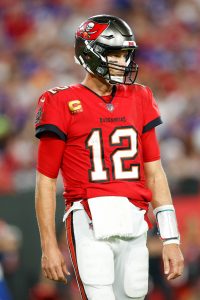 That said, the Mt. Rushmore NFLer’s turbulent 2022 became part of his football legacy as well. Brady unretired less than six weeks after stepping away, with the moves helping push the Bucs to add more veterans (including the re-signings of Davis and Ryan Jensen) and make more moves to hurt future cap sheets. A spring 2022 restructure with Brady inflated the void-years bill — which would hit when his contract expired — to $35.1MM. When Brady signed his 2021 extension, only $24MM in void-years proration damage was on the bill. The 2022 restructure bumped that total, helping shape the Bucs’ 2023 offseason.
That said, the Mt. Rushmore NFLer’s turbulent 2022 became part of his football legacy as well. Brady unretired less than six weeks after stepping away, with the moves helping push the Bucs to add more veterans (including the re-signings of Davis and Ryan Jensen) and make more moves to hurt future cap sheets. A spring 2022 restructure with Brady inflated the void-years bill — which would hit when his contract expired — to $35.1MM. When Brady signed his 2021 extension, only $24MM in void-years proration damage was on the bill. The 2022 restructure bumped that total, helping shape the Bucs’ 2023 offseason.
As the saying goes, “flags fly forever,” and the Bucs now have two Lombardi trophies. Last season, Brady — after a strange summer that included an unusual training camp hiatus and Dolphins player-owner rumors that led to a stiff Miami punishment — finished with his lowest yards-per-attempt figure (6.4) since 2002. O-line issues helped key this descent, and a last-place rushing attack translated to Brady throwing an NFL-record 733 passes.
Last season did not detract from Brady’s legacy, as he remains squarely in the conversation for greatest football player ever. In hindsight, however, staying retired would have been the better move. Even before Brady announced his retirement, Bucs teammates viewed him as prepared to leave Tampa. The Raiders looked into Brady as a player, and the future FOX analyst is now moving toward being a part-owner with the AFC West team. All 31 other teams would have to sign up for Brady having an ownership stake and playing for the Raiders, so January’s Cowboys matchup still likely represents the on-field end for the 23-year veteran.
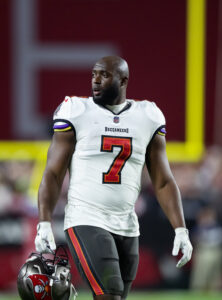 Fournette re-signed to play another season with Brady and collected some cash at an opportune time. Fournette scored $9MM fully guaranteed as part of his three-year, $21MM deal, cashing in before the RB market crashed. The Bucs got out before having to provide another $2MM guarantee this year. While Fournette called this a mutual parting, not being on a roster days before Week 1 does not paint this divorce in such a light.
Fournette re-signed to play another season with Brady and collected some cash at an opportune time. Fournette scored $9MM fully guaranteed as part of his three-year, $21MM deal, cashing in before the RB market crashed. The Bucs got out before having to provide another $2MM guarantee this year. While Fournette called this a mutual parting, not being on a roster days before Week 1 does not paint this divorce in such a light.
The former top-five pick struggled during a brutal season for the Bucs’ rushing attack; its 76.9 yards per game ranked well behind the 31st-place team on the ground. Rachaad White ate into Fournette’s workload, and the elder back finished a fourth season below four yards per carry. Fournette, 28, put together a strong 2021 season before a December hamstring injury and quietly amassed 523 receiving yards last season — partially out of necessity due to the Bucs’ run-game mess. The ex-Jaguars draftee made vital contributions to the Bucs’ 2020 team, but “Lombardi Lenny” now finds himself in the supply-and-demand crunch that permeating the running back landscape.
Post-Fournette, the Bucs had been tied to Ezekiel Elliott and were mentioned as interested in adding a veteran. With Kareem Hunt still available, the Bucs have stood down. They have White and ex-Syracuse star-turned-UDFA Sean Tucker in place, with Edmonds supplementing them in sub-packages. This represents a big audition year for White, who is signed through 2025.
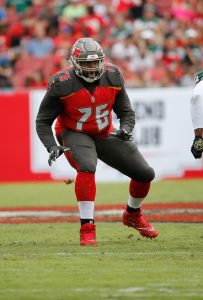 Only Paul Gruber made more starts as a Bucs left tackle than Smith, who logged 124 over eight seasons. Smith signed three contracts with the Bucs and made more than $60MM with the team. Last season brought a downward trek for the Brady-Jameis Winston blindside protector. Smith’s 12 penalties led all tackles, and Bowles contemplated benching him. With Jensen on IR, the Bucs are now down to just one Super Bowl O-line starter left — Tristan Wirfs, who is set to take over Smith’s blindside role.
Only Paul Gruber made more starts as a Bucs left tackle than Smith, who logged 124 over eight seasons. Smith signed three contracts with the Bucs and made more than $60MM with the team. Last season brought a downward trek for the Brady-Jameis Winston blindside protector. Smith’s 12 penalties led all tackles, and Bowles contemplated benching him. With Jensen on IR, the Bucs are now down to just one Super Bowl O-line starter left — Tristan Wirfs, who is set to take over Smith’s blindside role.
Murphy-Bunting intercepted three passes for the Bucs in the 2020 playoffs, playing a key supporting role in Tampa Bay surging to a title. But Davis and Dean became the priorities among the team’s throng of Day 2 secondary draftees. The slot defender’s exit — for a one-year, $3.5MM Titans accord — led to a crowded competition, one rookie UDFA Christian Izien won.
Succop had stabilized a rocky kicker situation. Going into Succop’s tenure, The Bucs had not featured the same primary kicker in a season since the 2011-12 seasons. Succop put a stop to that and was 9-for-9 during Tampa Bay’s four-game 2020 playoff slate. Succop, who will turn 37 next month, was 31-for-38 last season and went through struggles from long range. His 2-for-7 make rate from 50-plus yards led to the Bucs aiming for a better deep striker. McLaughlin went 9-for-12 from 50-plus last season.
Trades:
Tampa Bay was prepared to move on from Mason regardless and found a taker, with Houston providing a clear connection to Mason’s New England days. Texans GM Nick Caserio was in place when the Patriots drafted him (2015) and extended him (2018). Mason’s play was not at the elite level of his Pats days, but during a season in which injuries weakened the Bucs’ O-line, the veteran guard gave them 17 starts. Moving on from Mason was among the many cap maneuvers the Bucs needed to make this offseason, and his exit aligned with a shift away from spending on older vets to align with Brady.
Extensions and restructures:
While this is Year 6 for the Mike Evans–Chris Godwin pair, the Bucs might be thin behind them. The team had paid close attention to its WR3 role with Brady, whose Antonio Brown push led to one of the most infamous on-field sequences in many years. Brown also made contributions during the 2020 playoffs, catching a Super Bowl touchdown. The Bucs have now let Julio Jones and Scotty Miller walk, and Gage suffered a torn ACL in training camp. Gage did well to parlay a modest Falcons run into a three-year, $30MM contract. The Bucs have two rookies — sixth-rounder Trey Palmer and UDFA Rakim Jarrett — and second-year UDFA Deven Thompkins supplementing Evans and Godwin.
Draft:
- Round 1, No. 19: Calijah Kancey, DT (Pittsburgh) (signed)
- Round 2, No. 48 (from Lions through Packers): Cody Mauch, G (North Dakota State) (signed)
- Round 3, No. 82: Yaya Diaby, DE (Louisville) (signed)
- Round 5, No. 153: SirVocea Dennis, LB (Pittsburgh) (signed)
- Round 5, No. 171 (from Rams): Payne Durham, TE (Purdue) (signed)
- Round 6, No. 181 (from Colts): Josh Hayes, CB (Kansas State) (signed)
- Round 6, No. 191 (from Packers through Rams, Texans and Eagles): Trey Palmer, WR (Nebraska) (signed)
- Round 6, No. 196: Jose Ramirez, OLB (Eastern Michigan) (signed)
The Bucs brought both Will Levis and Hendon Hooker in for “30” visits. Rather than stopping the former’s slide out of Round 1, Tampa Bay went with one of this draft’s cleanest prospects. Kancey made headlines by not taking pre-draft visits, injecting some mystery into his potential landing spot. Kancey’s measurables, 40-yard dash time (4.67 seconds) and alma mater have led to probably unfair comparisons, as Aaron Donald is also a short defensive tackle from Pitt. That comparison sets the bar extraordinarily high, but Kancey did total 14.5 sacks and 27.5 tackles for loss over the past two seasons.
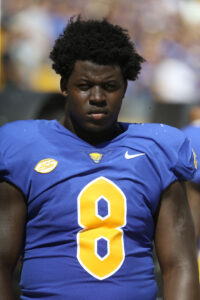 As expected, Kancey climbed into Tampa Bay’s starting lineup, where he will flank Vita Vea and Logan Hall. With Gholston and Gaines positioned as rotational D-linemen, the Bucs have an interesting mix here. Vea is one of the NFL’s best defensive linemen; the sixth-year DT makes life easier for those around him. But he quietly totaled a career-high 6.5 sacks last season. His presence will help Kancey assimilate as a rookie, as will the return of Barrett.
As expected, Kancey climbed into Tampa Bay’s starting lineup, where he will flank Vita Vea and Logan Hall. With Gholston and Gaines positioned as rotational D-linemen, the Bucs have an interesting mix here. Vea is one of the NFL’s best defensive linemen; the sixth-year DT makes life easier for those around him. But he quietly totaled a career-high 6.5 sacks last season. His presence will help Kancey assimilate as a rookie, as will the return of Barrett.
For a second straight year, the Bucs are converting a college tackle into an NFL guard. Mauch worked at both left and right tackle at North Dakota State, though he mostly operated on the blind side (37 starts) for the Bison. The Bucs already bailed on making Luke Goedeke a guard, but they will station Mauch next to their new right tackle.
This will make for an inexperienced line protecting Mayfield, who enjoyed a Jack Conklin–Wyatt Teller right-side setup during his best year in Cleveland. But the Bucs certainly needed to make a high-level O-line investment considering what happened last year.
Other:
Advancing deep into the Jaguars’ 2022 HC search, Leftwich was believed to have bowed out of the race. An issue working with GM Trent Baalke affected Leftwich’s interest in landing with the team that drafted him in the 2003 first round. Months later, Bruce Arians‘ surprise exit left Leftwich as the lead offensive voice with the Bucs. While Brady clearly signed off on working with Leftwich alone, the Bucs’ offense tanked in 2022. After ranking second in scoring in 2021, Tampa Bay plummeted to 25th last year. This led to some Brady grumbling about Leftwich, and Bowles canned him at season’s end.
 This dismissal, among others, left Arians upset. As the story went, Brady did not force Arians out upon unretiring last year — despite reports of those two butting heads in 2021 — but rather the Super Bowl-winning HC wanted to position Bowles with a good opportunity. Regardless, Bowles fired a host of Arians assistants that had time left on their contracts. It is truly Bowles’ show now. With his HC record at 34-50 thanks largely to helming some woeful Jets teams, the 59-year-old HC has some pressure on him. Leftwich was linked to other jobs but is not on a coaching staff going into this season.
This dismissal, among others, left Arians upset. As the story went, Brady did not force Arians out upon unretiring last year — despite reports of those two butting heads in 2021 — but rather the Super Bowl-winning HC wanted to position Bowles with a good opportunity. Regardless, Bowles fired a host of Arians assistants that had time left on their contracts. It is truly Bowles’ show now. With his HC record at 34-50 thanks largely to helming some woeful Jets teams, the 59-year-old HC has some pressure on him. Leftwich was linked to other jobs but is not on a coaching staff going into this season.
Canales, 42, will take play-calling reins for the first time. Having spent every year of his college and NFL coaching life on a Pete Carroll staff, Canales finally left Seattle as OC interest developed. Canales spent eight years as the Seahawks’ receivers coach, making a noticeable jump from a one-year role as a USC strength coach, and moved into a pass-game coordinator role in 2020. Sliding over to QBs coach in 2022 brought a turning point, with Geno Smith offering one of the more stunning QB seasons in recent NFL history. Canales will ride that Comeback Player of the Year campaign into an OC opportunity.
The Bucs gave Leftwich play-calling duties upon hiring him in 2019, but Arians was there to supervise. With Bowles a defense-oriented HC, Canales will lead the offensive operation this year. Tampa Bay will hope Canales can do for Mayfield what he and Shane Waldron did for Smith last year.
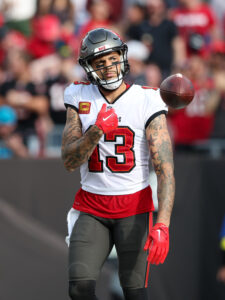 Tampa Bay matches Seattle’s WR arrangement, at least, with Evans-Godwin one of just two receiving tandems (along with Keenan Allen–Mike Williams) that have been in place longer than Tyler Lockett–D.K. Metcalf. This year looks like the end for by far the most successful WR duo in Bucs history. Evans’ Sept. 9 deadline looks likely to come and go without an extension agreement, as his camp has angled for one for multiple years only to see no offer materialize. This deadline came weeks after Licht said the team wants the contract-year standout around on another extension. With a Friday report indicating the 6-foot-5 weapon is, in fact, not in the Bucs’ extension plans, it is safe to wonder when he will be traded.
Tampa Bay matches Seattle’s WR arrangement, at least, with Evans-Godwin one of just two receiving tandems (along with Keenan Allen–Mike Williams) that have been in place longer than Tyler Lockett–D.K. Metcalf. This year looks like the end for by far the most successful WR duo in Bucs history. Evans’ Sept. 9 deadline looks likely to come and go without an extension agreement, as his camp has angled for one for multiple years only to see no offer materialize. This deadline came weeks after Licht said the team wants the contract-year standout around on another extension. With a Friday report indicating the 6-foot-5 weapon is, in fact, not in the Bucs’ extension plans, it is safe to wonder when he will be traded.
First-round wideouts have largely not panned out for the Bucs, who could not generate sustained success from Michael Clayton (2004) or Reidel Anthony (1997). Even Tampa’s modern-era second-round wideout history (Arrelious Benn, Dexter Jackson — not the Super Bowl MVP — and Jacquez Green) resulted in misfires. Chosen in Jason Licht‘s second year as GM, Evans brought a seismic course change. His 10,425 receiving yards as a Buccaneer almost doubles second place (Godwin, 5,666) in team history. Evans, 30, is the only NFLer to begin a career with nine straight 1,000-yard seasons. No one else has started with eight.
 Attached to a $13MM base salary, Evans will not be too easy for a team to fit on their cap sheet. But if he continues to provide durability, his name seems a certainty to come up in trade rumors — especially if the Bucs perform as oddsmakers suggest. With the receiver tag going over $20MM next year, Evans is probably not a realistic tag candidate ahead of his age-31 season. That said, if the NFC South is as bad as it was last year, the Bucs may spurn trade overtures and hang onto their longtime WR1. Godwin’s injury history would further support Tampa Bay merely accepting a late-round compensatory pick for Evans if/once he walks as a free agent in 2024.
Attached to a $13MM base salary, Evans will not be too easy for a team to fit on their cap sheet. But if he continues to provide durability, his name seems a certainty to come up in trade rumors — especially if the Bucs perform as oddsmakers suggest. With the receiver tag going over $20MM next year, Evans is probably not a realistic tag candidate ahead of his age-31 season. That said, if the NFC South is as bad as it was last year, the Bucs may spurn trade overtures and hang onto their longtime WR1. Godwin’s injury history would further support Tampa Bay merely accepting a late-round compensatory pick for Evans if/once he walks as a free agent in 2024.
White is also not a realistic tag candidate, with all linebackers grouped together under the tag formula. That would balloon the tag past $21MM next year. The Bears faced this dilemma with Roquan Smith, ultimately trading him to the Ravens for second- and fifth-round picks. The Bucs would probably move White if they received that offer. Impressive stats appear on White’s resume, but he has generated criticism for loafing and freelancing. PFF has never ranked the athletic defender as even a top-60 linebacker. Although the Ravens gave Smith a new ILB-record contract ($20MM per year), the Bucs are not going there with White.
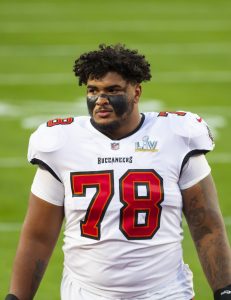 After backing off his trade request — one aimed at securing top-tier ILB dough — White may be auditioning for his next team this season. He likely needs a strong contract year to score an eight-figure-per-year deal, seeing as only one linebacker who hit this year’s crowded market — Tremaine Edmunds — collected more than $11MM AAV. Would the Bucs consider moving White before the deadline? Tepid interest came their way after the trade request surfaced.
After backing off his trade request — one aimed at securing top-tier ILB dough — White may be auditioning for his next team this season. He likely needs a strong contract year to score an eight-figure-per-year deal, seeing as only one linebacker who hit this year’s crowded market — Tremaine Edmunds — collected more than $11MM AAV. Would the Bucs consider moving White before the deadline? Tepid interest came their way after the trade request surfaced.
Wirfs, on the other hand, is a surefire extension target. The 2020 first-round pick brought an easy fifth-year option decision, becoming one of the NFL’s best tackles — left or right. The Bucs will now put Wirfs in position to do even better on his second contract, shifting him to the left side.
Bowles informed Wirfs of the team’s plans immediately after last season. A good season protecting Mayfield would put Wirfs in line to command a deal north of the one Andrew Thomas recently inked. The Giants made Thomas the NFL’s second-highest-paid tackle, at $23.5MM per year. Wirfs has a greater body of work; will he prove it on the blind side?
Top 10 cap charges for 2023:
- Mike Evans, WR: $23.69MM
- Shaquil Barrett, OLB: $21.25MM
- Devin White, ILB: $11.71MM
- Chris Godwin, WR: $8.61MM
- Carlton Davis, CB: $7.48MM
- Vita Vea, NT: $6.52MM
- Ryan Jensen, C: $5.93MM
- Russell Gage, WR: $4.43MM
- Jamel Dean, CB: $3.81MM
- Tristan Wirfs, T: $3.71MM
At $76.76MM, the Bucs lead the NFL in 2023 dead money, nipping the Rams ahead of Week 1. That setup reminds of the Falcons’ 2022 financial backdrop, which involved big dead-cap hits from Matt Ryan — a record-setter — and Deion Jones. Atlanta still contended in a terrible division. Tampa Bay will certainly hope to follow suit, though despite many Super Bowl starters still in place, a Bowles-Mayfield duo leading the way does not inspire much confidence.
The 2024 Bucs could look quite different, but the team retaining Dean and David does point to at least fringe contention hopes for the 2023 team. Mayfield will undoubtedly be headed toward the QB2 rung if this year goes as most think it will; can the Bucs salvage the former playoff starter’s career?
By Adam La Rose |
at September 7, 2023 9:48 pm
Life after Russell Wilson began for the Seahawks in 2022, a season in which very little was expected of the team. Rather than setting upon a long-term organizational reset, however, Seattle remained competitive in large part due to the surprising success Geno Smith found in his latest opportunity to serve as an NFL starter. The veteran steered the team to a playoff berth, and the young contributors added in each of the past two drafts offer considerable reasons for optimism moving forward.
Weaknesses on defense were exposed throughout the season, though, and much of the team’s efforts in recent months (including a reunion with an icon from Seattle’s Super Bowl-winning core) has been aimed at addressing them. If they prove to have been successful, Smith – the reigning Comeback Player of the Year who has a new, more lucrative Seahawks deal in place – will be well-positioned to prove 2022’s success was not a fluke.
Free agency additions:
- Dre’Mont Jones, DT: Three years, $51.53MM ($23MM guaranteed)
- Julian Love, S: Two years, $12MM ($5.98MM guaranteed)
- Bobby Wagner, LB: One year, $5.5MM ($4.48MM guaranteed)
- Jarran Reed, DT: Two years, $9MM (4.19MM guaranteed)
- Devin Bush, LB: One year, $3.5MM ($2.99MM guaranteed)
- Evan Brown, C: One year, $2.25MM ($1MM guaranteed)
- Mario Edwards, DE: One year, $1.32MM ($153K guaranteed)
- Austin Faoliu, DL: One year, $750K
Seattle ranked 30th against the run in 2022, and breakdowns in the front seven were common during the regular season. That factored into the team’s postseason exit as well, as the 49ers recorded over 500 yards of offense in their wild-card victory over the Seahawks. Long before free agency began, it was therefore obvious that much of the offseason would need to be devoted to reconfiguring the defensive line and linebacking corps. 
Jones will be at the heart of that effort, tasked with providing a much-needed boost with respect to interior pass-rushing production. The Seahawks finished tied for seventh in the league in sacks last year, but much of that came off the edge. If Jones can replicate his success from Denver, more balance will be attained. The 26-year-old totaled 22 sacks and 60 pressures across four years with the Broncos, making him one of the most attractive members of a deep D-line free agent class.
The Broncos were interested in retaining Jones, but for a time he seemed to be headed toward a deal with his hometown Browns. In the end, the former third-rounder landed a contract with a higher AAV than what both Denver and Cleveland gave to Zach Allen and Dalvin Tomlinson, respectively. The latter two are regarded as better run defenders than Jones, but if he remains productive on passing downs, he will be central to a rebound performance from Seattle’s defense.
Both Reed – who is returning to Seattle after spending his first five seasons there – and Edwards are in line for starting roles alongside Jones. That new trio will give the team a much different look in its second year with a 3-4 base scheme, although depth additions could be on the radar. In any event, the play of the revamped D-line will be a major storyline in 2023.
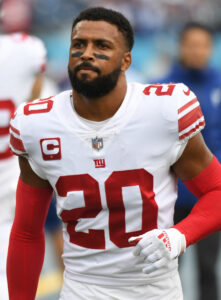 The Seahawks already had the league’s most expensive safety tandem in Jamal Adams and Quandre Diggs before adding Love to the mix. The latter expressed a desire to remain with the Giants after his breakout season, though he was acutely aware of how his 2022 production helped his earning power. The 25-year-old will be able to hit the open market a second time rather quickly if he plays out this Seattle deal without an extension, though he could play his way into the team’s long-term plans if he picks up where he left off last season.
The Seahawks already had the league’s most expensive safety tandem in Jamal Adams and Quandre Diggs before adding Love to the mix. The latter expressed a desire to remain with the Giants after his breakout season, though he was acutely aware of how his 2022 production helped his earning power. The 25-year-old will be able to hit the open market a second time rather quickly if he plays out this Seattle deal without an extension, though he could play his way into the team’s long-term plans if he picks up where he left off last season.
Love posted career-highs in a number of categories during the 2022 campaign, his first operating as a full-time starter. He remained a constant in a Giants secondary which faced injury absences for much of the year, seeing usage at a number of different spots on the field. The Notre Dame alum thus made himself one of several noteworthy safeties who were available in free agency, although a number of players with a longer track record at the position secured more lucrative deals.
Adams’ history of missed time – which will continue into the 2023 campaign – could make Love’s presence particularly important for Seattle. Plenty of playing time should be available when the Seahawks’ starting trio are all healthy, in any case, and Love will be a central figure in the team’s play on the backend.
Wagner’s fifth career contract is far smaller than all but his rookie pact, but it will be a valuable one on several fronts if he can maintain his level of play upon his return to the Emerald City. A central figure in the Legion of Boom-era defenses throughout a 10-year Seahawks run to begin his career, the eight-time Pro Bowler’s time with the team appeared to be over when he took a five-year, $50MM contract with the division rival Rams last offseason. 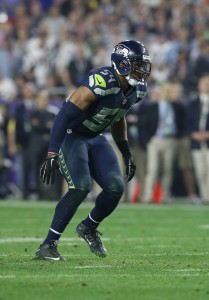
The 33-year-old drew the No. 1 PFF grade amongst inside linebackers in his debut Los Angeles season. After a calamitous title defense, however, the Rams elected to part ways with several high-priced veterans. Part of that process including granting Wagner’s release request, clearing the way for his return to Seattle, one which could result in up to $7MM in earnings. The six-time first-team All-Pro will reprise the starting role at the Seattle LB spot he has held for most of his career, and a continuation of his past performances would go a long way in stabilizing the Seahawks’ reconfigured front seven.
Bush could play a role in that regard as well, and success in a new environment would do wonders for his career. The former Steelers first-rounder flamed out in the seasons following his 2020 ACL tear, seeing his playing time drop sharply in each of the past two years. Bush, 25, will likely work in a rotational capacity behind Wagner and incumbent starter Jordyn Brooks, neither of whom are on the books for 2024. He could thus play his way into an extended stay in Seattle, or at least help his prospects in free agency next spring.
Re-signings:
- Geno Smith, QB: Three years, $75MM ($27.3MM guaranteed)
- Jason Myers, K: Four years, $21.1MM ($8.67MM guaranteed)
- Phil Haynes, G: One year, $4MM ($3.49MM guaranteed)
- Nick Bellore, LB: Two years, $6.6MM ($2.3MM guaranteed)
- Drew Lock, QB: One year, $4MM ($1.75MM guaranteed)
- Michael Jackson, CB: One year, $940K
- Cody Thompson, WR: One year, $870K
- Myles Adams, DL: One year, $870K
After the blockbuster deal sending Wilson to Denver, a QB competition which received little fanfare took place last summer. Many expected Lock, part of the package sent by the Broncos, to beat out Smith for the starting role. It was instead the latter who earned the No. 1 job, and he held it for every snap of the regular and postseason.
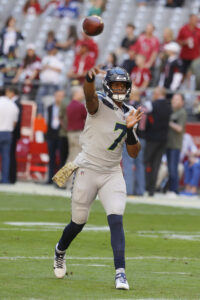 Six years removed from his last campaign as a full-time starter, Smith authored an incredibly unlikely success story in 2022. The 32-year-old led the league in completion percentage (69.8%), shattered his career high in touchdown passes (30) and finished in the top 10 of MVP voting. A considerable raise from the $3.5MM he saw in 2022 and the smaller figures represented in his previous one-year Seahawks pacts was in order.
Six years removed from his last campaign as a full-time starter, Smith authored an incredibly unlikely success story in 2022. The 32-year-old led the league in completion percentage (69.8%), shattered his career high in touchdown passes (30) and finished in the top 10 of MVP voting. A considerable raise from the $3.5MM he saw in 2022 and the smaller figures represented in his previous one-year Seahawks pacts was in order.
On the other hand, Seattle was frequently named as a team to watch with respect to drafting a passer in April. Both head coach Pete Carroll and general manager John Schneider admitted to doing more QB scouting than usual while in the rare position of having a top-five pick (owing to the Broncos’ struggles in their first season with Wilson at the helm). A long-term answer at the position will still likely be coming sooner than later. But for at least one more year the Seahawks will maintain the Smith-Lock tandem.
Should Smith’s 2022 turn out to be fluky, the Seahawks will be able to escape this contract fairly easily in 2024. The team could move on via a post-June 1 cut in either of the next two offseasons and see notable cap savings against only an $8.7MM dead cap charge. Despite his success last year, Smith will therefore face another round of considerable expectations as he looks to back up his production and lead the Seahawks to consecutive postseason berths.
Lock’s deal can reach up to $7.5MM via incentives, something which would come into play if Smith were to miss time or regress. Either scenario could put his Seattle future in jeopardy, given the fact his contract only includes full guarantees for this season.
Myers proved to be a solid investment in 2019 after his stints with the Jaguars and Jets. He has gone a combined 98-for-112 on field goals during his time in Seattle (including 13-for-17 on kicks beyond 50 yards). The 32-year-old earned a second career Pro Bowl nod in 2022 and made the decision to authorize a re-up an easy one from the team’s perspective. Meyers now sits third in the league for AAV amongst kickers ($5.28MM) behind only Justin Tucker and Matt Gay, setting himself up to continue his consistent play with the Seahawks.
Read more
Notable losses:
- Cody Barton, LB
- Austin Blythe, C (retired)
- L.J. Collier, DE
- Poona Ford, DT
- Marquise Goodwin, WR
- Shelby Harris, DT (released)
- Penny Hart, WR
- Travis Homer, RB
- Gabe Jackson, G (released)
- Quinton Jefferson, DT (released)
- Tanner Muse, LB
- Ryan Neal, S
- Tyler Ott, LS
- Rashaad Penny, RB
- Al Woods, DT (released)
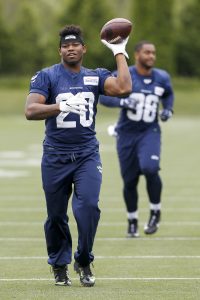 Penny was one of two former first-rounders whose Seattle departure came as little surprise in free agency. Highly efficient when on the field with a career 5.7 yards-per-carry average, Penny has missed notable time in every year since his rookie campaign. The San Diego State alum has been limited to just 18 games over the past three years, a fact which hurt his value on the open market.
Penny was one of two former first-rounders whose Seattle departure came as little surprise in free agency. Highly efficient when on the field with a career 5.7 yards-per-carry average, Penny has missed notable time in every year since his rookie campaign. The San Diego State alum has been limited to just 18 games over the past three years, a fact which hurt his value on the open market.
Penny landed just $600K guaranteed to serve in a Miles Sanders-less Eagles backfield committee. Homer will find himself in a similar situation with the Bears as they begin the post-David Montgomery era at the RB spot. With Offensive Rookie of the Year runner up Kenneth Walker atop their depth chart, though, the Seahawks should feel comfortable in their running game moving forward.
With both Blythe and Jackson no longer in the picture, however, Seattle’s offensive front will look different in 2023. Neither blocker had a lengthy stay with the Seahawks, nor were they able to duplicate the success they found elsewhere in terms of PFF evaluations. Jackson, 32, remains unsigned despite having 130 starts to his name. Stronger play at the C and RG spots will be a target for Evan Brown and Phil Haynes, respectively, as the team looks to build off the strong tackle play generated from last year’s draft class.
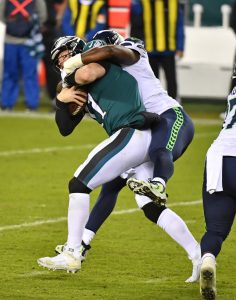 Given the team’s struggles along the defensive front last season, it came as no surprise that Ford was allowed to depart in free agency while Woods, Jefferson and Harris were let go in cost-shedding moves in another high-turnover offseason along Seattle’s D-line. Harris was under consideration to be brought back on a less expensive deal, but his extended stay on the open market ultimately led him to a Browns team which is likewise seeking to take a major step forward on the D-line in 2023.
Given the team’s struggles along the defensive front last season, it came as no surprise that Ford was allowed to depart in free agency while Woods, Jefferson and Harris were let go in cost-shedding moves in another high-turnover offseason along Seattle’s D-line. Harris was under consideration to be brought back on a less expensive deal, but his extended stay on the open market ultimately led him to a Browns team which is likewise seeking to take a major step forward on the D-line in 2023.
That quartet of defenders combined to play over 2,100 snaps in 2022, leaving plenty of playing time available for their replacements. Collier was not, however, a significant contributor in his final Seahawks campaign. After having his fifth-year option declined, the TCU alum logged just a 28% snap share last season, marking an end to a disappointing four-year stretch. Arizona will, like Seattle attempted to, use Collier at a variety of D-line spots in the hope finding one which breeds statistical success. While the Seahawks have received praise for their past two drafts, the Carroll-Schneider regime’s against-the-grain decisions with Penny and Collier backfired.
Both Barton (26) and Neal (27) were mainstays during their time in Seattle, but the respective arrivals of Bobby Wagner and Julian Love left them in need of new homes. The linebacker and safety spots should be areas of strength in 2023 if Seattle’s starters remain healthy and live up to their pedigree, but as is the case along the defensive line, familiar faces will be lacking as the team integrates a plethora of new contributors.
Extensions and restructures:
Nwosu put up modest numbers to begin his Chargers career, seeing incremental jumps in playing time over his first three seasons with the team. His contract year yielded a spike in production, with Melvin Ingram out of the picture. That showing landed him a two-year, $20MM Seattle agreement. The USC alum proved that investment to be a worthwhile one. 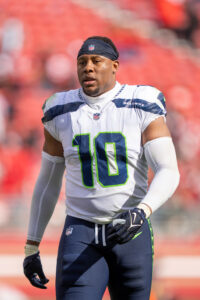
Lining up opposite Darrell Taylor on the edge, Nwosu tied his sack partner with a team-leading 9.5 in that department. That figure also marked a Nwosu career high for the second straight year and confirmed a considerable raise on a deal keeping him in place through his prime years was in order. The 26-year-old is now under contract through 2026 (a season in which he could earn up to $6MM extra via incentives) and is set to carry a reasonable cap hit for three of the next four years.
Nwosu will face major expectations not only because of the numbers he put up in the team’s first year after transitioning to a 3-4 scheme, but also the plethora of new faces along the defensive line. If the interior pass rush does not emerge as planned, much of the Seahawks’ defensive improvement in 2022 will depend on him continuing to pressure quarterbacks at a high rate. Seattle should be confident that will be the case for the foreseeable future, though.
Lockett has been a model of consistency during his eight-year run in the Emerald City, recording at least 73 catches, 1,033 yards and eight touchdowns in each of the past four years. He has a strong chance to move into second on the franchise’s all-time receiving list this season, but his future beyond 2023 could see further adjustments to his pact. The 30-year-old is set to carry cap hits of $26.9MM in 2024 and ’25, and no guaranteed money is due for those years. For at least one more season, however, he should provide cost-effective production in the passing game.
Adams is likewise due to count heavily against the cap in future years, in part due to the adjustment to his deal. The former Jets first-rounder could confirm his importance to Seattle with a productive 2023 campaign, but failure to do so would make his $26MM-plus cap hits hard to swallow over the following two years. Like Lockett, Adams does not have guaranteed money due after this season, and his release would yield notable savings if designated as a post-June 1 cut starting next spring.
Draft:
- Round 1, No. 5 (from Broncos): Devon Witherspoon, CB (Illinois) (signed)
- Round 1, No. 20: Jaxon Smith-Njigba, WR (Ohio State) (signed)
- Round 2, No. 37 (from Broncos): Derick Hall, DE (Auburn) (signed)
- Round 2, No. 52: Zach Charbonnet, RB (UCLA) (signed)
- Round 4, No. 108 (from Broncos): Anthony Bradford, G (LSU) (signed)
- Round 4, No. 123: Cameron Young, DT (Mississippi State) (signed)
- Round 5, No. 151 (from Steelers): Mike Morris, DE (Michigan) (signed)
- Round 5, No. 154: Olusegun Oluwatimi, C (Michigan) (signed)
- Round 6, No. 198: Jerrick Reed II, S (New Mexico) (signed)
- Round 7, No. 237: Kenny McIntosh, RB (Georgia) (signed)
If the Seahawks’ 2023 draft class makes anywhere near the impact of last year’s, the team will be in business for short- and long-term success. The benefits from the Wilson trade continued into this past April, and it gave the Carroll-Schneider regime a rare opportunity to select in the top five, as well as additional Day 2 draft capital. Both Broncos picks yielded defensive additions which should help the rebuilding effort on that side of the ball.
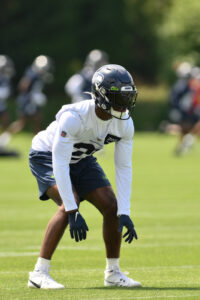 By the time the draft began, Witherspoon was the consensus top defensive back in the class. Though, the gap between he and fellow corner Christian Gonzalez was not expected to be as large as the latter’s drop to the No. 17 pick (and ranking as the third CB off the board) would suggest. The headliner of a well-respected fighting Illini secondary, Witherspoon showcased ball production and strength as a run defender by piling up three interceptions, 23 pass deflections and 10.5 tackles for loss across his final two college seasons.
By the time the draft began, Witherspoon was the consensus top defensive back in the class. Though, the gap between he and fellow corner Christian Gonzalez was not expected to be as large as the latter’s drop to the No. 17 pick (and ranking as the third CB off the board) would suggest. The headliner of a well-respected fighting Illini secondary, Witherspoon showcased ball production and strength as a run defender by piling up three interceptions, 23 pass deflections and 10.5 tackles for loss across his final two college seasons.
A 2022 first-team All-American, the 6-foot, 180-pounder will see plenty of time lining up opposite 2022 fifth-rounder Tariq Woolen. The latter took the league by storm as a rookie, tying for the NFL lead in interceptions (six). A pairing of he and Witherspoon could give Seattle a highly productive CB tandem right away and for years to come if both play to their potential.
Carroll, notably, was believed to be on board with the idea of taking defensive tackle Jalen Carter at No. 5 in spite of the Georgia alum’s legal troubles and character concerns. That sentiment did not seem to be matched elsewhere in the organization, though, leading to a safer selection in Witherspoon but also an interesting what-if situation to monitor as Carter ultimately landed ninth overall with the Eagles.
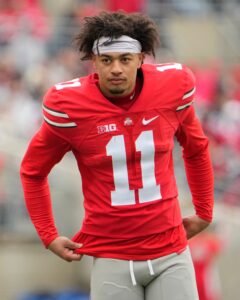 Back on the clock in a more familiar draft spot, the Seahawks had their pick of the lot at the receiver position with their second first-round selection. It thus came as little surprise that Smith-Njigba was the team’s preference, as an injured-shortened 2022 season still left him at the top of many WR rankings leading up to the draft. The 21-year-old enjoyed a stellar sophomore season (95 catches, 1,606 yards, nine touchdowns) while competing for targets with eventual first-rounders Garrett Wilson and Chris Olave.
Back on the clock in a more familiar draft spot, the Seahawks had their pick of the lot at the receiver position with their second first-round selection. It thus came as little surprise that Smith-Njigba was the team’s preference, as an injured-shortened 2022 season still left him at the top of many WR rankings leading up to the draft. The 21-year-old enjoyed a stellar sophomore season (95 catches, 1,606 yards, nine touchdowns) while competing for targets with eventual first-rounders Garrett Wilson and Chris Olave.
Those totals made his three-game junior season — hindered by a nagging hamstring injury — a disappointment, but it will still lead to high expectations at the NFL level. D.K. Metcalf and Tyler Lockett will eat up plenty of targets in Seattle’s passing game, but Smith-Njigba could see considerable time in the slot. It is there that he is likely to see much of his time in the pro game, as it would allow for his route-running prowess to compensate for a lack of top-end speed. In any case, he should provide at least a complementary option on offense with the potential to develop into a focal point in the future.
Hall posted strong numbers in his final two Tigers seasons in particular, but much of his success has been attributed more to effort than top-tier athleticism or overwhelming size. If he follows a similar path to 2022 second-rounder Boye Mafe, though, a rotational role and the opportunity for modest production should be in store. Charbonnet, likewise, is set to begin his Seattle career behind Kenneth Walker on the depth chart. However, it does appear the former Michigan transfer’s prowess in the passing game has him in line for third-down work right away; success in that regard could strengthen Seattle’s backfield and give the team a long-term tandem at the position.
Other:
Brooks graduated to full-time starting duties in his second season, and he has filled the statsheet since then. The Texas Tech alum has racked up 345 tackles (second-most in the league in that span), including 13 for loss, along with a pair of sacks and 10 pass breakups over the last two years. Those figures have not translated to favorable PFF evaluations, however, and, like all other inside ‘backers from the 2020 draft class, he will enter this season without being on the books for next year. Brooks joins all other Seattle first-round picks in having his option declined since the current system was implemented in 2011.
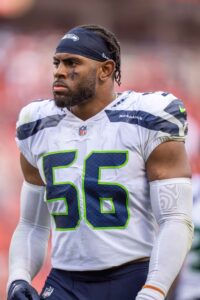 The 25-year-old will maintain his first-string role in 2023, and with Bobby Wagner and Devin Bush also headed for free agency next March, Brooks should still be in the Seahawks’ plans for years to come. A multi-year deal may not reach the eight-figure-per-year mark (which would be required to move him into the top 10 at the position in annual compensation), but a notable raise could still be in the cards if he can put together a strong season this year. Health will be a factor to monitor in 2023, though.
The 25-year-old will maintain his first-string role in 2023, and with Bobby Wagner and Devin Bush also headed for free agency next March, Brooks should still be in the Seahawks’ plans for years to come. A multi-year deal may not reach the eight-figure-per-year mark (which would be required to move him into the top 10 at the position in annual compensation), but a notable raise could still be in the cards if he can put together a strong season this year. Health will be a factor to monitor in 2023, though.
Brooks missed the final game of last season with an ACL tear, and he was sidelined for much of the offseason while recovering. The fact that Seattle was able to activate him from the active/PUP list last month puts Brooks on track to be in the lineup in Week 1, but his ability to return to pre-injury form will be worth watching closely. A healthy campaign will do wonders for Brooks’ financial situation with the Seahawks or another team in the future.
Both Canales (42) and Desai (40) received looks from multiple teams in need of coordinators this offseason. The former interviewed twice for the Ravens’ OC gig before ultimately landing one in Tampa. That gig will give Canales his first chance to lead an NFL offense. Canales drew significant praise for his role in Geno Smith’s remarkable success story last year, and he will aim to replicate that scenario with a Buccaneers team relying on Baker Mayfield under center.
Desai, meanwhile, met once each with the Broncos, Dolphins and Vikings in their respective searches for a defensive upgrade on the sidelines. He will once again hold a DC title after having ascended to that position with the Bears in 2021. The arrival of a new staff in Chicago last year led Desai to Seattle, where the team’s performance did not match the reputation he has generated as one of the league’s up-and-coming defensive minds. He will face a tall task in Philadelphia helping guide the defending NFC champions, who lost a number of defensive starers in free agency. But success with the Eagles could put him on the head coaching track before long.
Amazon founder Jeff Bezos was frequently linked to a potential bid on the Commanders, but none came. He is still a name to watch with respect to a potential Seahawks sale, something many expect will take place in the not-too-distant future. Nothing will take place before May 2, 2024, in all likelihood, given the nature of Allen’s estate situation. Still, her willingness to explore a sale (something which does not currently exist, as her remarks last summer confirmed) will be an ongoing storyline for the organization – especially if Bezos becomes involved.
Top 10 cap charges for 2023:
- D.K. Metcalf, WR: $13.72MM
- Quandre Diggs, S: $11.94MM
- Jamal Adams, S: $11.5MM
- Tyler Lockett, WR: $11.06MM
- Geno Smith, QB: $10.1MM
- Uchenna Nwosu, OLB: $10.1MM
- Dre’Mont Jones, DT: $10.06MM
- Will Dissly, TE: $9.19MM
- Bobby Wagner, LB: $7MM
- Noah Fant, TE: $6.85MM
If Smith’s 2023 play is near the level of his 2022 performance, he will prove to be a bargain considering the current going rate for starting quarterbacks. However, he is one of five players listed whose cap hit is set to jump over $20MM next season (above $30MM, in Smith’s case). With Jones due for an increased cap burden by a margin of $8MM and Wagner and Fant set to hit free agency in the spring, plenty of difficult decisions will need to be made and the team’s youth movement at many positions will likely continue.
Questions will linger about Smith’s ability to back up his 2022 success as the season begins, but even a slight regression should be easier to manage given the skill-position contingent surrounding him. If the multitude of efforts made to shore up the defense prove effective, a postseason berth in what appears to be a comparatively weak NFC would come as no surprise. Another year of top-level play from this year’s rookie class could even vault Seattle into contention for one of the deep postseason runs the franchise became accustomed to in the 2010s.
 The Raiders had swerved off this route after Al Davis Cable’s interim tag, hiring veterans like Gruden, McDaniels and Jack Del Rio. Pierce went 5-4 as an interim HC, with the Raiders’ one-sided road win over the Chiefs beginning his charge in earnest for the full-time gig. Still, Pierce’s only full-time coaching positions are Raiders linebackers coach, Arizona State defensive coordinator, Sun Devils LBs coach and Long Beach Poly High HC.
The Raiders had swerved off this route after Al Davis Cable’s interim tag, hiring veterans like Gruden, McDaniels and Jack Del Rio. Pierce went 5-4 as an interim HC, with the Raiders’ one-sided road win over the Chiefs beginning his charge in earnest for the full-time gig. Still, Pierce’s only full-time coaching positions are Raiders linebackers coach, Arizona State defensive coordinator, Sun Devils LBs coach and Long Beach Poly High HC. Interim GM Kelly sat in on Raiders HC interviews, but the Raiders were not committed to keeping Dave Ziegler‘s former assistant GM atop the front office. Davis instead chose to pair Pierce with one of the NFL’s most experienced GMs. Telesco spent 11 seasons running the Chargers, and although the team’s underachievement reputation grew to define it during this span, Davis was sufficiently impressed with the Bolts’ roster strength to look beyond their 3-for-11 playoff rate under Telesco. Not counting the Eagles having reinstalled Howie Roseman atop their FO pyramid, Telesco is only the second current GM to be given a second chance, joining Trent Baalke (Jaguars).
Interim GM Kelly sat in on Raiders HC interviews, but the Raiders were not committed to keeping Dave Ziegler‘s former assistant GM atop the front office. Davis instead chose to pair Pierce with one of the NFL’s most experienced GMs. Telesco spent 11 seasons running the Chargers, and although the team’s underachievement reputation grew to define it during this span, Davis was sufficiently impressed with the Bolts’ roster strength to look beyond their 3-for-11 playoff rate under Telesco. Not counting the Eagles having reinstalled Howie Roseman atop their FO pyramid, Telesco is only the second current GM to be given a second chance, joining Trent Baalke (Jaguars). Pierce’s team walloping the Chargers 63-21 on national TV led to Telesco and Brandon Staley‘s ousters. It is, then, rather interesting Telesco resurfaced alongside Pierce in Las Vegas. The Raiders gave Telesco roster control, which he also held in California. Telesco brought former Chargers exec-turned-interim GM Wooden with him, but he is working primarily with two staffers — Pierce and Kelly — he did not hire. With Kelly having interviewed for the Raiders’ GM job in 2022 and ’24, this forced partnership will be a notable AFC West storyline.
Pierce’s team walloping the Chargers 63-21 on national TV led to Telesco and Brandon Staley‘s ousters. It is, then, rather interesting Telesco resurfaced alongside Pierce in Las Vegas. The Raiders gave Telesco roster control, which he also held in California. Telesco brought former Chargers exec-turned-interim GM Wooden with him, but he is working primarily with two staffers — Pierce and Kelly — he did not hire. With Kelly having interviewed for the Raiders’ GM job in 2022 and ’24, this forced partnership will be a notable AFC West storyline. While Getsy will work with a different genre of QB in Las Vegas, Graham is staying after the Raiders finally showed promise defensively. Graham’s first Raiders defense continued an extended run of futility in 2022, but the unit ranked ninth in scoring last season. This was the first time a Raider defense has ranked in the top half in scoring defense since 2002. Ending that unfathomable streak boosted Graham’s stock, and while he drew more HC interest, the Raiders blocked their defensive play-caller from interviewing for other DC positions.
While Getsy will work with a different genre of QB in Las Vegas, Graham is staying after the Raiders finally showed promise defensively. Graham’s first Raiders defense continued an extended run of futility in 2022, but the unit ranked ninth in scoring last season. This was the first time a Raider defense has ranked in the top half in scoring defense since 2002. Ending that unfathomable streak boosted Graham’s stock, and while he drew more HC interest, the Raiders blocked their defensive play-caller from interviewing for other DC positions. After it became clear the Dolphins’ efforts to keep Wilkins off the market would fail, the Texans and Vikings surfaced as suitors. But the Raiders swooped in to add an impact piece to their Crosby-centric pass rush. Madubuike already raised the DT guarantee ceiling to $75.5MM upon being franchise-tagged and extended. Jones upped it to a staggering $95MM. Wilkins then secured $82.75MM in total guarantees ($57.5MM at signing).
After it became clear the Dolphins’ efforts to keep Wilkins off the market would fail, the Texans and Vikings surfaced as suitors. But the Raiders swooped in to add an impact piece to their Crosby-centric pass rush. Madubuike already raised the DT guarantee ceiling to $75.5MM upon being franchise-tagged and extended. Jones upped it to a staggering $95MM. Wilkins then secured $82.75MM in total guarantees ($57.5MM at signing). A herd of bridge- or backup-level quarterbacks hit free agency. As the Raiders acknowledged their miss on Jimmy Garoppolo, they made the biggest investment via Minshew’s $15MM. This contract rewards the spot starter after he took a $3.5MM deal to become insurance for the QB the Colts would draft. Indianapolis’ Anthony Richardson decision translated to 13 Minshew starts. The Colts went 7-6 in those games, coming close to a surprise AFC South title.
A herd of bridge- or backup-level quarterbacks hit free agency. As the Raiders acknowledged their miss on Jimmy Garoppolo, they made the biggest investment via Minshew’s $15MM. This contract rewards the spot starter after he took a $3.5MM deal to become insurance for the QB the Colts would draft. Indianapolis’ Anthony Richardson decision translated to 13 Minshew starts. The Colts went 7-6 in those games, coming close to a surprise AFC South title. Even though Jefferson sustained a hamstring injury that sidelined him for seven games, he still managed a 1,000-yard season. Jefferson, 25, had already shattered Randy Moss‘ NFL record for receiving yardage through three seasons, accumulating 4,825. Jefferson’s age, his monster production, the Vikings moving off a proven QB’s contract and the receiver market shifting — following a record cap spike — beyond the $30MM place worked in the fifth-year pass catcher’s favor. Jefferson secured whopping terms and returned to work to begin establishing a rapport with Sam Darnold and J.J. McCarthy.
Even though Jefferson sustained a hamstring injury that sidelined him for seven games, he still managed a 1,000-yard season. Jefferson, 25, had already shattered Randy Moss‘ NFL record for receiving yardage through three seasons, accumulating 4,825. Jefferson’s age, his monster production, the Vikings moving off a proven QB’s contract and the receiver market shifting — following a record cap spike — beyond the $30MM place worked in the fifth-year pass catcher’s favor. Jefferson secured whopping terms and returned to work to begin establishing a rapport with Sam Darnold and J.J. McCarthy. As it stands, the Vikings will pair Jefferson’s megadeal with McCarthy and Jordan Addison‘s rookie contracts. Although Minnesota now has the NFL’s highest-paid wide receiver and tight end (T.J. Hockenson), getting off Cousins’ contract will help the club afford the market-setting accords.
As it stands, the Vikings will pair Jefferson’s megadeal with McCarthy and Jordan Addison‘s rookie contracts. Although Minnesota now has the NFL’s highest-paid wide receiver and tight end (T.J. Hockenson), getting off Cousins’ contract will help the club afford the market-setting accords. Drafted in Round 3 before Nick Caserio took over as GM, Greenard excelled under both Lovie Smith and then DeMeco Ryans. Greenard had tallied an eight-sack season (in 2021) before an injury-plagued 2022 stalled his early-career momentum. Last season brought new production territory. Ranking 20th with 33 quarterback pressures, Greenard led the Texans in sacks (12.5) despite Will Anderson Jr. winning Defensive Rookie of the Year acclaim and smashed his career-high with 22 QB hits. Greenard ranked sixth among edge rushers in ESPN’s pass rush win rate metric in 2023.
Drafted in Round 3 before Nick Caserio took over as GM, Greenard excelled under both Lovie Smith and then DeMeco Ryans. Greenard had tallied an eight-sack season (in 2021) before an injury-plagued 2022 stalled his early-career momentum. Last season brought new production territory. Ranking 20th with 33 quarterback pressures, Greenard led the Texans in sacks (12.5) despite Will Anderson Jr. winning Defensive Rookie of the Year acclaim and smashed his career-high with 22 QB hits. Greenard ranked sixth among edge rushers in ESPN’s pass rush win rate metric in 2023. The team will bet on the aging (by RB standards) talent having juice left. The 1-A back in timeshares with Jamaal Williams and AJ Dillon in his career, Jones has logged 1,449 career touches. That ranks ninth among active RBs, though the number is close to where Cook’s count stood (1,503) when the Vikings dropped him.
The team will bet on the aging (by RB standards) talent having juice left. The 1-A back in timeshares with Jamaal Williams and AJ Dillon in his career, Jones has logged 1,449 career touches. That ranks ninth among active RBs, though the number is close to where Cook’s count stood (1,503) when the Vikings dropped him. In addition to rebooting on the edge, the Vikes spent midlevel cash to add linebacking help. Van Ginkel can be classified as a hybrid player, having experience on the edge and off the ball. He helped the Dolphins as a rotational rusher and emergency OLB starter last season, compiling six sacks and 19 QB hits.
In addition to rebooting on the edge, the Vikes spent midlevel cash to add linebacking help. Van Ginkel can be classified as a hybrid player, having experience on the edge and off the ball. He helped the Dolphins as a rotational rusher and emergency OLB starter last season, compiling six sacks and 19 QB hits. Even as the guard market produced five eight-figure-per-year UFA agreements this offseason, Risner is having a tough time convincing teams he is near that level. A Broncos starter for four seasons, the former second-round pick had not exactly received poor marks from the advanced metrics providers. But Risner has now struck out twice in free agency, waiting into the 2023 season before landing a gig and sitting on this year’s open market until May. Now heading into his age-29 season, the veteran guard is running out of time to cash in. He is sitting on 73 career starts, 11 coming with the Vikings last year.
Even as the guard market produced five eight-figure-per-year UFA agreements this offseason, Risner is having a tough time convincing teams he is near that level. A Broncos starter for four seasons, the former second-round pick had not exactly received poor marks from the advanced metrics providers. But Risner has now struck out twice in free agency, waiting into the 2023 season before landing a gig and sitting on this year’s open market until May. Now heading into his age-29 season, the veteran guard is running out of time to cash in. He is sitting on 73 career starts, 11 coming with the Vikings last year.
 The Cardinals sustained some decent losses this year (see below), some willingly, and made reasonable efforts to upgrade at those positions where possible. The team focused heavily on the offensive and defensive lines. While Arizona’s offseason featured the departure of longtime left tackle D.J. Humphries, Williams comes in to fill his place — though, really, he fills the space of Paris Johnson Jr., who will flip from right tackle to left tackle to replace Humphries in 2024.
The Cardinals sustained some decent losses this year (see below), some willingly, and made reasonable efforts to upgrade at those positions where possible. The team focused heavily on the offensive and defensive lines. While Arizona’s offseason featured the departure of longtime left tackle D.J. Humphries, Williams comes in to fill his place — though, really, he fills the space of Paris Johnson Jr., who will flip from right tackle to left tackle to replace Humphries in 2024.
 The biggest losses for Arizona this year come on the offensive side of the ball, though the team has done plenty in the offseason to address each. Humphries is perhaps the biggest name on this list. The 30-year-old had been a staple on the team’s offensive line since being drafted in the 2015 first round. The Pro Bowl tackle was a full-time starter from 2016-23, though he often missed significant time due to injury. Out of a possible 131 regular-season games, Humphries has missed 33. He remains unsigned.
The biggest losses for Arizona this year come on the offensive side of the ball, though the team has done plenty in the offseason to address each. Humphries is perhaps the biggest name on this list. The 30-year-old had been a staple on the team’s offensive line since being drafted in the 2015 first round. The Pro Bowl tackle was a full-time starter from 2016-23, though he often missed significant time due to injury. Out of a possible 131 regular-season games, Humphries has missed 33. He remains unsigned. The embattled yet successful Michigan leader, whom the Wolverines sought to extend following a two-suspension season that ended with the program’s first national championship in 26 years, maximized his leverage by negotiating with the Big Ten school and scheduling a second Falcons interview. Harbaugh never made it to Atlanta for that meeting, viewing the Los Angeles gig as enticing enough to make his long-rumored jump back to the NFL.
The embattled yet successful Michigan leader, whom the Wolverines sought to extend following a two-suspension season that ended with the program’s first national championship in 26 years, maximized his leverage by negotiating with the Big Ten school and scheduling a second Falcons interview. Harbaugh never made it to Atlanta for that meeting, viewing the Los Angeles gig as enticing enough to make his long-rumored jump back to the NFL. Considering Harbaugh’s past with Baalke, it certainly made sense for the Chargers to pair him with a pre-approved GM. Interviewing Giants assistant GM Brandon Brown twice, the Chargers used a John Harbaugh connection to find their Telesco successor. Hortiz will not hold final say like Telesco did, but the longtime Ravens exec has worked with the elder Harbaugh throughout the HC’s time in Baltimore.
Considering Harbaugh’s past with Baalke, it certainly made sense for the Chargers to pair him with a pre-approved GM. Interviewing Giants assistant GM Brandon Brown twice, the Chargers used a John Harbaugh connection to find their Telesco successor. Hortiz will not hold final say like Telesco did, but the longtime Ravens exec has worked with the elder Harbaugh throughout the HC’s time in Baltimore. Harbaugh and Roman resurrected Smith’s career, and the future Chiefs starter carried a 70.2% completion rate at 8.0 yards per attempt when a concussion led to his 2012 benching. Roman was at the controls for Jackson’s dominant 2019 season, which brought a unanimous MVP, though his run-centric style wore thin as his Maryland stay progressed. Although Herbert is capable on the ground, Roman’s past will certainly make fantasy drafters uneasy about how he will proceed with one of the NFL’s most talented passers — especially given the team’s actions at wide receiver this offseason.
Harbaugh and Roman resurrected Smith’s career, and the future Chiefs starter carried a 70.2% completion rate at 8.0 yards per attempt when a concussion led to his 2012 benching. Roman was at the controls for Jackson’s dominant 2019 season, which brought a unanimous MVP, though his run-centric style wore thin as his Maryland stay progressed. Although Herbert is capable on the ground, Roman’s past will certainly make fantasy drafters uneasy about how he will proceed with one of the NFL’s most talented passers — especially given the team’s actions at wide receiver this offseason. A 2013 third-round pick, Allen had been the team’s longest-tenured player for years. While unlikely to join Lance Alworth in the Hall of Fame and landing a bit south of where John Jefferson was at his early-career peak, Allen is probably the best Bolts receiver of the past 35 years. His 904 receptions and 10,530 yards rank second — by a wide margin — in Bolts history.
A 2013 third-round pick, Allen had been the team’s longest-tenured player for years. While unlikely to join Lance Alworth in the Hall of Fame and landing a bit south of where John Jefferson was at his early-career peak, Allen is probably the best Bolts receiver of the past 35 years. His 904 receptions and 10,530 yards rank second — by a wide margin — in Bolts history. A complex route formed to deliver Burns to New York; a fork in that road emerged in October 2022. As the Panthers regrouped following Matt Rhule‘s firing, they dealt Christian McCaffrey to the 49ers for four picks. None of those was a first-rounder. Other Carolina cogs drew extensive interest, with Burns at the front of that pack. Shortly after the Rams missed out on McCaffrey, the team — at the end of its “eff them picks” period — attempted to add a reinforcement to a sinking Super Bowl title defense by offering two first-rounders and a third for Burns.
A complex route formed to deliver Burns to New York; a fork in that road emerged in October 2022. As the Panthers regrouped following Matt Rhule‘s firing, they dealt Christian McCaffrey to the 49ers for four picks. None of those was a first-rounder. Other Carolina cogs drew extensive interest, with Burns at the front of that pack. Shortly after the Rams missed out on McCaffrey, the team — at the end of its “eff them picks” period — attempted to add a reinforcement to a sinking Super Bowl title defense by offering two first-rounders and a third for Burns. The Giants gave Burns a five-year, $141MM extension upon completing the trade. Not seeing Azeez Ojulari deliver consistency alongside Thibodeaux, the Giants greenlit a big-ticket deal that should pair well — for the time being, at least — with their top-10 pick’s rookie contract. Although the Jaguars’ Josh Allen passed Burns this spring, the new Giants OLB still ranks third among edges in AAV ($28.2MM) and fourth in total guarantees ($87.5MM) and fully guaranteed money ($76MM). Much will be expected from a player who has proven reliable while settling in outside the top tier, production-wise, at his position.
The Giants gave Burns a five-year, $141MM extension upon completing the trade. Not seeing Azeez Ojulari deliver consistency alongside Thibodeaux, the Giants greenlit a big-ticket deal that should pair well — for the time being, at least — with their top-10 pick’s rookie contract. Although the Jaguars’ Josh Allen passed Burns this spring, the new Giants OLB still ranks third among edges in AAV ($28.2MM) and fourth in total guarantees ($87.5MM) and fully guaranteed money ($76MM). Much will be expected from a player who has proven reliable while settling in outside the top tier, production-wise, at his position. Singletary, 26, operated in Daboll’s offense over his first three seasons. During that span, the Bills used the 5-foot-7 back as their primary option behind Josh Allen. Despite drafting Zack Moss in the 2020 second round, Buffalo kept Singletary in the lead role. The ex-Florida Atlantic standout — a 2019 third-round pick — missed just one game over his final three Bills seasons and has offered reliable production. From 2021-23, Singletary totaled between 1,091 and 1,099 scrimmage yards. He has not offered too much as a receiver, never eclipsing 280 yards in a season. Receiving production from backs — a Barkley strong suit at points — will be an area to monitor within the Giants’ offense this season.
Singletary, 26, operated in Daboll’s offense over his first three seasons. During that span, the Bills used the 5-foot-7 back as their primary option behind Josh Allen. Despite drafting Zack Moss in the 2020 second round, Buffalo kept Singletary in the lead role. The ex-Florida Atlantic standout — a 2019 third-round pick — missed just one game over his final three Bills seasons and has offered reliable production. From 2021-23, Singletary totaled between 1,091 and 1,099 scrimmage yards. He has not offered too much as a receiver, never eclipsing 280 yards in a season. Receiving production from backs — a Barkley strong suit at points — will be an area to monitor within the Giants’ offense this season. Having given Elgton Jenkins a top-market contract, the Packers predictably let Runyan walk. The latter will play his home games in the stadium where his father, a longtime Eagles right tackle, frequently tussled with Michael Strahan. One of five UFA guards to draw an eight-figure-per-year contract this offseason, Runyan brings three years of starter experience to New York. PFR’s No. 32 overall free agent, Runyan should be a big upgrade from recent Giants guard offerings.
Having given Elgton Jenkins a top-market contract, the Packers predictably let Runyan walk. The latter will play his home games in the stadium where his father, a longtime Eagles right tackle, frequently tussled with Michael Strahan. One of five UFA guards to draw an eight-figure-per-year contract this offseason, Runyan brings three years of starter experience to New York. PFR’s No. 32 overall free agent, Runyan should be a big upgrade from recent Giants guard offerings. Eluemunor looms as an emergency fix for the Giants, who have some interior insurance in Stinnie — who started in Super Bowl LV and made 11 starts last season — and Schlottmann (14 career starts in Denver and Minnesota). The Giants have converted guard Joshua Ezeudu tentatively in place as their swing tackle, but the 2022 third-rounder allowed five sacks despite playing just 266 snaps in place of Andrew Thomas last season.
Eluemunor looms as an emergency fix for the Giants, who have some interior insurance in Stinnie — who started in Super Bowl LV and made 11 starts last season — and Schlottmann (14 career starts in Denver and Minnesota). The Giants have converted guard Joshua Ezeudu tentatively in place as their swing tackle, but the 2022 third-rounder allowed five sacks despite playing just 266 snaps in place of Andrew Thomas last season. Lock’s only full season as a starter (2020) featured him leading the NFL in INTs (15) despite only finishing 12 games. The Broncos traded for Bridgewater to demote the John Elway-era draftee and then included him in 2022’s blockbuster Russell Wilson trade. Despite Lock initially being viewed as more likely to succeed Wilson in Seattle, he lost a battle with Geno Smith and never threatened the eventual Comeback Player of the Year’s job security again.
Lock’s only full season as a starter (2020) featured him leading the NFL in INTs (15) despite only finishing 12 games. The Broncos traded for Bridgewater to demote the John Elway-era draftee and then included him in 2022’s blockbuster Russell Wilson trade. Despite Lock initially being viewed as more likely to succeed Wilson in Seattle, he lost a battle with Geno Smith and never threatened the eventual Comeback Player of the Year’s job security again. In terms of accomplishments, Frank Gifford is the best running back in Giants history. Production-wise, it is Tiki Barber, who still sits in the top 30 on the NFL’s rushing yardage list. For sheer talent, it is difficult to beat Barkley, whom the Giants hoped would make a Canton case someday. If Barkley is to launch a Hall of Fame case, he will need to make significant contributions in Philadelphia.
In terms of accomplishments, Frank Gifford is the best running back in Giants history. Production-wise, it is Tiki Barber, who still sits in the top 30 on the NFL’s rushing yardage list. For sheer talent, it is difficult to beat Barkley, whom the Giants hoped would make a Canton case someday. If Barkley is to launch a Hall of Fame case, he will need to make significant contributions in Philadelphia. He didn’t earn the same accolades in 2022, but it was still a standout season for the veteran. Ramsey didn’t miss a game for the first time since 2018 while establishing career highs in tackles (88), passes defended (18), and interceptions (four). The 28-year-old ended up grading out as Pro Football Focus’ third-overall cornerback (among 118 qualifiers), and he paced the position with his run defense score.
He didn’t earn the same accolades in 2022, but it was still a standout season for the veteran. Ramsey didn’t miss a game for the first time since 2018 while establishing career highs in tackles (88), passes defended (18), and interceptions (four). The 28-year-old ended up grading out as Pro Football Focus’ third-overall cornerback (among 118 qualifiers), and he paced the position with his run defense score. Long has missed time in each of his four NFL seasons, but as long as he’s healthy, he’s expected to start at inside linebacker next to Jerome Baker.
Long has missed time in each of his four NFL seasons, but as long as he’s healthy, he’s expected to start at inside linebacker next to Jerome Baker. On the offensive side of the ball, the team made their biggest addition on the offensive line. Isaiah Wynn was once a first-round pick by the Patriots, but he fell out of favor in New England. Following a 2022 season where he was limited to only nine games (seven starts), the lineman hit free agency with little fanfare. He eventually got a one-year contract from Miami, where he’ll provide an upside option on the offensive line. While Wynn only ranked 72nd among 81 qualifying OTs in 2022 (per Pro Football Focus), he graded as an above-average option in each of his first three seasons in the NFL, including a 2020 campaign where he ranked 11th at his position.
On the offensive side of the ball, the team made their biggest addition on the offensive line. Isaiah Wynn was once a first-round pick by the Patriots, but he fell out of favor in New England. Following a 2022 season where he was limited to only nine games (seven starts), the lineman hit free agency with little fanfare. He eventually got a one-year contract from Miami, where he’ll provide an upside option on the offensive line. While Wynn only ranked 72nd among 81 qualifying OTs in 2022 (per Pro Football Focus), he graded as an above-average option in each of his first three seasons in the NFL, including a 2020 campaign where he ranked 11th at his position. The question throughout this holdout centered around how much longer Aaron Donald‘s $31.7MM-per-year contract — one the Chiefs have attempted to treat as an outlier — would reside atop the defensive salary pecking order. Donald used a retirement threat and generational dominance to secure those terms without any new years added to his deal. Six years younger than Donald, Bosa used his importance to a loaded 49ers team — but one that depends on its top player to stay on the Super Bowl-contending level — to secure a true market reset.
The question throughout this holdout centered around how much longer Aaron Donald‘s $31.7MM-per-year contract — one the Chiefs have attempted to treat as an outlier — would reside atop the defensive salary pecking order. Donald used a retirement threat and generational dominance to secure those terms without any new years added to his deal. Six years younger than Donald, Bosa used his importance to a loaded 49ers team — but one that depends on its top player to stay on the Super Bowl-contending level — to secure a true market reset. The Eagles rolled out an embarrassment of riches on their D-line last season, threatening the 1984 Bears’ sack record. While Philadelphia (70 sacks) fell two short of the 46 defense’s longstanding mark, the team produced four double-digit sack totals. Hargrave was among those, tallying a career-high 11 sacks. This is a big commitment for a D-tackle going into his age-30 season, but Hargrave used his Eagles contract to confirm he is among the league’s best inside rushers. After toiling as an unearthed gem of sorts alongside Cameron Heyward and Stephon Tuitt in Pittsburgh, Hargrave broke through in Philly.
The Eagles rolled out an embarrassment of riches on their D-line last season, threatening the 1984 Bears’ sack record. While Philadelphia (70 sacks) fell two short of the 46 defense’s longstanding mark, the team produced four double-digit sack totals. Hargrave was among those, tallying a career-high 11 sacks. This is a big commitment for a D-tackle going into his age-30 season, but Hargrave used his Eagles contract to confirm he is among the league’s best inside rushers. After toiling as an unearthed gem of sorts alongside Cameron Heyward and Stephon Tuitt in Pittsburgh, Hargrave broke through in Philly. Shanahan has shown tremendous confidence in Purdy, who completed his rehab and shed limitations earlier than expected. But Darnold came into the NFL undeniably more talented. And the former No. 3 overall pick impressed during his first offseason in San Francisco. Shanahan has spoken highly of the former Jets and Panthers starter, and while Darnold has enjoyed plenty of opportunities to showcase his skill (55 starts), it is difficult to compare his New York and Charlotte setups to Shanahan’s infrastructure. Darnold, 26, joined the 49ers largely because of Shanahan and their array of skill-position talent.
Shanahan has shown tremendous confidence in Purdy, who completed his rehab and shed limitations earlier than expected. But Darnold came into the NFL undeniably more talented. And the former No. 3 overall pick impressed during his first offseason in San Francisco. Shanahan has spoken highly of the former Jets and Panthers starter, and while Darnold has enjoyed plenty of opportunities to showcase his skill (55 starts), it is difficult to compare his New York and Charlotte setups to Shanahan’s infrastructure. Darnold, 26, joined the 49ers largely because of Shanahan and their array of skill-position talent. Center retention was not particularly costly around the league this offseason. Five teams — the 49ers, Browns, Jets, Panthers and Vikings — preferred continuity over installing an outsider at the pivot. The Brendel, Ethan Pocic, Connor McGovern, Bradley Bozeman and Garrett Bradbury deals all came in at less than $6MM. For Brendel, that represented a reward for capitalizing on a surprising opportunity.
Center retention was not particularly costly around the league this offseason. Five teams — the 49ers, Browns, Jets, Panthers and Vikings — preferred continuity over installing an outsider at the pivot. The Brendel, Ethan Pocic, Connor McGovern, Bradley Bozeman and Garrett Bradbury deals all came in at less than $6MM. For Brendel, that represented a reward for capitalizing on a surprising opportunity. With the exception of rookie-contract players, Mayfield’s $4MM AAV is miles below every other Week 1 QB. The $4MM base value make it more in line with the backup tier, and many QB2 options — Brissett, Andy Dalton, Taylor Heinicke, Marcus Mariota, Jarrett Stidham — landed more than the player who was in talks with the Browns about a lucrative extension in 2021.
With the exception of rookie-contract players, Mayfield’s $4MM AAV is miles below every other Week 1 QB. The $4MM base value make it more in line with the backup tier, and many QB2 options — Brissett, Andy Dalton, Taylor Heinicke, Marcus Mariota, Jarrett Stidham — landed more than the player who was in talks with the Browns about a lucrative extension in 2021. The Bucs will hope a stable Mayfield offseason leads to this form resurfacing, but while Tampa Bay may have that Cleveland team outflanked for receiver talent, an elite Browns O-line aided the 6-foot-1 QB that year. New Tampa Bay OC Dave Canales coaching under ex-Sean McVay assistant Shane Waldon in Seattle stands to help Mayfield, who is going into his age-28 season. But it will certainly not surprise to see Trask receive an extended look. Barring a Mayfield turnaround few expect, the Bucs look likely to enter the 2024 offseason with a dire QB need.
The Bucs will hope a stable Mayfield offseason leads to this form resurfacing, but while Tampa Bay may have that Cleveland team outflanked for receiver talent, an elite Browns O-line aided the 6-foot-1 QB that year. New Tampa Bay OC Dave Canales coaching under ex-Sean McVay assistant Shane Waldon in Seattle stands to help Mayfield, who is going into his age-28 season. But it will certainly not surprise to see Trask receive an extended look. Barring a Mayfield turnaround few expect, the Bucs look likely to enter the 2024 offseason with a dire QB need. Feiler, 31, has been a starter for the past five seasons — for the Steelers and Bolts — and Pro Football Focus rated him as a top-20 guard in 2019 and ’21. The Bucs have the former UDFA at a discount because of a down 2022, when PFF slotted him outside the top 60 at the position. Given the Bucs’ rampant injury issues up front last season, Feiler offers short-term stability. He has missed just four games over the past four years. The Feiler addition will allow the Bucs to move 2022 second-rounder Luke Goedeke to right tackle, his primary college position.
Feiler, 31, has been a starter for the past five seasons — for the Steelers and Bolts — and Pro Football Focus rated him as a top-20 guard in 2019 and ’21. The Bucs have the former UDFA at a discount because of a down 2022, when PFF slotted him outside the top 60 at the position. Given the Bucs’ rampant injury issues up front last season, Feiler offers short-term stability. He has missed just four games over the past four years. The Feiler addition will allow the Bucs to move 2022 second-rounder Luke Goedeke to right tackle, his primary college position. In Saints-like fashion, the Bucs managed to move from $55MM-plus over the cap upon Brady’s February 1 retirement to a place where they could make a viable offer to retain Dean. The Bucs followed their Carlton Davis blueprint with Dean. A year after they let Davis test free agency and then signed him to a three-year, $44.5MM deal, the Bucs reeled Dean back in early during the legal tampering period. Neither Davis nor Dean landed top-10 cornerback money, but both contract sit in the top 15 among AAV at the position.
In Saints-like fashion, the Bucs managed to move from $55MM-plus over the cap upon Brady’s February 1 retirement to a place where they could make a viable offer to retain Dean. The Bucs followed their Carlton Davis blueprint with Dean. A year after they let Davis test free agency and then signed him to a three-year, $44.5MM deal, the Bucs reeled Dean back in early during the legal tampering period. Neither Davis nor Dean landed top-10 cornerback money, but both contract sit in the top 15 among AAV at the position. One of the best players in franchise history, David is back with the Bucs on a fourth contract. For a bit, it looked like the linebacker stalwart would leave Tampa after 11 seasons. David, 33, signed a lucrative five-year deal in 2015 and then, as the Bucs completed a historic talent-retention effort to retain the entire core of their Super Bowl LV-winning team, reupped on a two-year deal in 2021. This contract will bring a pay reduction for one of this era’s best off-ball linebackers, but as the Bucs transition to their post-Brady period, keeping David and Dean ensures continuity from their Super Bowl squad.
One of the best players in franchise history, David is back with the Bucs on a fourth contract. For a bit, it looked like the linebacker stalwart would leave Tampa after 11 seasons. David, 33, signed a lucrative five-year deal in 2015 and then, as the Bucs completed a historic talent-retention effort to retain the entire core of their Super Bowl LV-winning team, reupped on a two-year deal in 2021. This contract will bring a pay reduction for one of this era’s best off-ball linebackers, but as the Bucs transition to their post-Brady period, keeping David and Dean ensures continuity from their Super Bowl squad.
 The Seahawks already had the league’s most expensive safety tandem in Jamal Adams and Quandre Diggs before adding Love to the mix. The latter expressed a desire to remain with the Giants after his breakout season, though he was acutely aware of how his 2022 production helped his earning power. The 25-year-old will be able to hit the open market a second time rather quickly if he plays out this Seattle deal without an extension, though he could play his way into the team’s long-term plans if he picks up where he left off last season.
The Seahawks already had the league’s most expensive safety tandem in Jamal Adams and Quandre Diggs before adding Love to the mix. The latter expressed a desire to remain with the Giants after his breakout season, though he was acutely aware of how his 2022 production helped his earning power. The 25-year-old will be able to hit the open market a second time rather quickly if he plays out this Seattle deal without an extension, though he could play his way into the team’s long-term plans if he picks up where he left off last season.
 Six years removed from his last campaign as a full-time starter, Smith authored an incredibly unlikely success story in 2022. The 32-year-old led the league in completion percentage (69.8%), shattered his career high in touchdown passes (30) and finished in the top 10 of MVP voting. A considerable raise from the $3.5MM he saw in 2022 and the smaller figures represented in his previous one-year Seahawks pacts was in order.
Six years removed from his last campaign as a full-time starter, Smith authored an incredibly unlikely success story in 2022. The 32-year-old led the league in completion percentage (69.8%), shattered his career high in touchdown passes (30) and finished in the top 10 of MVP voting. A considerable raise from the $3.5MM he saw in 2022 and the smaller figures represented in his previous one-year Seahawks pacts was in order.



































































